- Travel guides
- Inspiration


The best motorhome routes in Scandinavia
Discover scandinavia by motorhome or campervan.
Looking for a motorhome road trip where you live close to nature? Then consider a trip to Scandinavia. You will be amazed by the beauty of the route, the nature around you and the magnificence of the lakes and fjords with their emerald green water. Small fishing villages with red wooden houses, countless lakes, majestic fjords, endless natural beauty, lots of space, ... what more could you want on a campervan trip?
We have drawn up a motorhome route for a motorhome holiday in southern Sweden, Denmark and southern Norway. Each of the three countries has its own nature and culture. In Denmark, you live close to the sea, in Sweden you find mostly forests and lakes and Norway is best known for its fjords. Whatever you choose, each of these motorhome routes guarantees a wonderful holiday.
3 beautiful motorhome routes through Scandinavia
Denmark is consistently in the top five of the happiest countries in the world, and that is not surprising. The vastness of the country invites you to explore the nature, get lost in the cosy villages and discover the (uninhabited) island life. Denmark is perfect for a round trip where you will be amazed by the diverse nature. Sandy beaches, fresh green meadows and forests alternate constantly. This road trip in Denmark lets you discover the freedom and the beauty of the country. The trip starts in Southern Jutland and takes you along the three big islands of Denmark, Funen, Sealand and Lolland. Learn about Viking history along the way and, of course, Legoland and beautiful Copenhagen are also on the agenda.
Southern Norway and the fjords
This road trip through southern Norway starts and ends in Kristiansand, reached by ferry from Hirthals (Denmark) or by freeway past Copenhagen, Sweden and Oslo. The latter option does mean considerable extra travel time. This route is ideal for a fortnight's summer vacation. You will discover the most beautiful fjords and a fascinating interior with lakes and nature parks.
Southern Sweden
Small fishing villages with red wooden houses, countless lakes, picturesque heath landscapes and dense (pine) forests. If we add IKEA, Volvo and the pop group ABBA to that, you know exactly where we are going this time with our campervan. Right, Sweden! The country of the Vikings, culture, art and history, but also of wild adventure, endless natural beauty and lots of space.
General terms & conditions

Ride the Road: Guide to a Motorhome Journey from Denmark to Sweden
- Post author: cuppa
- Post published: January 27, 2024
- Post category: Roadtrips
Imagine hitting the open road in a motorhome, exploring the breathtaking landscapes of Scandinavia. From Denmark’s wind-swept beaches to Sweden’s idyllic countryside, there’s an adventure waiting at every turn. I’ve embarked on this journey myself and I can’t wait to share my experiences with you.
Starting in Denmark, I was greeted by charming towns and cities filled with history. Then, crossing the Oresund Bridge into Sweden, the scenery shifted to rolling hills and tranquil lakes. This motorhome route offers a unique blend of natural beauty and cultural exploration that’s hard to beat.
Join me as I recount my Scandinavian escape, offering tips and insights along the way. Whether you’re a seasoned motorhome traveler or planning your first trip, this route from Denmark to Sweden is one you won’t want to miss.
Table of Contents
Exploring Denmark: Charming Towns and Cities
My Scandinavian escapade began in the heart of Denmark, its vibrant capital Copenhagen . The city’s hygge (cozy and comfortable) lifestyle is infectious and I was soon enamored by its picturesque streets, trendy cafes, and eco-friendly initiatives.
Next was Odense , the third largest city on the island of Funen. Known as the birthplace of Hans Christian Andersen, its charming old town transports you into the tales of this beloved storyteller. Exploring the city, I was delighted by the preserved old-world architecture and an array of quaint shops and restaurants.
Over a few scenic drives, I discovered the coastal towns of Aarhus and Aalborg . Both offered an array of experiences, from Aarhus’ eclectic street-art scene to Aalborg’s robust history displayed in its age-old castles and cathedrals.
While the bustling cities were something to marvel over, Denmark’s smaller towns were no less impressive. Roskilde , renowned for its annual music festival, had a lovely rustic charm. Helsingør had me bewitched with its splendid Kronborg Castle, famously known as “Hamlet’s Castle”.
Here’s a quick overview of the must-visit towns and cities in Denmark:
These charming towns and cities in Denmark, with their alluring blend of old and new, certainly ignite a sense of wanderlust. Denmark offered an amazing start to my motorhome journey, and I was more than excited for the next leg of the trip, the enchanting landscapes of Sweden.
Crossing the Oresund Bridge: Into the Tranquil Beauty of Sweden
The transition from Denmark to Sweden was seamless, thanks in part to the Oresund Bridge . It’s an impressive construction, a combined railway and motorway bridge stretching across the strait between Denmark and Sweden. With a length of about 8 kilometers, it’s the longest combined road and rail bridge in Europe. The journey across the bridge feels almost surreal, as you drive your motorhome over the sea and into the skyline of Malmo, Sweden’s third-largest city.
This border crossing alone is an adventure itself. From the spectacular view of the Oresund Strait and the warm light of the rising (or setting) sun reflecting on the water to the sight of ships sailing under the bridge, the entire experience is nothing short of magical. Suddenly, and over the course of such a short distance, you find yourself in an entirely different country, ready to start a new chapter of your Scandinavian adventure.
Upon reaching Sweden, the first city that greets you is Malmo. Offering a marked contrast to Copenhagen’s hustle and bustle, Malmo welcomes visitors with its laid-back vibe, beautiful parks, and innovative modern architecture. One of the highlights is certainly the modernist Turning Torso , a masterpiece of a residential skyscraper and currently the tallest building in Scandinavia.
It’s worth noting that when driving your motorhome through Sweden, you’ll be greeted with a multitude of natural sites. Whether it’s the lush green forests, the countless lakes, or the historical wooden houses that seem to be sprinkled generously around the countryside, Sweden offers a visual feast for road trippers. The country’s vast and varied landscape provides the perfect platform…
Discovering Sweden’s Idyllic Countryside: Rolling Hills and Tranquil Lakes
As I ventured further into the Swedish landscape , my anticipation grew with each passing mile. The surreal cityscape gave way to serene countryside , lush rolling hills adorned with countless lakes, and idyllic pastures – a visual feast for any road tripper like me.
To my delight, as if on cue, there appeared the iconic red wooden houses , synonymous with Sweden’s rural charm. These homes, painted in ‘Falun red,’ derived from the world-famous mine in Dalarna, had a charmingly rustic appeal. Nestled within the verdant landscapes, they harked back to times of yore – offering a stark contrast to the modern architecture of Malmö I’d just left behind.
Driving through this serene countryside, I came across Lake Vänern and Vättern , Sweden’s two largest lakes. Punctuating the rugged terrain, these tranquil bodies shone like blue sapphires – a sight for sore eyes! It’s hard to resist the allure of their mesmeric beauty. Various leisure activities like boating and fishing are accessible within these lakes, making them perfect spots for relaxation.
Along the Swedish lake district , there’s a sense of tranquility that’s incredibly soothing. I felt a profound sense of calm, a world away from the fast-paced city life. Enveloped by the unspoiled beauty of this pastoral paradise, I was beginning to grasp why the Swedes were so content!
However, the rural calm doesn’t mean there’s a lack of adventure. Sweden’s forest trails are perfect for hiking and bird-watching, and the numerous picturesque villages scattered across the countryside offer bountiful exploration options for every kind of traveler.
As I continued along on my Scandinavian Escape, my initial glimpses of Sweden’s countryside offered far more than I’d imagined, a rustic retreat yet teeming with life and opportunities for adventure. Here the journey definitely seems to be just as exciting as the destination – a sentiment any committed road-tripper would surely echo.
A Blend of Natural Beauty and Cultural Exploration
Unquestionably, one of the biggest draws of Sweden’s countryside is its picture-perfect natural beauty . From the endless carpet of verdant hills to the maze of waterways, the landscape is truly a feast for the eyes. As I traveled, it wasn’t unusual to stumble upon — almost by accident — some utterly serene lakes in the lap of nature. Complementing the natural beauty were the iconic red wooden houses, almost like cherries on top of a multi-layered cake. These quaint cottages are a testament to Sweden’s rustic aesthetic , an essential part of the country’s unique charm.
Two of the largest lakes, Lake Vänern and Vättern, stretched out like sparkling jewels amidst the green expanse. These lakes aren’t just stunning to look at; they’re a nod towards Sweden’s rich history and cultural heritage. Here, leisure activities like boating and fishing aren’t just pastimes — they represent a traditional way of life that’s been preserved over generations.
Away from the lakes, the countryside paints its own masterpiece. Miles of forest trails offer endless possibilities for hiking and bird-watching. The wildlife, fascinating in its diversity and richness, adds another layer of excitement to your journey. And tucked away in these forests are picturesque villages, each with its story to tell. Exploring these villages and their cultural offerings gives a peek into the heart and soul of Sweden.
As I approached the heart of Sweden’s lake district, I could feel a sense of calm washing over me, the tranquility offering a respite from city life. These regions, with their natural beauty and rich cultural heritage, provide the perfect backdrop for a memorable adventure.
In essence, road tripping through Sweden’s countryside is an experience like no other. It’s a blend of visual delight, cultural exploration, and adventure. You’re not just passing through landscapes; you’re immersing yourself in them, absorbing their richness and complexity. And in that journey, you’ll discover not just Sweden, but a piece of yourself too.
However, the journey doesn’t end here. Join me in the next part of the article where we’ll explore more adventures off the beaten path. This road trip continues to unravel the charm of Scandinavia, revealing delights and surprises along the way.
Tips and Insights for Your Scandinavian Escape
Traveling to the heart of Scandinavia can be quite an experience. From the lush landscapes to the historic charm, there’s never a dull moment. So, here’s some practical advice I’ve gathered to perfect your road trip and make it less of a hassle and more of a delight.
It’s crucial to plan ahead . The weather in both Denmark and Sweden can be quite unpredictable. Trading in typical metropolitan comfort for lush nature means you’ll be at the mercy of the elements quite often. So, always stay updated with the weather forecasts and plan your outdoor activities accordingly.
Keep a map handy . GPS can be deceiving or at times, nonfunctional in remote areas. Trust me, you wouldn’t fancy getting lost amidst the seemingly unending wilderness of the Swedish countryside. An old-fashioned but reliable map can turn out to be a lifesaver.
Adopt the Scandinavian lifestyle . If you’re looking for a grocery store at 11 PM, I’m sorry, but you’re epicly misjudging the Scandinavian way of life. In the countryside, most commercial establishments close as early as 6 PM. It’s better to adapt their early-to-bed and early-to-rise routine during your stay.
Get hold of local currency . While Scandinavia is quite card-friendly, several remote areas or small businesses still function on good old cash. You’ll also find parking machines and self-service gas stations that accept only coins.
Respect the nature . Scandinavians take nature conservation very seriously. If you’re wild camping in Sweden, make sure to follow every single rule of the “Right to Public Access.” Leave no trace behind and respect the wildlife.
The joy is in exploration . Do brace yourself for the unexpected, be it a rare bird sighting or an impromptu folk concert in a remote village. The charm of a road trip lies in these unplanned surprises that you’ll carry home as cherished memories.
So there you have it. I’ve shared my best tips for a motorhome journey from Denmark to Sweden. Remember, it’s not just about the destination, it’s about the journey. Embrace the unpredictability of the weather, keep that map close, and immerse yourself in the Scandinavian way of life. Keep in mind the “Right to Public Access” rules when you’re setting up camp. This trip is sure to be an adventure, filled with unexpected surprises and the pure joy of exploration. So pack your bags, rev up that motorhome, and set off on your Scandinavian escape. You’re in for a trip of a lifetime. Happy travels!
Frequently Asked Questions
What is the main advice for a road trip through scandinavia.
The article stresses the importance of planning ahead due to unpredictable weather and keeping updated with weather forecasts. A good map is also key, as GPS might become unreliable in remote areas.
How should one adapt to the Scandinavian lifestyle on a road trip?
Visitors are advised to adjust to early closing times of local shops and keep local currency handy. Embracing the simplicity and tranquility of the Scandinavian lifestyle can enrich your road trip experience.
Can you go wild camping in Sweden?
Yes, Sweden allows wild camping under the “Right to Public Access”. However, it is crucial to be respectful towards nature, and follow local rules and regulations while camping.
What are some expected experiences during a Scandinavian road trip?
A road trip through Scandinavia is full of unexpected surprises and joy of exploration. Follow the tips advised in this article and you’ll make the most out of your Scandinavian adventure.
You Might Also Like

Unveiling Majestic Sights: Trekking Spain’s Ruta del Cares in Picos de Europa

Experience the Wonders: A Journey Along the Breathtaking Coastal Roads of Croatia

Ultimate Guide: Maintenance Tips for Your Road Trip Camping Gear
Your browser is out-of-date!
Update your browser to view this website correctly. Update my browser now
Home › Travel Guides › Scandinavia
Scandinavia
Discover the wonderful wilds and historic cities of Scandinavia on your motorhome holidays – and make the most of your tour with our expert travel guide
By Practical Motorhome Published: January 23, 2015
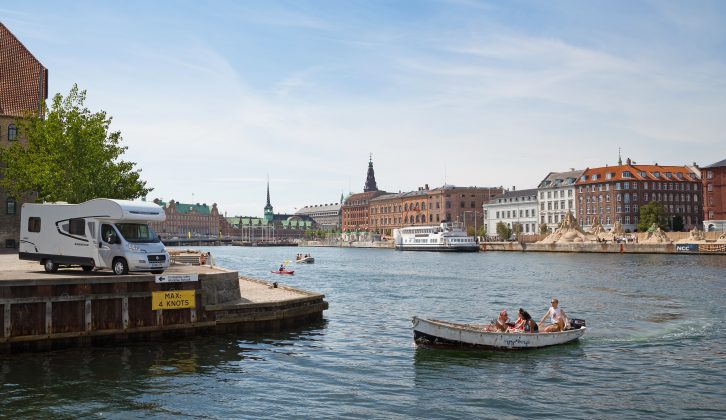
Planning and preparation really are crucial when visiting the region
Things To Do
Drive to ‘the top of the world’, Nordkapp (North Cape) in Norway and look out over the Atlantic and the Arctic Oceans (Norwegian and Barents Seas) at the same time. You’ll have to take a signposted path to the promontory of Knivskjellodden, a 10-mile round trip, if you want to get to Europe’s official most northerly point (inaccessible by road).
Jukkasjärvi is the location of the first, original, Icehotel in Sweden. The hotel is made from blocks of ice carved from the frozen River Torne. Visit in summer and you’ll find the tiny village a peaceful haven, with the beautiful river flowing freely through gigantic lakes.
There may be several across the globe now but there’s nothing quite like the original. Head to the Danish region of Jutland to visit the first Legoland , created in 1968. It was a Dane that invented Lego, after all.
Go to Oslo , visit Stockholm or head for Copenhagen . Which capital should you choose? Visit all three cities and then make your mind up! Each is a waterfront city, with great opportunities for boat trips to nearby islands and districts, and each has a royal residence. Otherwise, they’re distinctly different.
It could take years to explore every last nook and cranny of the Norwegian fjords – the entire western coastline is made up of hundreds of them, from small inlets to deep, incisive cuts that penetrate the hinterland. Select just one and you’ll be blown away by the majesty of the landscape. Sognefjorden is the longest, Lysefjorden one of the most breathtaking, both in the Vestlandet region. But head further north for Trondheimfjorden and the many smaller fjords around the Lofoten and Vesterålen islands. They are no less inspiring.
When To Visit
You’ll find music, film, arts and sporting festivals taking place across Scandinavia throughout the year. But it goes without saying that many events in northern Europe relate to the seasons – and the amount of light available.
Beyond the Arctic Circle there’s continual darkness throughout the day for much of December and January, while ‘The Land of the Midnight Sun’ – 24-hour daylight – applies to the months of June and July. So Svalbard (Norway) celebrates Solfestuke (Sun Party Week) in the first week of March to mark the rising sun, Sweden celebrates Walpurgis Night (30 April) to welcome the spring and Denmark – Copenhagen in particular – goes to town with the Whitsun Carnival in May. Midsummer’s Eve is big in all three countries. The best time to see the Northern Lights is from December to March.
Advent and Christmas are also huge with Christmas markets, concerts and winter festivities – head to Bergen to see a giant gingerbread town (there’s a big rivalry with New York to see who creates the world’s largest each year).
Each country has a national day, when many of the shops may be closed but you’ll find festivities abound: 17 May in Norway; 5 June in Denmark; and 6 June in Sweden.
If you’re planning a trip around school holidays, a reminder that in Norway and Sweden, schools break up for summer in early June and return at the end of August. In Denmark, the summer holidays are from the end of June to mid-August.
Getting There
Unfortunately there are no longer any direct ferries from the UK to Scandinavia, although there are lots from Denmark to Sweden and Norway. To Sweden, select between Frederikshavn to Gothenburg, Grenaa to Varberg or, the shortest, Helsingor to Helsingborg. For Norway there are ferries to Oslo from Copenhagen and Frederikshavn and several routes from Hirtshals, including to Bergen, Kristiansand and Stavangar. It is these ferry routes to Norway that can save motorists the longest drives.
Of course, if you’re touring anyway, it’s as easy to go by land. The quickest driving route beyond Denmark is via the Øresund Link between Copenhagen and Malmö in Sweden. It’s a spectacular drive across the water but be prepared to cough and splutter at the cost.
- Sightseeing
- Holiday park
- Campsite (pitches)
- Motorhome rental in Sweden
- Top 12 must-sees
- Mini trip itinerary 48 hours
- Gamla stan old town
- Royal Palace
- Vasa Museum
- ABBA Museum
- Archipelago sightseeing cruise
- Amphibious bus sightseeing tour
- Classic boat tour under the bridges
- SkyView glass gondola ride
- The Stockholm Pass
- Stockholm hotel deals
- 12 favourite spots
- Haga old town
- Market halls
- Southern archipelago
- Northern archipelago
- Gothenburg hotel deals
- Top 14 must-sees
- Western Harbour and Turning Torso
- Malmöhus Castle
- Malmö Saluhall market hall
- Malmö Live area
- Öresund Bridge viewpoint
- Rundan sightseeing by boat
- Trip to Copenhagen
- Malmö hotel deals
- Outdoor activities
- National parks
- World Heritage sites
- Festivities and holidays
- Good to know (FAQ)
- Tourist season
- Fuel prices
- Currency converter
- Food & drink
- Art & design

Our grand Sweden circle tour – Motorhome trip, road trip
This grand circle tour leads you from Gothenburg to Lake Siljan in Dalarna and then over to the east coast, where you visit Stockholm. The route is approximately 1,800 km long.
You can either begin your journey in Gothenburg or in Helsingborg – depending on which ferry you take and where you arrive with your motorhome. In the description below we start in Gothenburg and drive the circular route in a clockwise direction towards Stockholm.
Gothenburg has two ferry connections to the European continent: Ferries sail to Gothenburg from Fredrikshavn in Denmark and from Kiel in Germany .
The map is best viewed on a desktop computer. You can switch off layers in the map legend area (red checkboxes). Just try it out.
Don’t have a motorhome?
If you don’t have a motorhome, you can rent it from us – fully equipped .
On this route you will find the following attractions (clockwise)
- Gothenburg with the amusement park Liseberg
- Bohuslän with the islands Tjörn and Orust and the city of Uddevalla
- the great Lake Vänern, which you pass on its western side
- Vita Sannar Beach and Vita Sandars Camping in Mellerud, Dalsland
- the Dalsland Canal
- Säffle and the Säffle Canal
- Karlstad, the biggest town in Värmland
- nothern Värmland with Sunne and Torsby (if you like to go cross-country skiing, you can do it here even in summer – there is a ski tunnel in Torsby)
- via Malung you get to Mora by Lake Siljan
- you drive around Lake Siljan and visit Rättvik and Leksand
- Falun, which is a World Heritage site
- then you leave Dalarna and pass through Gävle and Uppsala on your way to Stockholm
- from Stockholm you head back over the E4 mtorway and get a chance to see Nyköping, Norrköping, Linköping, Gränna by Lake Vättern, Jönköping and a part of Småland
- when you arrive in Helsingborg , you can either take the ferry over to Denmark and head home or you could proceed on your route back to Gothenburg
- on your way to Gothenburg you pass Laholm, Halmstad , Falkenberg, Varberg , and Kungsbacka – all located in the province of Halland
Campsites
Pitches for motorhome, caravan or tent. Direct online booking.
Book now: Campsites in southern and central Sweden
Motorhome rental in Gothenburg and Stockholm
You can also rent campervans. They are easy to drive and fun.
Read more: Rent a premium motorhome (RV) in Sweden – With full service – Small motorhomes, large motorhomes
Rental stations in Gothenburg, Stockholm and Luleå.

The Lake Siljan region

Gamla Stan, Stockholm’s old town

Gränna by Lake Vättern in Småland
Related articles
- Lake Vänern circle tour – Motorhome trip, road trip
- Lake Vättern circle tour – Motorhome trip, road trip
Hotels in Sweden
Our route suggestion is primarily intended for tourists with motorhomes/RVs. Of course you can also drive this route in a car and spend the nights in hotels, hostels or B&Bs.
Book now: Hotels, hostels, B&Bs in Sweden

We've helped tourists since 2008 with information about Sweden's best travel destinations. On our site you can also book your next holiday in Sweden. - In cooperation with companies like Booking.com and GetYourGuide. All affiliate links are marked with an arrow symbol.
Follow us on social media
© Copyright 2014 - 2024 Walther Plette, Svenljunga, Sweden
- Cookies, privacy, terms and conditions

Main Phone: 936-327-3428
- Expert Service
- Travel Methods
- Greater Value
- Understanding RV Caravaning
- Defining RV Rallies
- Overseas In An RV
- Terms & Conditions
- Military Discount Program
- Tiffin Owners Discount Program
- Earn Rewards
- e-Newsletter
- Meet the Staff
- Alaska & The Calgary Stampede
- Alaska Adventures
- Alaska & The Canadian Rockies
- The Ultimate Alaska Adventure
- Canada RV Tours
- United States RV Tours
- Mediterranean
- South Africa
- Albuquerque Balloon Fiesta – 7 Day Rally
- Albuquerque Balloon Fiesta – 6 Day Rally
- Christmas in the Ozarks – Branson
- Christmas In The Smokies – Pigeon Forge
- New York City
- Rose Parade
- Washington DC
Travel Insurance
- Catalog Request

Scandinavia
- Destination: Denmark, Europe, Germany, Norway, Overseas Tours, Sweden
- Duration: 29 days
Explore the Scandinavian kingdoms on our exciting RV tour through the land of the midnight sun and legendary Vikings.
Denmark is known for its moated castles and Viking relics, Shakespeare’s ‘Hamlet’ Castle Kronborg, wonderful Copenhagen with its cobblestone streets, and its tidy villages. In Sweden, we travel through dense forests, see glassblowers at work, and tour the amazing capital Stockholm. Then you will experience the fascinating landscapes of Norway with its fjords, mountains, and waterfalls. Marvel at the wooden churches and discover lively cities such as Lillehammer, magnificent Bergen, Oslo, and much more.
We are able to shop with the townspeople and meander the cobblestone streets, as well as visit the major attractions you have heard about for years. We experience guided tours in some of the more popular cities, a vacation we are sure you won’t forget.
Note: Airfare is not included. This option allows you more freedom of movement and a chance to use your frequent flyer miles
Tour Features
– Limited To Only 10 Rigs! Airfare not Included – Rental Motorhome – 20ft.+ Class B+/C – fully equipped – Vehicle Insurance (1500 Euro Deductible) – Transfers – Hotel Accommodations – RV Park Fees (with electricity) – All Meals, Activities, Guides, Tours as listed – Prepaid Road Tolls (cash tolls not included) – Two-Way Family Radio – Professional & Experienced European Field Staff
Click Here to View What is Included In Every Overseas RV Caravan
Total Miles Traveled – 2570 Miles Longest Drive Day – 225 Miles
Photo Gallery
This slideshow requires JavaScript.
Travel insurance may cover your travel investment should the unexpected illness of you, a traveling companion or family member force you to cancel your vacation. To learn more about or purchase Travel insurance click on the image below.

Ron & Pauline C.
Byron & janet w., marvin & dee – gaspe 2019, allan & pat h., ron & martha m..
- Terms of Service
- Privacy Policy
- Aires,Municipals or Commercial Sites
- Swanage Dorset
- South Pembrokeshire Coastal path
- North Pembrokeshire Coastal Path
- Postern Hill
- Damage Barton
- Scarborough
- Forest of Dean
- Hayfield & Crowden
- Aberystwyth
- Cycling in the Saone
- Cycling in The Rhone Valley
- Loire a Velo
- Chateaux a Velo
- Canal du Midi
- The Carmargue
- Narbonne Plage
- Burgundy Canal
- Les Andelys Seine Valley
- Jumieges Seine Valley
- Cycling Mayenne
- Hendaye to Biarritz
- Bayonne to Cap Breton
- Quimper & Concarneau
- La Trinité Sur Mer
- The Gulf of Morbihan
- Neufchâtel En Bray
- Santillana del Mar
- Monfrague National Park
- Donana National Park
- Costa de la Luz
- Cabo de Gata
- Castrojeriz
- San Vicente de la Barquera
- Picos de Europa Cares Gorge
- Potes & Fuente De
- Interlaken Switzerland
- Motor Home Travel Blog
- Oxford Bletchington
- The Downs Link
- Cycling the Kennet & Avon
- The Cuckoo Trail
- Camping in the Forest
- Green Hill Farm
- Peak District
- Glastonbury
- Marriotts Way
- The Strawberry Line
- Romney Marsh
- North Coast 500 By Motorhome
Motorhometrips
with tips for cycling & hiking, scandinavia by motorhome -a motorhome tour of denmark, sweden and norway, based on their three capital cities of copenhagen, stockholm and oslo..
The first thing you have to be aware of is Scandinavia is not cheap and it progressively gets more expensive as you travel from Denmark through Sweden to Norway.
Diesel, however, tends to be cheaper or a very similar price. In Norway, surprise, surprise as you move away from Oslo diesel becomes more expensive and you will find that you are paying more than in the UK.
We took our tip from ‘Europe by Camper’ who recommended that you pack your motorhome with the basic foodstuffs ’ as if you were going to the moon’. This also includes wine and beer as these are prohibitively expensive in Norway.
It must be said, however, that these guys were doing a long tour of Europe, so budgeting was more critical to them.
So if you are coming from Germany, ensure you stock up before entering Denmark. The Danes on the southern border with Germany make a habit of doing their shopping in Germany.
What we were amazed at, is with a little careful reorganisation, how much we could actually pack into our van.
This was the first time that we have ever done this and the prime advantage was that we spent less time on shopping,
only needing to buy fresh produce, which has to be a plus.
We do not propose to suggest what you should take as this is very much a decision based on personal preferences.
Also the decision itself whether to shop in the UK before you leave or to leave it until when you arrive is very much a personal one.
To put a degree of perspective into matters, however, it is possible to find foodstuffs at a reasonable price; even in Norway. You can for example easily pay £3 for a loaf of bread but you can also pick up a perfectly acceptable loaf for less than a £1.
Where it gets expensive is if you want to eat out, particularly in Norway, where you could find yourself paying £20 for a club sandwich.
In Denmark and Sweden it is possible to eat out, particularly at lunch time where you can get a reasonable meal at prices similar to the UK, as long as you avoid the alcohol. Stockholm as is common with all capital cities tends to be more expensive than other cities. We cannot comment on Denmark, as the only city we tackled was Copenhagen.
Coffee in Denmark and Sweden is reasonable, often at lower prices than in the UK and there are always snack deals.
We tend to do all our meals in the motorhome as we find that this is part of the experience and even stopping for a brew, shows the versatility of a motorhome as you enjoy a coffee, often with unbelievable scenery.
Even the Swedes find Norway expensive and before you cross the border there are a number of big supermarkets catering for the trade of the Norwegians as they take advantage of lower prices in Sweden.
You will also have the opportunity to buy diesel here as well.
GETTING THERE AND AROUND
We actually took the ferry from Harwich to Esbjerg with DFDS seaways for two reasons, firstly to avoid the long haul
from Calais through northern Europe and secondly to fit our planned trip into a four week window, as we did not want to miss the English summer.
This is not necessarily the cheapest solution with a return trip in the region of £550 but with an overnight sailing and with a cabin (sleeping accommodation is compulsory) it was pretty painless. The ferry leaves at about 5.00pm and arrives at Esbjerg at 1.00pm the next day.
TIP interestingly it appears that you can get a better deal booking through an agency, rather than with DFDS directly, we used the Camping and Caravanning Club Carefree service.
Food is available on the ship but avoid the café as the food was terrible. A better idea may be is to call into the Morrisons’ supermarket at the port entry and buy a nice picnic.
We cannot comment on the buffet meal in the evening.
Breakfast, however, was superb and though perhaps at 115 Danish Krone £13 was not cheap, it did, however, represent excellent value as it is ‘an eat as much as you like buffet’ and the quality is first class.
Taking the ferry directly to Esbjerg does save you 650 miles driving from Calais, so on a round trip about £300 in diesel so this does make this crossing appear more attractive.
For similar reasons we took the ferry from Kristiansand Norway to Hirsthals Denmark to save the return journey through Southern Norway and Sweden.
We booked directly with Fjord Line and paid 160 euros £138, which for a 2 and a quarter hour crossing was very reasonable.
www.fjordline.com
There are two sailings a day, by fast catamaran, early morning and mid-afternoon and the journey takes 2.25 hours.
TIP : Book early and be flexible. By modifying my day of departure we saved 60 euros.
Western Fjords Norway Ferries.
It is impossible to visit this part of Norway without using the ferries to cross fjords and these are the simple roll on roll off type and you use them on a turn up and go basis.
They are in fact reasonably priced up to 6m in length and then the price increases considerably. The average price we paid was in the region of £23, for a motorhome 7.3m long.
We chose to stay at recognised campsites, bearing in mind that we were on a 4 week holiday and not on a long trip or tight budget.
We chose always to take electricity because our DVD is mains and our heating also, though we do have the option of running it off diesel.
We also refuse to pay for showers so if the site charges then we will use our own. It is a real bugbear of ours that campsites charge extra for showers. It seems a strange economy as all we will do is use their electricity.
We did use Camping Cheques and the ACSI scheme on a few instances which are obviously much cheaper, but on both schemes campsites are not numerous.
Site fees vary, but as a generalisation they were more expensive for City Centre sites,where you would pay £30 plus, the exception being Copenhagen where we used Camping Cheques.
For other sites you would not expect to pay more than in the UK but with the added difference that in Sweden and Denmark you are likely to get much better facilities, particularly with regard to the kitchens, which are often fitted with microwaves, cookers and tea and coffee making facilities, with the added option of a dining area.
Kitchen at the campsite at Granna on Lake Vattern at £20.53 per night would put most UK sites in the shade.
These type of facilities were reasonably typical in Denmark & Sweden and this was a fine example.
Sweden issued its own camping card which you have to pay for at your first site, which cost £15.
Norway and Denmark just required some ID and I tended to use my International Camping Card, which I got free, because I booked my ferry with the Camping & Caravanning Club.
We did not prebook any sites. We did tend to; however, preset the Sat Nav with the campsite for the following day. There were, however, a few occasions where we arrived at a destination on spec.
It is perfectly possible to freecamp in Sweden and Norway, as long as you do not camp on private property. In Denmark it is discouraged but not impossible.
If you want advice on this refer to Europe By Camper.
www.europebycamper.com
These are generally in good condition, the exception being Norway, where I would guess because of adverse winter weather conditions, the roads take a bit of a beating.
This has, however, to be put into perspective as you will not find roads worse than you might experience in the UK. What we did experience is that roads had sunk on the right hand side and in places degraded so you were aware of a distinct groove. This was nothing to worry about but something just to be aware of.
Also you will in places come across roads where there are passing places, route 13 particularly from Kinsarvik, but there is little traffic and we experienced no problems.
We chose to visit in May and early June, leaving the UK on 12th May and returning on 12th June.
On our visit, roads in the Trondheim region had taken a hammering with many roads blocked or they had simply been washed away but thankfully we had not planned to go this far north.
We also planned to hit Norway by the end of May, early June on the basis that the vast majority of the snow would have disappeared, which proved to be correct and though we saw snow and the lakes were still iced over on the high passes, the roads were perfectly passable.
Also the children would still be at school so everywhere would be quiet and additionally we would have the benefits of the longer days. In reality it was still light at 11.30pm.
Low season is great for touring as you have the pick of pitches on the sites, you can turn up when you like and there is much greater flexibility when you can leave.
You should be aware that school holidays start earlier in Norway, from mid-June through to mid-August and this is unsurprisingly when everything gets busier.
Weather is by definition changeable but we were extremely lucky and in 4 weeks we only had 4 days when it rained.
We also use the Snooper Sat Nav, specifically designed for motorhomes, which to date has always kept us out of trouble.
See Snooper Sat Nav Review on this website under Product Reviews
Norway also makes extensive use of tunnels.
What we did find in May and early June was that the roads were very quiet .We would recommend the rural routes in Denmark which are light in traffic and more interesting than the motorways.
In Norway as you leave Oslo and past Gol into the Fjord area you have to be aware that roads become narrower and it takes longer to travel the distances, which you could more easily cover on the straight roads of Denmark and Sweden.
In any case once you are in Norway, it is simply not a case of getting from A to B and there are plenty of opportunities to pull over and enjoy the scenery.
HEADLAMPS - In the whole of Scandinavia you have to drive with dipped headlights all the time and it is somewhat bizarre when you get flashed for not having them on.
I cannot see the point of having them on unless conditions are murky but as in Rome.
The roads in Denmark and Sweden are generally toll free except the two large bridges which connect
1)The islands of Funen and Zealand (we paid £40, half this for a van less than 6m)
2)Denmark to Sweden (we paid £73, again half this for a van less than 6m)
Toll roads and the AutoPASS System in Norway
Norway does use tolls and as a general rule they appear evident when you go into built up areas or it seems when they build a new motorway or tunnel.
I was a little bit nervous of how these would operate but basically they could not be simpler.
On most of them, they use the automatic number recognition system, so you simply drive through.
You will see these cameras clearly above the road.
You can preregister your credit card with them and buy a credit which then gets deducted as you use them but I cannot
see the point of this, as the alternative is to simply drive through and you will get your bill in the post, at no extra charge, at a later date.(I have been told that this can take 6 months.) A Norwegian guy I was talking to at the border thought they did not charge foreigners, I think he could be wrong.
The other toll system has Autopass but additionally a facility to pay manually, either with an automated credit card or via an operator. On these you must not use the Autopass Lane, you must pay manually.
The cutoff for higher payment on these appears to be done by weight, 3.5 tonnes, not sure whether this is, over this weight or includes this weight, we will have to wait and see.
We did not pay a fortune on tolls and the only time they really cheesed me off, and that is the polite version, was when we entered Khristiansand, to get the ferry back to Denmark. There was the automatic toll in front and a 100metres later was the turn off to the port. We should try this, a tax on leaving.
Finally do not forget to take your bikes.
These were particularly useful in Denmark and Sweden for getting to and around the cities. On every city trip, with the exception of Oslo, we used them.
Even in Norway, with more inclines they were great for exploring.
Particularly Denmark but also Sweden is incredibly bike friendly with loads of bike lanes.
There appears to be a whole different attitude to cycling here. Firstly more people do it for non-leisure reasons, you simply have to see the number of cycles stacked up outside stations or experience cycle rush hour in Stockholm to appreciate this.
Secondly there are more designated cycle lanes and in cities, these have their own traffic light system, which is generally obeyed, not like the light hopping in London.
Thirdly where cycle lanes cross minor roads the cyclist has priority, not as in the case of the UK where the cyclist has to give way.
Fourthly and more importantly there is a different attitude from motorists, they are genuinely considerate and tend to always be aware of cyclists and will give way.
This also tends to be the case with respect to pedestrians in all of the 3 countries.
It also helps, particularly in Denmark, that it is relatively flat but be warned if the wind is against you it can be hard work.
All three countries are not in the Euro and have their own currencies, all called the Crown, but not interchangeable.
For all those that have read my article on this website re currency abroad, I try to avoid taking a lot of hard currency with me and this trip was no exception.
Product Reviews: The Best Credit Cards to Use Abroad
In all countries the credit card is widely accepted and was used to pay for all site fees, bar one in Sweden which only accepted cash.
In Norway you can use a credit card anywhere; they are accepted on ferries and buses, perhaps an indicator of the higher expense of living here.
One final point on finance is that in Denmark it is common for a markup to be made on the use of credit cards, typically 3% but I have seen as high as 3.75% . Also I found few places actually warned you of the charge.
There is also no pattern on who levies these, some smaller institutions do not and some larger ones do.
In the grand scheme of things it is not going to cause you a lot of pain but it just annoys me that banks charge more. For years they whinged about the high cost of processing cheques and now these have all but disappeared and replaced by low cost electronic transactions, they still try and rip us off.
mileage given in brackets is the distance from the previous location
Harwich to Esbjerg Denmark with DFDS Seaways, Ribe,(from Esbjerg 20 miles) Trelde Naes near Fredericia in Eastern Jutland on the Vejle Fjord, (52 miles) Copenhagen.(140 miles)
Malmo,(29 miles) then taking the E22 along the southern coast of Sweden to Stockholm via Karlskrona, (127 miles) Kalmar, (55 miles) Nykoping,(195 miles) Stockholm, (63 miles)
Then taking the E04 motorway to Gothenburg via
Granna,(180 miles) on Lake Vattern, Gothenburg,(115 miles)then E06 to Fjallbacka (80 miles)
Continue on E06 to Oslo
via Frederikstad,(60 miles) Oslo,(59 miles) then E16 to Honefoss then the 7 to Gol,(118 miles)
then route 52 and E16 to Laerdal,(64 miles), then the Laerdal tunnel to Flam,(25 miles)
then E16 to Voss and route 13 and ferry Bruravik to Brimnes on to Kinsarvik, (70 miles) continue on route 13 and ferry Nesvik to Hjelmelandsvagen on toPreikestolen,(170 miles)
continue on route 13 and ferry Oanes to Lauvik , continue along 13 and then 44 to Brusand,(48 miles) route 44 and then E39 to Mandal.(100 miles)
Mandal to Kristiansand (27 miles) on E39
Ferry from Kristiansand Norway to Hirsthals Denmark with FjordLine
Skagen,(from Hirsthals 31 miles) route 55 & 11 toThisted,(109 miles) route 11 & 15 to Hvide Sande on Ringkobing Fjord (87 miles)
To Esbjerg (46 miles) route 181
Ferry from Esbjerg to Harwich
- Walking in the UK
- Cycling from Camping & Caravanning Club Sites
- Cycling In France
- Cycling in the UK
Guided RV tours through Europe and the British Isles

More inspiration

Make the Maβen clink at the German Oktoberfest!

Where to go with your motorhome in September?
Camperstops in sweden.

Motorhome-trip through Sweden
A motorhome tour of Sweden is characterised by its vast lakes, its forests, its many moose and its Swedish design. All this makes it a diverse country for a motorhome journey with something for everyone! In the north of the country, with a bit of luck, you can admire the northern lights from your motorhome or go on a husky sled ride. In the south of the country, you can enjoy a walk in the forest and a swim in one of the many lakes. You can also be active during your campervan trip in different parts of the country: cycling, hiking, canoeing, rafting, it's all possible in Sweden! But of course you can also admire the beautiful nature from your campervan or from under the awning.
Free camping is allowed in Sweden. Always ask a landowner for permission if there is one.

Motorhome stopovers in Sweden
With more than 430 camperstops, Sweden is the country to go on a tour with a motorhome. Especially in the south of the country, there are many campervan sites, but also in the north you can easily move around with a motorhome. The capital Stockholm , for example, is a good place to travel by motorhome. The city's sights are best discovered on foot or by bicycle. Especially the latter is a well-known means of transport in Stockholm! So be sure to take the bikes along on your motorhome trip. For those who like to discover the real Swedish nature, there are many motorhome stopovers around Lake Vänern , Sweden's largest lake. Scattered over the rest of the country are camperstops at the most beautiful places in nature, allowing you to discover it in all its splendour!
View the full range of camperstops in Sweden here.

Motorhome routes through Sweden
The Wilderness Way, Vildmarksvägen in Swedish, is one of the most beautiful motorhome routes through Sweden. This 500-kilometre route takes you through the rugged Swedish countryside in a motorhome. You have a good chance of spotting a brown bear here during your motorhome trip, as this is the most densely populated brown bear area in the country! Please note that the motorhome route is only accessible between June and October. On this motorhome route, you can stop frequently for a walk in Sweden's beautiful forested area! The Swedish coastal area of Bohuslän is also a good place for a motorhome tour. The area stretches from Gothenburg to the Norwegian border and is perfect for those who like the flatter Swedish countryside on their campervan tour. Expect plenty of iconic coastal towns, pine forests and beautiful lakes and beaches to take a dip in.
Discover more of Europe
popular destinations, more inspiration.
As a registered user you can make use of all the functionalities of Camperstop.com. Create an account or log in.
- Camping destinations
With the motorhome in Denmark for 1 to 3 weeks
If you decide to take a road trip through Denmark, this lovely Scandinavian country, you’ll travel along picturesque coastal roads to charming towns and breathtaking natural landscapes. With my three route suggestions for a trip duration of 7, 14, and 21 days, I want to make sure that you are optimally prepared for the trip. The finest sights and exciting adventures in Denmark are best experienced when travelling with your RV, so, decide how long you want to be away and let yourself be enchanted by the country’s beauty.
Denmark is a real paradise for motorhome travellers. The small size of the country makes it easy to explore many places in a short time without having to travel long distances. The roads are well developed and the distances between the sights are not long, allowing you to enjoy a stress-free road trip. The enormous variety in the landscape is also what makes Denmark so special. You can wake up by the sea in the morning, and then spend the night at an idyllic forest campsite. That being said, get ready to be inspired, pack your things, get the RV ready, and experience this incredibly relaxing destination on your own.
Subscribe to our newsletter and stay updated
Subscribe to our MyCamper newsletter and get high quality content about camping. Privacy policy
1. Road trip in Denmark for 7 days
If you want your road trip in Denmark to last for seven memorable days, seven days to travel around Denmark, the peninsula Jutland is the best. The infrastructure is excellent and there is a wide range of fantastic campsites. On this route. you will come to beautiful cities, fine beaches, idyllic sand dunes, and even a national park. Jutland offers an exciting mix of culture and wilderness and awaits you with a wealth of attractions. Above all, the short distances between the individual sites are ideal for a seven-day trip.
The best time to travel is from May to October. In summer, you can enjoy sunny bathing weather, while spring and autumn impress with lonely and quiet excursion destinations.

Your tour of Jutland begins in Aarhus, the second-largest city in Denmark. There, you can immerse yourself in the city’s rich culture and history and visit the ARoS art museum or the historic open-air museum Den Gamle By. You can stroll through the charming old town and enjoy dinner at one of the cozy waterfront restaurants.
The next road leads you along the North Sea coast to Skagen. In this special place, the North and Baltic Seas meet, which gives rise to fierce waves. Here, you can visit Grenen, Denmark’s northernmost point, and watch the cute seals on the sandbanks. You can explore the impressive dune landscape of Råbjerg Mile and recharge your batteries with a wonderful walk on the beach.
When heading south, you first pass Voergaard Castle from the 16th century, which is also said to be haunted. You will then arrive in the city of Aalborg, which is known for its modern architecture, cozy old town, and particularly lively cultural scene. How about a street art tour or a visit to the Aalborg Tower with its fantastic view of the city?
The next stage takes you to Thy National Park, which has a lot of nature and wildlife to offer. Many different hiking trails lead through pristine forests and a unique dune landscape. Be sure to bring binoculars to see the many different bird species on the shores and lakes. You might even see the national park’s native deer.
Your journey then continues to Viborg, a city full of historical treasures. There, you can visit the impressive limestone mines of Mønsted, which lie more than 50 meters underground and are considered the largest limestone mines in the world. Other exciting sights include Viborg’s cathedral, Hvolri’s Iron Age village, and the historic road Hærvejen.
You spend your last day of travel in Silkeborg. I recommend experiencing the city from a very special perspective on the historic steamship Hjejlen and be sure to visit the awesome hedge maze. The next day you return to Aarhus, where your trip ends.
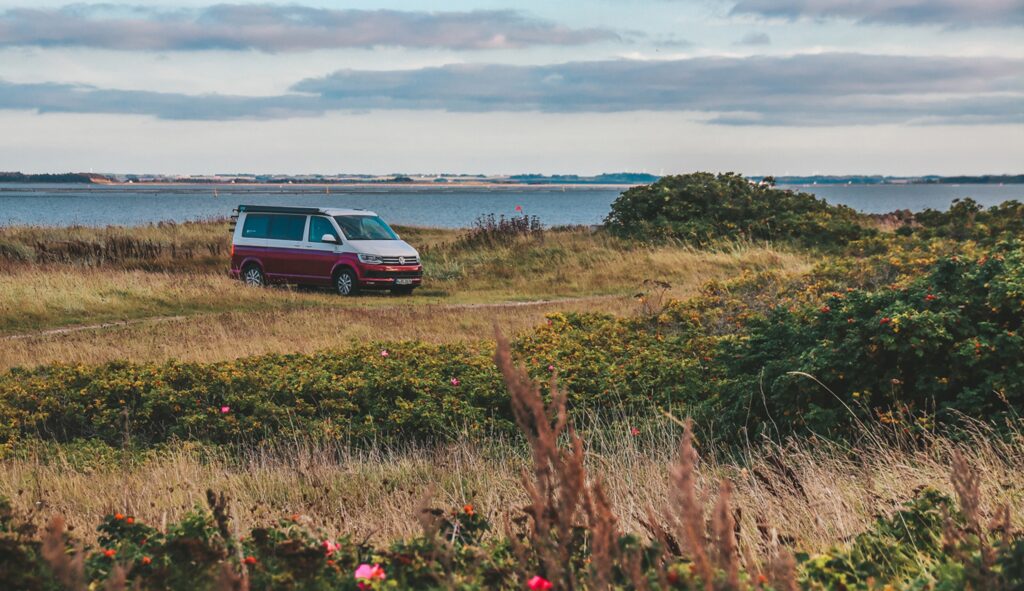
Excursion tips:
In northern Jutland, it is worth stopping at the Rubjerg Knude Lighthouse. The lighthouse is a unique and impressive landmark in Denmark. It lies majestically on Jutland’s North Sea coast and tells a fascinating story. What makes the lighthouse so special is the fact that it has stood steady for the past 100 years, despite the tough climate of the North Sea. By 2019, it literally seemed like the abyss was near, as the sand dune beneath its foundation almost had disappeared. But in a complicated process, the lighthouse was moved 80 meters east to prevent it from falling. Today, it can be safely visited again and represents the raw beauty of nature.
Overview of the route
1st night: Aarhus → 2.5 hours – 230 km 2nd night: Skagen → 1.5 hours – 110 km 3rd night: Aalborg → 1.5 hours – 120 km 4th night: Thy National Park → 1.5 hours – 100 km 5th night: Viborg → 0.5 hours – 40 km 6th night: Silkeborg → 0.5 himme – 45 km 7th night: Aarhus
Total travel time: 8 hours and 645 km
Best time to travel: May – October
Overnight stay nearby or on the road
- DCU-Camping Aarhus – Blommehaven
- CampOne Grenen Strand
- Aalborg Family Camping – Strandparken
- Nystrup Klitmøller Camping & Hytter
- Søhøjlandet’s Camping
Did you know that…
You can find the right motorhome, caravan, or campervan for your camping holiday in Denmark at MyCamper . You can easily rent your motorhome directly in Aarhus, Copenhagen, and many other places in Denmark.
2. Road trip on Bornholm for 7 days
About 40 km south of Skåne in Sweden, lies the small island of Bornholm, which also belongs to Denmark. The island is perfect for a travel time of 7 days, during which you can explore the most beautiful highlights. If you happen to be coming from a camping tour in Sweden, the best way to get there is by ferry from Ystad. Alternatively, if you are coming from the south, you can take the ferry from Køge on the Danish east coast or from the island of Rügen, which is part of Germany.
The journey through Bornholm promises you unforgettable experiences and impressions. From historic castles to picturesque fishing villages to beautiful beaches and untouched nature – Bornholm has something to offer for all travelers. Enjoy every moment of your adventure and let yourself be enchanted by the beauty of this unique island!
With our partner Ferry Center you can easily book your next ferry to Bornholm online.
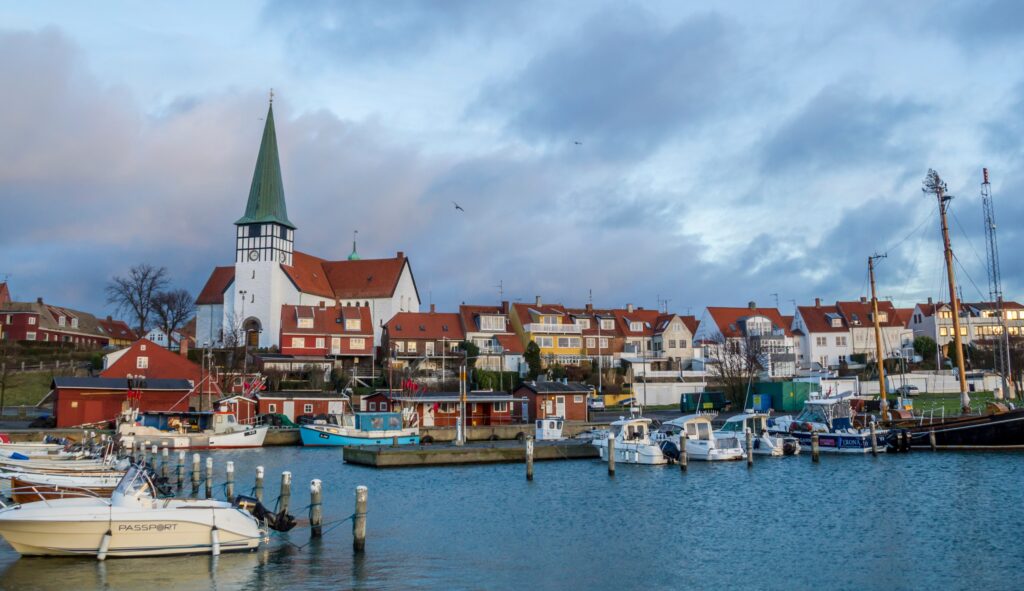
Your journey begins in Rønne, the “capital” of Bornholm. Once there, you can explore the town, visit the marina, and try local delicacies at one of the restaurants. Be sure to pack swimwear and enjoy a refreshing dip at Nørrekås beach or, a little further north, at Antoinette’s beach. The town of Sandvig is located in northern Bornholm, where you will spend the next two days. There you can visit, for example, the Hammeren nature reserve and Opalsee, explore Hammershu’s castle ruins, or idyllic Sandvig beach.
You will then continue to Svaneke via the cute fishing village of Gudhjem, where you can visit the cliffs of Helligdomsklipperne, among other things. The small town is known for its well-preserved and cozy old town and for the candy factory where delicious sweets are made in the traditional way. You can also take a look behind the scenes here and see how the handmade candies are made.
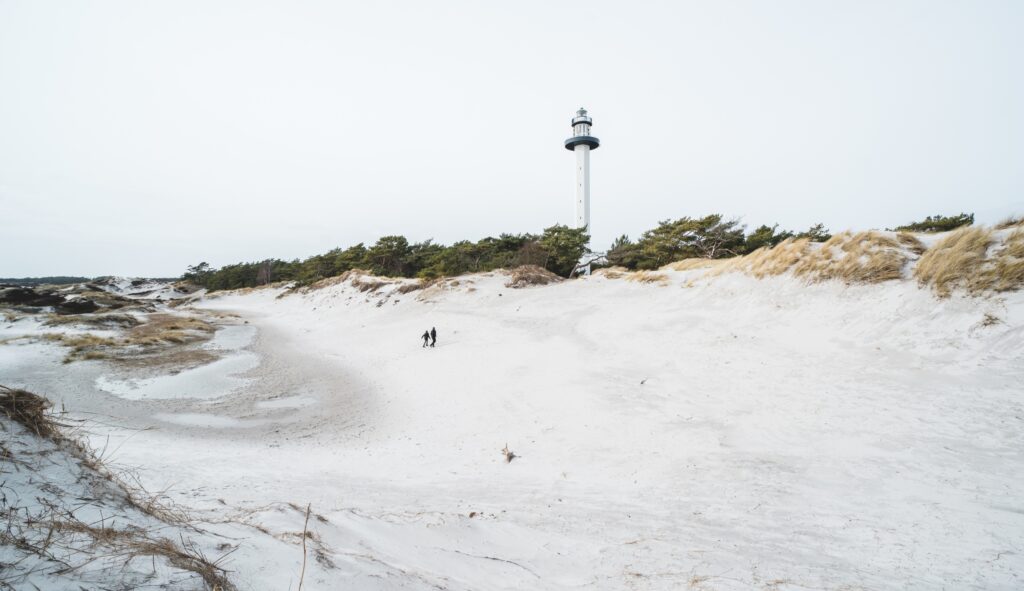
Before your journey continues, you should take at least half a day to explore the forests of Almindingen, located in the middle of the island. There, you can explore nature along the beautiful hiking trails and visit the bison that live here and can move completely naturally and freely over a huge area. The last stage takes you to Nexø and the picturesque beach Dueodde. You won’t believe your eyes when you see the beautiful sand dunes. You will not regret spending a relaxing day between the white sandy beach and the turquoise sea. When you drive back to Rønne, you have driven around the island of Bornholm and will be able to bring many wonderful memories back home.
1st night: Rønne → 0.5 hour – 25 km 2nd – 3rd night: Sandvig → 0.5 hour – 30 km 4th night: Svaneke → 0.5 hour – 20 km 5th – 6th night: Nexø and Dueodde → 0.5 hour – 30 km 7th night: Rønne
Total travel time: 2 hours and 105 km
Best time to travel: June – September
- DCU-Camping Rønne Strand
- Hullehavn Camping
- Dueodde Family Camping
3. Road trip in Denmark for 2 weeks
On a 14-day tour through Denmark, you can explore all of Jutland with its beautiful beaches and tall lighthouses, as well as all the dunes and islands. There are even beaches in Jutland that are so wide that you can drive on them with your motorhome or caravan.
At the same time, you will also discover real insider tips off the beaten track and immerse yourself deeply in the cozy destination of Denmark over a total distance of almost 900 kilometres. This itinerary takes you through a fascinating mix of nature, exciting cities, and picturesque coastlines.

Your adventure begins on the island of Rømø, known for its endless sandy beaches and the beautiful sand dunes that frame the beaches. Enjoy long walks on the beach, try hang gliding, and admire the Wadden Sea. There is also a campsite on the island, from which a morning dip is more or less a must.
Then you reach Esbjerg, a city that combines art and harbor life. Be sure to visit the huge sculpture “Man by the Sea” by Svend Wiig Hansen, which has been welcoming travellers to the coast since 1994. Then, how about an afternoon at the Esbjerg Art Museum or a stroll along the harbor promenade?
Further north, the route takes you to Ringkøbing Fjord, which is separated from the open sea by a 40-kilometer-long narrow sand dune. Here, you will find the small town of Hvide Sande, which is characterized by the breathtaking dune landscape in the surroundings. Just about 5 kilometres further, you will come to Lyngvig Lighthouse and the adjacent sandy beach that invites you to a relaxing day of swimming.
You then continue to Lemvig City. Here, you will find a harbor with charming Scandinavian houses and a lively maritime atmosphere. In addition to a large selection of restaurants and shops for outdoor clothing and equipment, there is also good street food. Delicious pizzas, sandwiches, refreshing drinks, coffee, and ice cream await here.
You will spend the next few days in the Thy National Park, with rich wildlife. Many cycling and hiking trails through untouched forests and sand dunes invite you to explore this amazing place. Here, you can best discover the diversity of birds on the coasts and lakes. Then, you will head along the North Sea coast to Skagen, where the North Sea and the Baltic Sea meet. There, you can visit Grenen, Denmark’s northernmost point, and enjoy the impressive dune landscape of Råbjerg Mile.
After spending two days in the lively city of Aarhus, the route continues to Vejle, where you can experience both nature and a very special urban atmosphere. Visit the 30-hectare deer park, which you can even drive into with your vehicle. Also, many different shops, cafes, and restaurants await you in Vejle’s cozy pedestrian street. If you are interested in Vikings, a trip to the Jellinge Monumenten is recommended, which is less than 15 minutes from Vejle. These are the most important Viking monuments in Europe and have been on the UNESCO World Heritage List since 1994.
Before you say goodbye to Jutland, visit the town of Sønderborg on the southeastern part of the peninsula. Explore Sønderborg Castle, which was built in brick and reveals a lot about the history and culture in the museum. On Sønderborg beach, you can truly relax again while enjoying the view of the Flensburg fjord. Maximize the last time and collect some more unique memories here before heading back home!
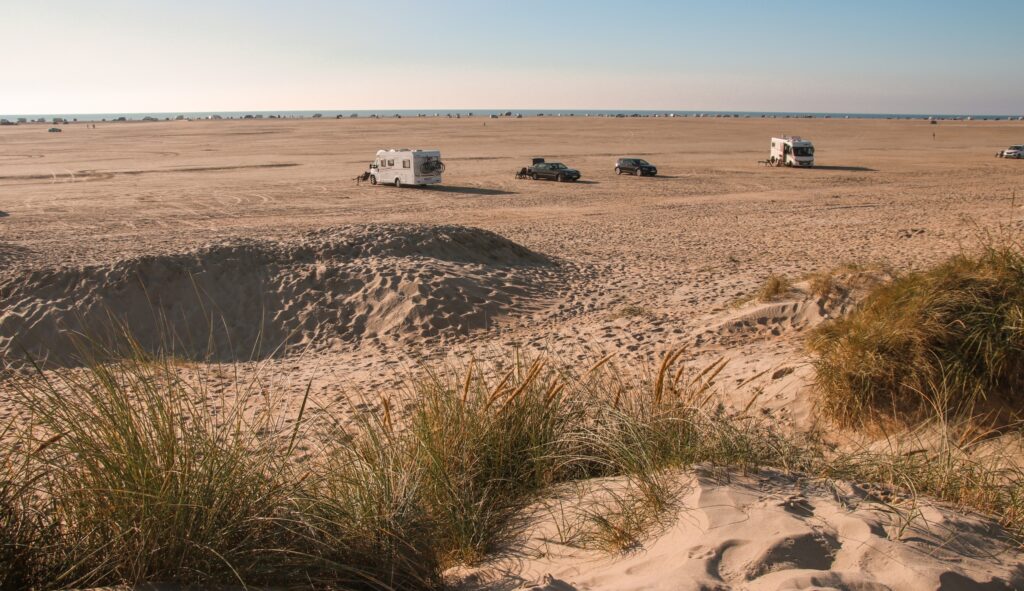
Rømø offers the opportunity to participate in guided mud sea walks. This part of the Wadden Sea in Denmark has now also become part of the UNESCO World Heritage Site. At low tide, you can spot amazing little creatures and learn a lot about the delicate ecosystem. The variety of species is impressive. Here you can find, among other things, unique fish, algae, crabs, birds, and mussels. This excursion is an excellent opportunity to explore nature and the unique environment of the Wadden Sea while understanding why it is so important to protect the area.
1st – 2nd night: Rømø → 1 hour – 70 km 3rd – 4th night: Esbjerg → 1 hour – 70 km 5th night: Hvide Sande → 1 Stunde – 75 km 6th night: Lemvig → 1.5 hours – 90 km 7th – 8th night: Thy National Park → 2.5 hours – 190 km 9th – 10th night: Skagen → 2.5 hours – 220 km 11th – 12th night: Aarhus → 1 hour – 70 km 13th night: Vejle → 1.5 hours – 130 km 14th night: Sønderborg
Total travel time: 12 hours and 915 km
Best time to travel: May – September
- First Camp Lakolk Beach
- Dancamps Nordsø
- Lemvig Strand Camping
- Hagen Strand Camping
- Sønderborg Camping
4. Road trip in Denmark for 3 weeks
Jutland, funen, zealand, møn, falster, and lolland.
This 21-day tour through Denmark will take you all over the country. When you come back home, you will have lots of great memories of beautiful places and sights. This route promises a total of 600 km of unforgettable experiences from the coast of Jutland to the green hills of Funen to the royal castle of Zealand and the idyllic islands of Møn, Falster, and Lolland.
On this trip, you will also get to know the capital Copenhagen. The ideal travel time is between May and September, so it’s a great trip whether you’re most keen to go in late spring, summer, or early autumn.

Three-week road trip in Denmark, now we’re talking! Your adventure begins in Aarhus, Denmark’s second-largest city. I recommend getting to know the city on a walk and taking unique day trips in the surrounding area. Visit the northernmost point in Denmark, hike in Thy National Park, marvel at the shifting dunes of Råbjerg Mile, or climb the Rubjerg Knude Lighthouse.
After three days, your journey continues to Funen, the island where the author and poet HC Andersen was born. Visit his birthplace in Odense and explore the fairytale towns of Middelfart and Svendborg. The green nature and rolling hills of this island will enchant you.
The route then takes you to Zealand, the most populous Danish island, which in Danish is called ‘Själland’. Here, you can visit the impressive Kronborg Castle in Elsinore, which is included in the UNESCO World Heritage List and made famous by Shakespeare’s ‘Hamlet’. Just a 30-minute drive from there you will find the castle Frederiksborg, which has been built directly by a beautiful city lake. You may then continue to Copenhagen, where you can explore the iconic Nyhavn area, royal Amalienborg Castle, and, of course, The Little Mermaid, or “Den lille havfrue” as the Danish people call her.
After that, an impressive natural wonder awaits you on the island of Møn. When having crossed the cute village of Stege, you reach the spectacular white cliffs of Møns Klint cliffs. You can walk along the cliffs and enjoy the breathtaking view. A beautifully designed wooden walkway and a staircase with 497 steps then lead you all the way down to the shore of the Baltic Sea. There is also an interesting exhibition in the GeoCenter with many attractions and lots of interesting facts about geography.
You will then continue to the island of Falster. Explore the charming harbor town of Nykøbing and visit, for example, the Museum Obscurum, which houses many eerie and strange finds from around the world. Relax on Gedesby Strand in the south or on Bøtø Strand in Marielyst and enjoy the tranquility of this idyllic island.
The last part of the trip takes you to the island of Lolland. Here, you definitely cannot miss ‘Dodekalitten’. This is a monument consisting of 12 stone figures carved in granite that are 7 – 9 m high and weigh 25 – 45 tons each. The artwork is arranged in a circle and is a real highlight. You can enjoy one last sunset at the breathtakingly beautiful Albuen Beach or at Nybølle Beach before it’s time to wrap up your road trip.
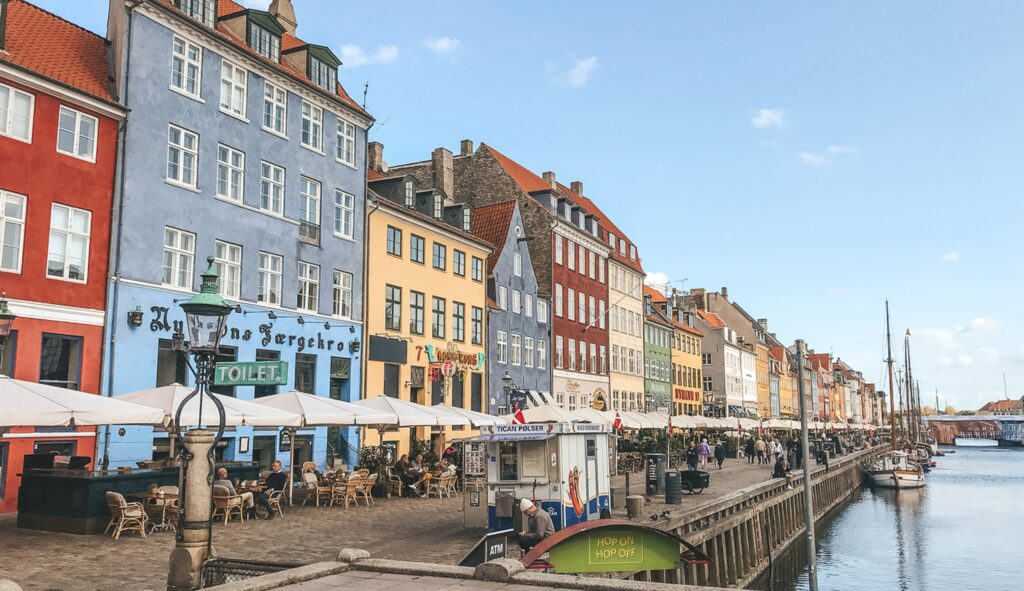
The island of Langeland is connected to Funen by a bridge and is perfect for a day trip. Visit the idyllic village of Rudkøbing with its many colorful houses or explore the exciting Ristinge Klint cliffs. The island’s west coast is rich in highlights in the middle of nature. In Tryggelev Nor’s bird reserve, you can get to know Langeland’s biological diversity. Finally, Hesselbjerg Beach or Dovns Klint’s cliffs are fantastic places to visit in the evening light.
1st – 4th night: Aarhus → 1.5 hours – 150 km 5th – 8th night: Funen → 2 hours – 170 km 9th – 12th night: Zealand with Copenhagen → 2 hours – 140 km 13th – 14th night: Møn → 1 hour – 70 km 15th – 17th night: Falster → 1 hour – 60 km 18th – 21st night.: Lolland
Total travel time: 7.5 hours and 590 km
- Køge & Vallo Camping
- Taarup Strand Camping
- Camp Møns Klint
- Marielyst Nycamping
- Bandholm Ställplats
5. Final words before your Denmark tour
For your next camping holiday, I recommend travelling through Denmark. In my guide, you will find suitable road trips regardless of whether you plan to be away for 1 week, 2 weeks, or 3 weeks. Right from the start of your trip, you will experience Denmark’s ‘hygge’ (coziness) and beautiful nature up close and then, along the route, get to know the many beautiful places that await you.
As you can see, I have made a special itinerary for the island of Bornholm. You can either travel here on its own or combine the Bornholm holiday with another route through Denmark if you want to spend more time on your camping trip. To fulfill your own wishes, you can copy these routes and sights directly, or be inspired by tips here and there. Having said that, I wish you a fantastic trip to Denmark – I’m sure you’ll bring home wonderful memories!
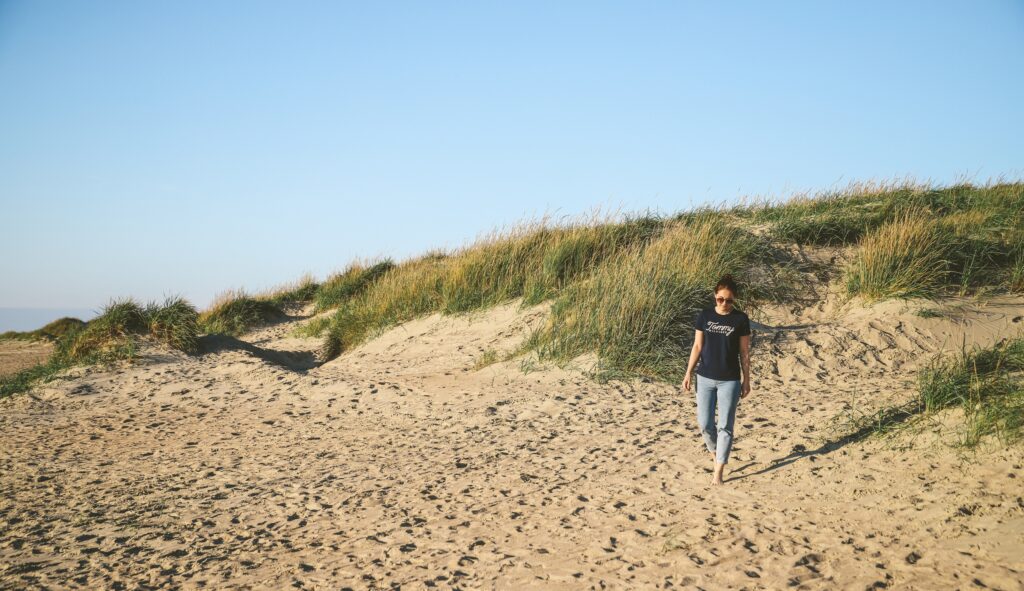
Popular camping vehicles
Your ride to adventure. Rent it.
Renting and renting out
- Become an owner
- Rent a motorhome
- Rent a caravan
- 23 65 33 70
- [email protected]
- Help center
- © 2024 MyCamper AG
- Terms of use
- Privacy policy
- Company details
- Change cookie consent

Campervanning in Norway: Tips, Routes & Destinations for 2024
This post may contain affiliate links, from which we earn an income. Click here to read our affiliate policy.
Your complete guide to touring Norway in a motorhome
A truly beautiful country, Norway is a real bucket list destination. Mountains, glaciers and waterfalls appear around every corner and vast areas of wilderness and national parks wait to be explored. If you love adventure and raw nature, then campervanning in Norway is for you.
One of our favourite European countries for a campervan road trip, driving in Norway means big sweeping roads, exciting mountain passes and regular fjord crossings, as well as plentiful off-grid camping and outdoor activities.
We’ve spent months motorhoming in Norway and our advice and tips for motorhoming in this Nordic country come from our own lived experience. We cover driving, budgeting, where to stay overnight and off-grid and wild camping, motorhome and camper van services and a round-up of the best motorhome destinations. In fact, you’ll find all the information you need for an amazing Norwegian adventure!
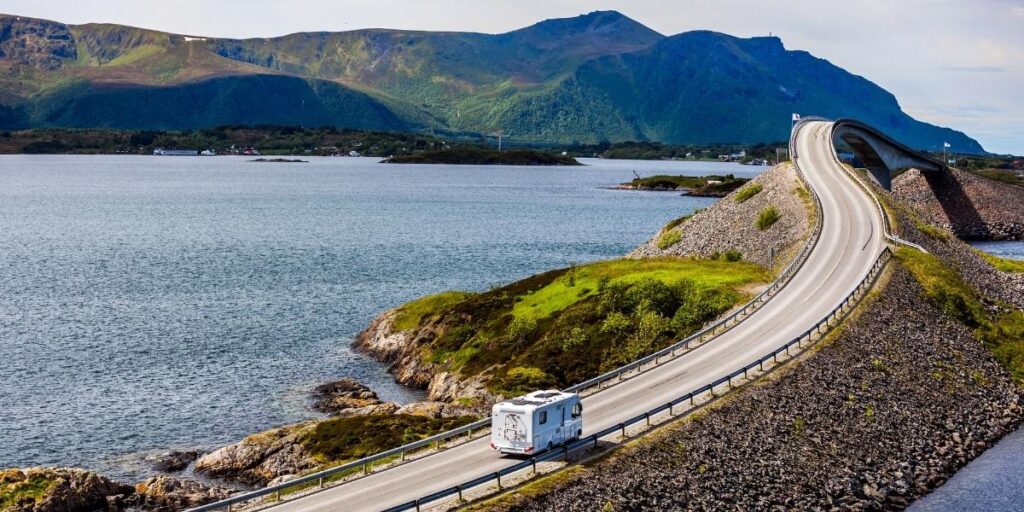
Norway Motorhome Routes
Getting from the UK to Norway in a campervan is possibly the most challenging part of planning a Norway motorhome trip!
There are so many options, but at some point, you’ve got to get your campervan over the water, it’s just a matter of how you do it and how much it costs!
These are the best Norway motorhome routes:
The Bridges
This route involves taking the Storebaelt Bridge (Great Belt Bridge) in Denmark en route to Copenhagen and then crossing the Oresund Bridge (of BBC The Bridge fame) from Copenhagen to Malmo in Sweden.
This option gives you the opportunity to road trip Denmark and see beautiful Copenhagen on the way through and experience both incredible bridges, their views and architecture. But, it’s not cheap and you still have the long six hour drive up the coast of Sweden.
Toll operators in Norway work with the bridge operators to provide discounts if you use electronic tags. Check the Tolls section below to find out more.
Storebaelt Bridge
(2024 prices for a one-way crossing)
- Up to 6m <3500kg = 275 DKK / 196 DKK discounted price
- Over 6m <3500kg = 620 DKK / 589 DKK discounted price
- Under 10m >3500kg = 620 DKK / 589 DKK discounted price
- Over 10m >3500kg = 985 DKK / 936 DKK discounted price
Oresund Bridge
- Between 6-10m = €119 / €55 discounted price
- Over 10m = €221 / €97.90 discounted price
- Over 6m + trailer = €221 / €97.50 discounted price
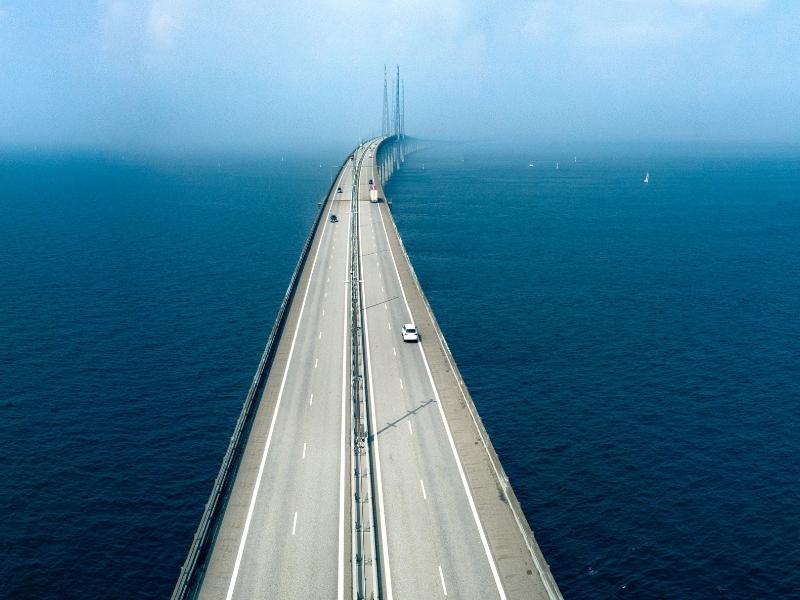
Is this your first time visiting Norway? Get all the information you need in our Norway Travel Guide , including what to pack, the best time of year to go, getting there and practical tips to help you have the best trip!
The Ferries
There are so many options here, although sadly there is no longer an England to Norway ferry.
Ferries from Denmark to Norway
Getting a direct ferry to Norway from Denmark avoids the bridges and the long drive up the Swedish coast. Popular Color Line ferries from Denmark to Norway are from Frederikshavn to Oslo, Hirtshals to Kristiansand, Larvik, Stavanger and Bergen.
The longer crossings are not prohibitively expensive and sailing to Bergen gets you right into the beautiful western Fjords – balanced against fuel and toll costs, it may be worth considering.
Ferries from Germany to Norway
From Travemunde to the northeast of Hamburg, a nine hour crossing gets you into Malmo, costing at least 50% less than taking the bridge’s route, and you can stop and see Hamburg on the way!
You still have the six hour drive up through Gothenburg to Oslo and will miss the wonders of Copenhagen, but for those on a budget, this is a great option.
Ferries from the Netherlands to Norway
Holland Norway Lines has introduced a new route from Eemshaven in the north of the Netherlands to Kristiansand. With three 18 hour crossings a week each way, you’ll arrive at 9am the next day feeling refreshed and ready to drive in whichever direction takes your fancy.
This cuts around 1000km of driving from the route and is a great option if you are planning to visit the western fjords and southern Norway, or if you’re planning to sail from the UK to the Netherlands.
We recommend finding the best deals and crossings with Direct Ferries , who make it easier to compare timings, routes and costs in one place.
The Alternative Campervan Route to Norway
If you have a lot of time, a ‘reverse’ route through Scandinavia could work. What we mean by this is to not follow the usual routes into Norway which most people take because they are time-limited, but take a ferry from Tallinn in Estonia to Helsinki in Finland, or Stockholm in Sweden, and then drive north and east until you get into Norway.
It’s a bit more complicated than that but you get the idea. There are worse things than travelling around Scandinavia in a campervan!
Looking for more driving routes to Norway? Our driving from the United Kingdom to Norway guide has eight options for getting to Norway , so you can find the perfect route.
Motorhome & Campervan Rental Norway
Flying and hiring a motorhome is the best way to tour Norway if you don’t own one. Our recommended Norway campervan rental company is Motorhome Republic , which has depots in Oslo, Bergen, Tromsø and many other major Norwegian cities – perfect starting points to see all the best bits as you road trip Norway .
An aggregate motorhome and campervan booking site, Motorhome Republic pull together all the best deals from a number of rental companies, like Indie Campers, Campervan Norway, Arctic Camper and Cabin Campers to offer you a wide choice of options alongside an excellent English-speaking expert motorhome Concierge Team.
You can also hire a motorhome in the UK and drive it across to Norway. Most hire companies allow their motorhome rentals to be taken overseas, including our recommended rental company, Spaceship Rentals . With a depot in London, top-notch customer service and all the equipment you need for an easy holiday, Spaceship offers the best deals for Europe.
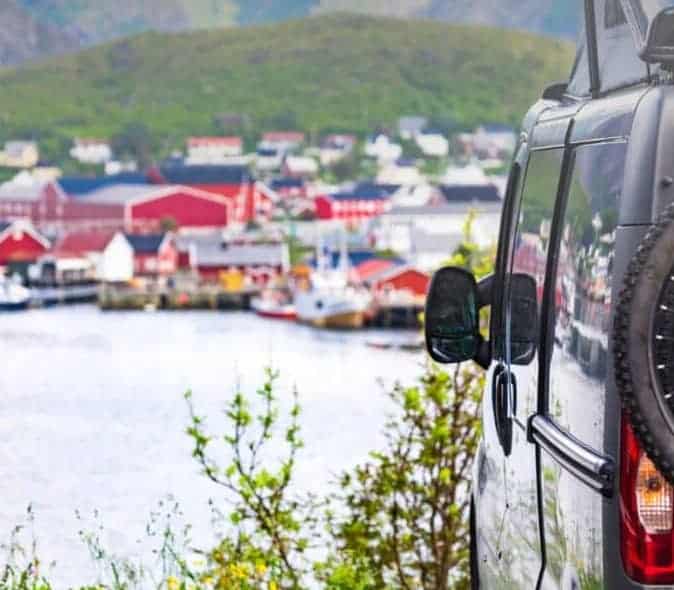
Best Time to Motorhome in Norway
October to april.
Can you take a campervan to Norway in winter? Absolutely you can but it will be cold wherever you go, and there’s likely to be snow… possibly quite a lot of snow, although the Scandinavians are really good at managing adverse weather conditions, so main roads do stay open.
November, December and January are dark months in the north of the country, and from November 27th until 15th January the polar night occurs when night-time lasts for 24 hours. Outside of these times, daylight hours are very short with maybe only a few hours of light.
Many campsites will close in winter, but if you’re travelling to Norway for winter sports or to see the Northern Lights, this is the perfect time.
It’s a good idea to make sure you’re well prepared with adequate heating and power in your van, and snow chains or tyres for when conditions require them. You’ll also need lots of warm clothing and thermal layers to keep you warm!
May to September
Campervanning Norway in the summer means the weather will be kinder, with July and August being the warmest months. Fjord swimming without a wetsuit is possible in the peak season and you’ll be comfortable during the day in shorts and a T-shirt. It can still be chilly in the evenings for Arctic campers, where the weather is also more unpredictable.
Between the end of May and the end of July, you’ll experience the midnight sun phenomenon in the far north of Norway, when the sun remains visible at the local midnight and moves across the horizon from left to right.
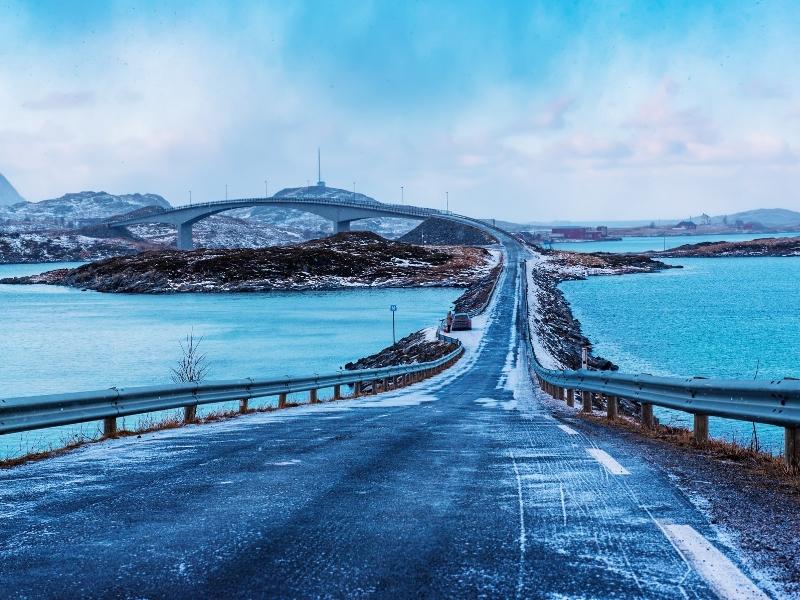
Norway’s Borders
Norway is not a member state of the European Union. However, it is associated with the Union through its membership of the European Economic Area (EEA) and is an associate member of the Schengen Area, meaning you must include Norway in your 90 in 180 days calculation.
Norway has open borders with Sweden and Finland, however, they still practice random border checks at some popular road crossings. You will find a ‘hard’ border if you arrive in Norway by ferry, and will need to complete a customs declaration form before you enter the country.
Many motorhomers travelling north through Sweden from the ferry will cross the border at Svinesund on the E6, where there is a permanent customs post. There is often queueing traffic to cross, although not many vehicles are actually stopped or searched.
The allowance for alcohol is small (1L of spirits over 22% volume, 1.5L wine less than 22% volume and 2L of beer up to 4.7% volume) and given the cost of buying booze in Norway, it’s tempting to stock up at the large supermarket in Sweden just before the Norwegian border. If you do get caught carrying more than your allowance, the fines can be large.
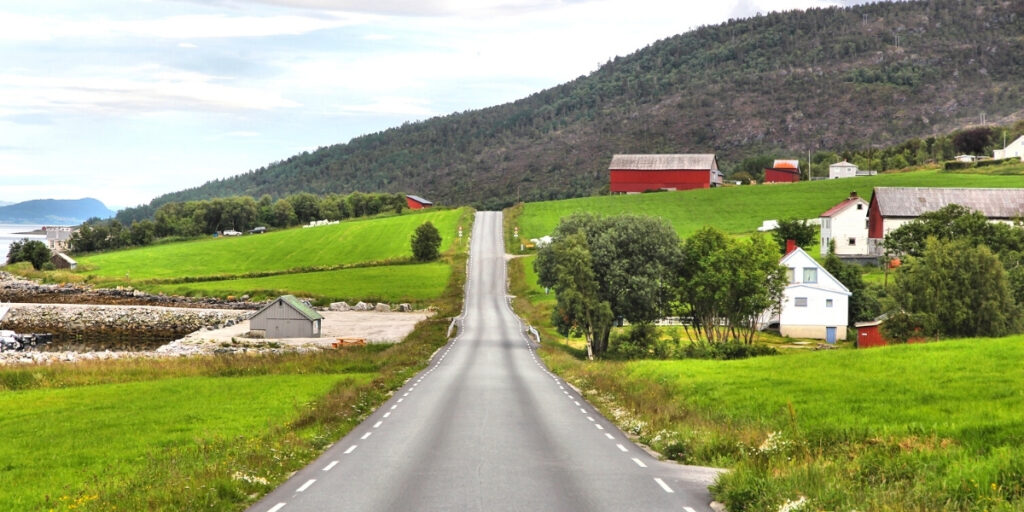
Motorhome Norway & Brexit
Although the UK left the EU at the beginning of 2020, because the pandemic came swiftly on its heels, many of us are still realising the repercussions and getting used to how it affects travelling in a motorhome. You can find out all the details you need in our guide to motorhoming in Europe after Brexit . In the meantime, here are a few frequently asked questions and answers;
Do I need a visa for Europe?
Nothing changes with your passport, but from 2025, the EU will introduce the ETIAS (European Travel Information and Authorisation System), which will be an additional entry requirement for visa-exempt travellers and will involve the traveller registering their details online before travelling, mainly for security purposes.
How long can I stay in Norway?
UK citizens can only stay in the Schengen Area (a zone in Europe where countries have no internal borders and allow the free and unrestricted movement of people) for 90 days in every 180 days in the Schengen Area, of which Norway is a member.
The 90 in 180 day rule works on a rolling basis and it can be difficult to work out whether you are within the rules or not, especially if you have visited the Schengen area on several occasions in the preceding 180 days. Use a Schengen calculator to ensure that you stick to the right number of days and stay within the rules.
What food can I take in my motorhome to Norway?
The European Commission says the following:
- Travellers are not allowed to bring in meat , milk or their products .
- There is an exemption for powdered infant milk, infant food, and special foods or special pet feed required for medical reasons if weighing less than 2kg and provided that: such products do not require refrigeration before opening, that they are packaged proprietary brand products for direct sale to the final consumer, and the packaging is unbroken unless in current use.
- For fishery products (including fish and certain shellfish such as prawns, lobsters, dead mussels and dead oysters), travellers are allowed to bring in up to 20kg or the weight of one fish if this is higher.
- For other animal products , such as honey, live oysters, live mussels and snails, travellers are allowed to bring in up to 2kg.
Can I use my mobile data in Norway?
It very much depends on who your mobile phone contract is with and when you started the contract. All UK providers now limit data usage in the EU in some way or another, and it’s best to check with your provider to make sure you don’t run up a big bill. You can find lots of information in our guide to the best SIM cards in Europe , especially if you’re planning to be away for more than a few weeks.
We have been using and recommend ConnectPls for cloud SIM connectivity in the UK and Europe. You can choose from unlimited data packs to just single days, depending on your needs. The device is no larger than a slimline smartphone, connects with up to ten devices, is charged easily with a USB and can be delivered within a few days of ordering. Use the code ‘thegapdecaders’ at checkout to get 50% off in the first month!
RELATED POST: Best EU SIM Card for Long Term Travel & Digital Nomads
Can I take a pet to Norway in my motorhome?
Yes, you can take dogs, cats and ferrets to Norway. You’ll need to book a pet-friendly cabin or kennels on the ferry or travel via the tunnel from the UK. Your pet will need a microchip, a valid rabies vaccination and an animal health certificate (AHC).
When pets are travelling to Norway from countries in the EU/EEA (such as Germany or Denmark) the animal and necessary documentation must be presented to Norwegian Customs for checking. Walk or drive through the red zone in the Customs area to present your paperwork and pet.
When travelling to Norway from Sweden, the animal and documentation need not be shown to the Norwegian Customs if the animal has been kept legally in Sweden and meets all requirements for entry.
It can take some time to get all the documents together and the vaccines organised, so make sure you start the process well in advance.
More campervan travel advice and guides
- Hiring a Motorhome: Everything You Need to Know!
- Europe by Motorhome: The Best & Only Touring Guide You Need!
- Motorhome Sat Navs: Best Models & Options for 2024
- The Best European Campsites – For Camper, By Campers
- Europe Motorhome Holidays – Ideas & Destinations
- 29 of the Best Van Apps – Free & Downloadable Now!
- Motorhoming Tips for Beginners: Essential Know How for Motorhome Life
Is Norway Expensive to Visit?
Why is Norway so expensive? Norwegians enjoy a very high standard of living and are generally paid well, which in turn pushes up prices. There is no escaping that for foreigners, this is an expensive country and travelling in a campervan in Norway requires careful planning. Follow our Norway advice and travel tips to budget as effectively as possible.
Norway Prices & Tips
- Norway does not use the Euro but maintains its own currency, the Norwegian Krone, shown as NKR.
- Norway’s camping prices are similar to the rest of Europe in summer, although cheaper than the super-tourist areas of the Mediterranean, for example. We paid anywhere between NKR250-400 a night, including electricity. You normally have to pay extra for a hot shower, typically NKR30-40 for five minutes. Aires will cost around NKR130-200 a night.
- Fuel costs are similar or slightly higher than the UK, but considerably cheaper than France or Italy. Norway is regularly in the top ten most expensive countries in the world for both petrol and diesel. You can check global fuel prices here .
- Alcohol is really expensive. A beer, cider or glass of wine in a restaurant will cost between NKR90-120. In a Vinmonopolet (government-owned alcoholic beverage retailer and the only company allowed to sell beverages containing an alcohol content higher than 4.75% in Norway) you will pay around NKR180 for a bottle of wine and NKR70 for beer and cider. Spirits cost considerably more, so we just didn’t drink them and enjoyed happy travels anyway!
- Norway food and drink prices vary – try to shop in the Spar or Co-op. There is no Lidl or Aldi, or their equivalent, in Norway (Lidl opened around six years ago, lasted two years and shut up shop!). Some food prices, like tinned and dried goods, are similar to the UK but fresh fruit, vegetables, fish, cheese and US products such as Coca-Cola are expensive in comparison. Local produce like salmon and goat’s cheese is expensive in tourist areas.
- Eating out is costly. We ate out a few times and on one occasion paid NKR700 for two pizzas, burger and chips, two beers and a coke – that’s a €65 fast food dinner!
- Activities are about 20% more expensive per person than in the UK. There are lots and lots of free hiking and cycling routes and swimming opportunities wherever you go to help you save money.
- Norway touring toll and ferry costs are quite high but it is almost impossible to avoid them! You can go onto the AutoPass website and attempt to calculate your road trip route in Norway but I wish you luck, it defeated us!
- If you can avoid the high season in mid-June to mid-August, some things like activities, motorhome rentals and campsites may be cheaper.
Average Cost of a Trip to Norway
It is impossible to say what the average cost of a trip to Norway is. There are so many variables such as length of trip, size of your campervan or motorhome, how you like to camp and which route you will take to Norway.
How expensive is Norway compared to the UK? Our experience suggests that the cost of visiting Norway is around a third more expensive than the UK or France, with our average daily spending money in Norway coming in at €65 a day.
Yep, it’s expensive to road trip Norway, but budget carefully and it’s no more expensive than France or Switzerland.
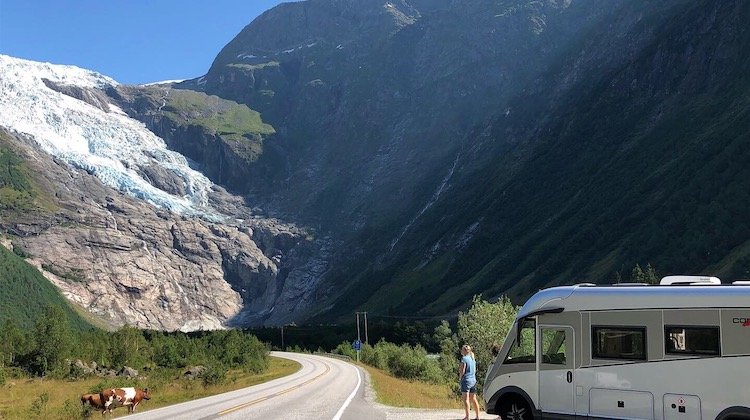
Documents You Need to Travel in Norway
- You must have at least three months remaining on your passport (issued in the past ten years) at your intended date of departure from Norway.
- You must have at least 3rd party insurance for your vehicle. Update August 2021 – you no longer require a green card to prove you have vehicle insurance cover when travelling in Norway.
- Your UK licence allows you to drive in all EU countries. If you only have a paper driving licence or a licence issued in Gibraltar, Guernsey, Jersey or the Isle of Man then you will need an International Driving Permit .
- Breakdown cover documentation (not compulsory).
- Vehicle V5 logbook or vehicle registration document (which must show your correct address).
- Trailer certification if you are towing.
- Personal travel and medical insurance. The GHIC card can be used in Norway but it won’t cover you for anything other than an emergency.
Make sure you have travel insurance you can trust when motorhoming Norway. We recommend True Traveller for their 5-star TrustPilot reviews, variety of cover options, best activities cover as standard, great prices and excellent service.
Motorhome Driving in Norway
Driving in Norway is a real pleasure. Norwegian drivers are usually disciplined and calm, happy to give way and wait where necessary. The road network is well maintained, even on smaller ‘B’ type roads, and often we drove long distances without seeing other vehicles, although expect roads around popular tourist attractions to be busy.
Western Norway is also home to an immense network of road tunnels which have mostly replaced the old fjord-side single-track narrow roads. These older Norwegian roads can be a bit narrow and tight so drive with caution, especially if you’re in a new motorhome, as you will meet lots of other large oncoming traffic.
Norway’s tunnels are legendary – well-lit, beautifully sealed and some even have roundabouts in them! Norway is also home to the Laerdal Tunnel, or Lærdalstunnelen , at 15 miles it’s the longest road tunnel in the world!
Do not underestimate how difficult and time-consuming it is to travel around Norway in a campervan, especially if you want to go to remote areas, north enough to see the Aurora Borealis or enter the Arctic Circle. It takes a whopping 30 hours of solid driving from the Lofoten Islands to Oslo for example .
One thing every road-tripper we talked to said was that they had not given themselves enough time to explore the country fully. Do your research and plan carefully, it will always take longer than you think.
Motorhome Speed Limits in Norway
Always observe the speed limits when campervanning in Europe . There are speed cameras just as in the UK, and the Norwegian authorities are pretty vigorous in their pursuit of people caught speeding and the non-payment of fines. This has not changed since Brexit as the information-sharing agreement with the DVLA continues.
Motorhomes < 3,500 kg
- Residential areas: 30 km/h
- Other built-up areas: 50 km/h
- Rural roads: 80 km/h
- Motorways: 100 km/h
Motorhomes > 3,500 kg
- Motorways: 80 km/h
Norway Rules of the Road
- A UK and EEA driving license allows you to drive in Norway. If you only have a paper driving licence or a licence issued in Gibraltar, Guernsey, Jersey or the Isle of Man then you will need an International Driving Permit .
- If your driving licence does not have a photo, is written in an alphabet other than the Latin alphabet, such as Arabic, Cyrillic or Japanese, or the categories on your driving licence are different from the international categories pursuant to the Geneva or Vienna Convention, then you will need an IDP. You can find out more here .
- From 28th September 2021, UK registered vehicles will have to display a UK sticker on the rear of your vehicle, instead of a GB sticker, unless you have a new style UK numberplate which displays the Union Jack flag. All vehicles are required to display their county identifier.
- Your headlights must be adapted for driving on the right.
- You must drive with the low beam lights on all year long, even in the midnight sun season.
- You must carry a warning triangle and a reflective jacket when you’re taking a road trip in Norway, the latter is not compulsory but highly recommended.
- It is recommended that you carry spare bulbs for your motorhome or campervan’s external lights, a fire extinguisher and a first-aid kit.
- Motorhomes over 3,500kg and vehicles towing caravans or trailers must not exceed 80km/h regardless of the local limit. If the caravan or trailer is not equipped with brakes, the maximum speed is 60km/h.
- It may seem obvious and apologies if you know this, just doing my bit to keep you safe!! Brakes may overheat on long downhill stretches – to avoid this, drive in low gear. Eventual braking will require less force and brakes will stay cool.
- When driving uphill, watch the motorhome’s temperature gauge to avoid engine overheating in time. You will go up and down a lot of mountains, especially if you take on the Trollstigen road, one of Norway’s best driving roads.
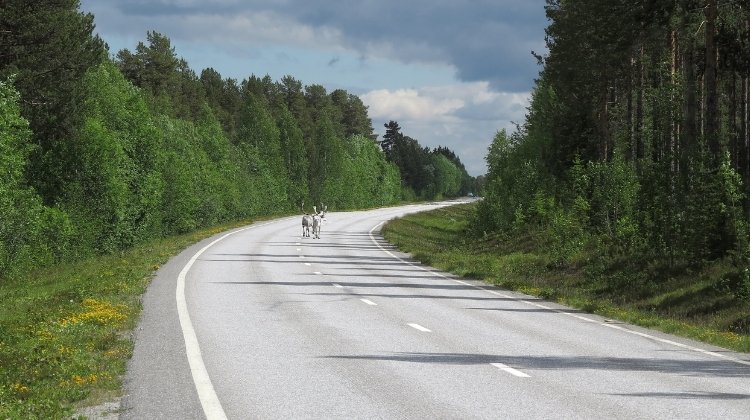
Winter Driving in Norway
Many more people are choosing to motorhome in Norway during the coldest months but if you’re not an experienced motorhomer or have no experience of driving on snow and ice, a summer road trip in Norway is definitely preferable (and a whole lot warmer!). You may also find the additional costs of winter tyres prohibitive.
Luckily, the Scandinavian countries have the right infrastructure to manage snow on their roads. Snow ploughs keep the main routes open in cities and around the country, but some of the Norwegian Scenic Routes and high passes will be closed. You can check driving situations and conditions in Norway here .
If you do decide on a winter road trip, you need to make sure your vehicle is prepared and you have the right equipment:
- Winter tires are a legal requirement and it would be impossible to drive in the winter without them. As the driver, you are responsible for ensuring that the vehicle you are driving has sufficient road grip, all year round. You may be asked to purchase a set if you cannot evidence to the border police that you have them.
- When winter tyres are used they must be fitted on all four wheels and must have a minimum tread depth of 3mm between 1st November and the first Sunday after Easter Monday.
- A vehicle with a maximum authorised mass of more than 3,500 kg must have winter tyres of the ‘3 peak mountain snowflake’ type on drive axles and front steering axles. On other axles, you can use tyres of the type ‘mud and snow’ or ‘3 peak mountain snowflake’. These tyres are mandatory between 15th November to 31st March.
- You must have a tread depth of at least 5mm on tyres for vehicles over 3,500 kg between 1 November and the first Sunday after Easter Monday. In Nordland, Troms and Finnmark, a tread depth of at least 5 mm is required between 16 October and 30 April.
- If your motorhome weighs less than 7,500kgs you do not need to carry snow chains in addition to using winter tires. Otherwise, you must carry chains if you expect to be driving on snowy or icy roads during the 5mm tread depth period.
- Ensure that your engine cooling system has the required level of antifreeze for Norway’s very low winter temperatures.
- You’ll also need antifreeze in your windscreen washer bottle.
- Carry an ice scraper, shovel, and plenty of warm clothing.
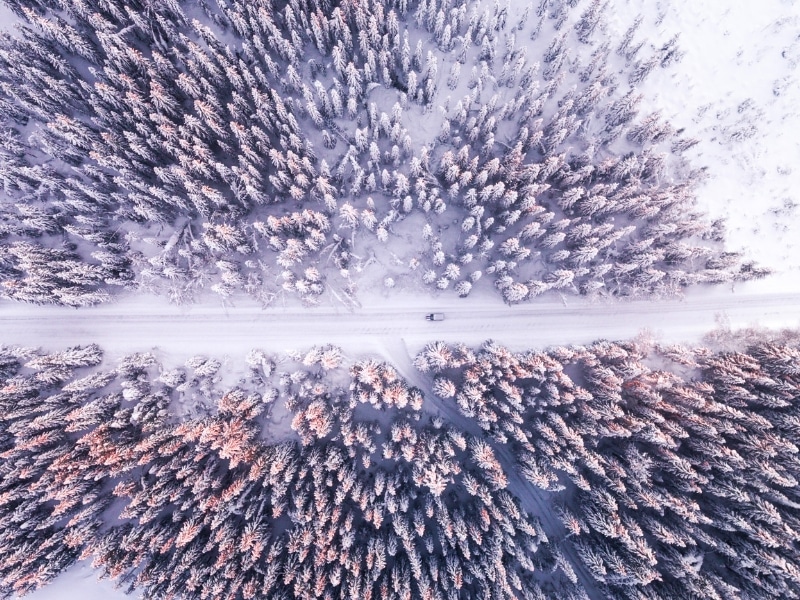
Road Tolls in Norway
There is a sophisticated and comprehensive toll system in Norway. You will know you’re on a toll road by the road signs of a camera and wifi, but it’s safe to assume if you’re on a major main road, it will be a toll road.
Now it starts to get complicated! The system is not straightforward but this is what you need to do in advance of touring Norway by motorhome or campervan:
- Register your campervan or motorhome for electronic tolls with one of the AutoPASS-authorised providers. Head to the section entitled ‘register a payment account for your foreign vehicle’. Leave plenty of time for this step, so your electronic toll tag can arrive in the post.
- Flyt is one of the user-friendly options on the list and we would recommend them. Their tag covers you for toll roads, bridges, tunnels and some fjord ferries in Norway and you are invoiced by email monthly in arrears.
- If you want an electronic tag to cover you for Sweden and Denmark as well, Tolltickets operates this scheme and using it gives a discount on the Strebaelt and the Oresund Bridges when linked up with a Oresundbron account. We would suggest that the Tolltickets tag is only worth doing if you’re planning to cross to Norway over the Danish bridges and/or travel in Sweden.
- If you choose not to have the tag (or the discounts that come with it), you only need to register with Epass24 who manage billing and collects monies on behalf of AutoPASS, who is the toll system operator (until April 2021, the collector was Euro Parking Collection, so if you registered with them previously, you’ll need to do so again with the new provider). Once registered, you can choose to get your invoice monthly by email and pay with a credit card or make payments via a linked credit card as you go.
It is not compulsory for you to have the electronic toll tag, even if you are over 3.5t. This rule is for commercial vehicles only. But, the tag does provide a 20% discount on the car rate if you decide to have one. Without the tag, the rate that motorhomes over 3,500kg are charged is typically 2-4 times the car rate.
If you don’t register, your license plate will be identified via ANPR and you’ll receive a bill in the post from Epass24 with an assumed class and emissions category and a charge for not registering. Even though the UK is no longer a part of the EU, information-sharing agreements with the DVLA remain in place and Norway is pretty ruthless about tracking down no-toll payers.
There is no manual way of paying tolls whilst travelling Norway other than the Alesund Tunnel.
RELATED POST: Tolls for Heavy Motorhomes >3.5T in Europe: Country by Country Guide
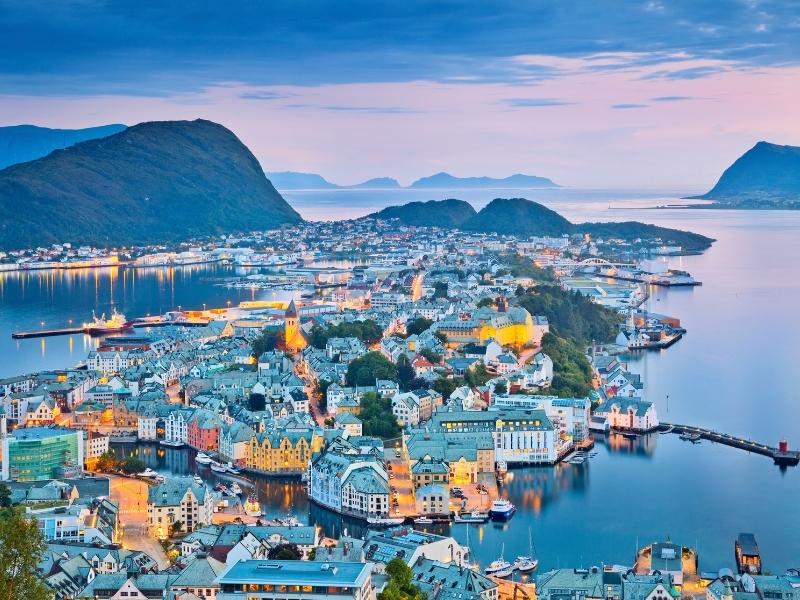
Low Emission Zones
There is a combined congestion and low emission zone in Oslo called the Oslo Charging Scheme . The cost of entering the LEZ is calculated within the toll charges for driving in Oslo and is dependent on the Euro standard and fuel type. No sticker or vignette is required – AutoPASS will collect the toll along with your other tolls.
Oslo also operates emergency measures and closes to diesel traffic when emissions are high. 24 hours’ notice is given of any closure, you can check here for updates and current status.
Elsewhere in Norway, there are low emission zones in Bergen and Kristiansand, operated under the Bergen Charging Scheme and Kristiansand Charging Scheme . All three LEZ will be charged using the AutoPASS system.
But who wants to drive into a capital city in a motorhome or campervan anyway? Park or camp outside and use the excellent public transport system to visit the city centre.
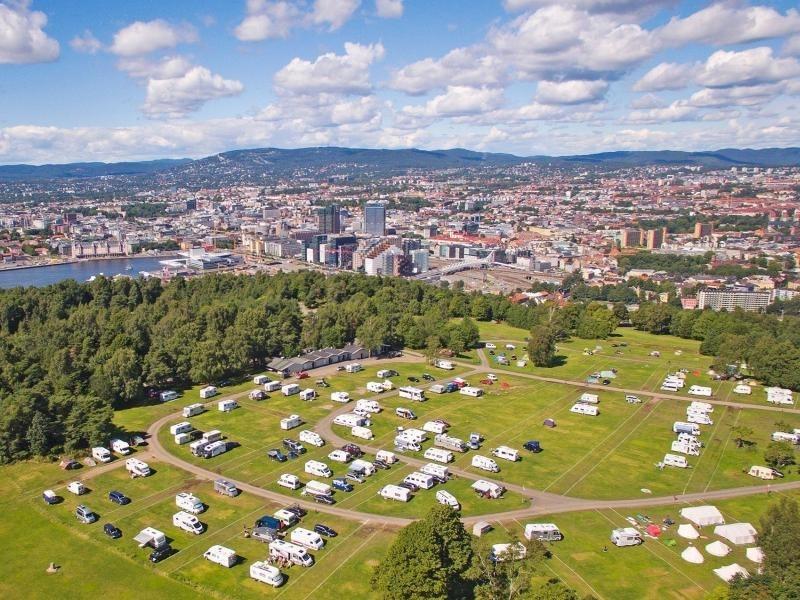
Fjord Ferries
From time to time, you will need to take a car ferry across a fjord. This is not a fjord cruise, but a quick crossing designed to get you from one place to the other as fast as possible, a bit like public transport.
It is not complicated, the road stops with no option to take another route and there is a ramp for a ferry there. Google Maps or your sat nav will know this and direct you accordingly.
There are generally two car ferries passing each other in the middle, and the operation of getting vehicles on and off is pretty slick.
Usually, the ticket seller will come to your van with a mobile card device and dispenser. Expect to pay around NKR120 for every ten minutes of ferry time in a class 2 campervan or motorhome, or use your AutoPass electronic toll tag to pay.
We loved this part of touring in Norway by campervan, it somehow felt more exciting than driving the M25!
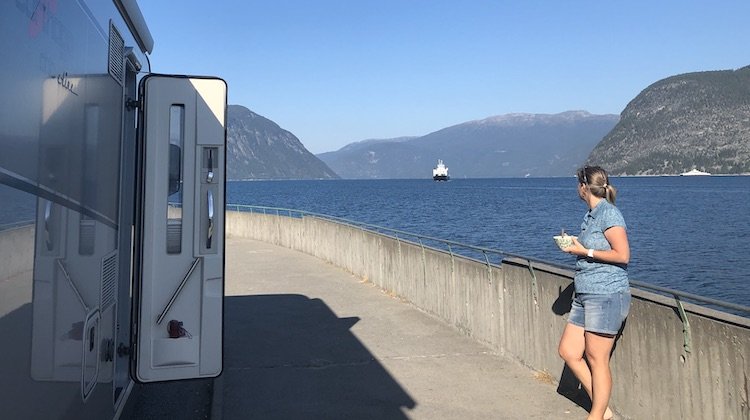
Campervanning in Norway FAQs
Can i park a campervan anywhere in norway.
You can park a motorhome or campervan in a parking space on the street or in a car park in Norway. Where you have to pay for parking, you’ll find an automated parking meter (P-automat).
You can also stay the night on private property if you have permission from the owner. The allemannsrett (all men’s rights) Norwegian law means that you can camp anywhere in Norway where the land is not owned or cultivated or where there is no local regulations or signage forbidding it.
How do I get from UK to Norway by motorhome?
You can get from the UK to Norway in a campervan or motorhome by crossing the English Channel to the continent, driving north into Denmark and crossing the Storebaelt Bridge and Oresund Bridge to Sweden before driving into Norway, or by taking a ferry to Norway from Germany, Denmark or the Netherlands. There is no direct ferry from the UK to Norway.
Is it easy to campervan in Norway?
Yes! Norway is a hospitable nation and welcomes van lifers who want to explore the diverse and stunning landscapes of the country. It may cost a little more than van life in Spain , for example, but it’s a real bucket list destination and well worth the effort and cost.
Is it safe to wild camp in Norway?
Absolutely. We have visited Norway twice in a motorhome, for several months each time. We usually spend about 80% of our time camping off-grid and Norway was no different. We loved the friendly people and the huge open spaces and never felt unsafe wild camping in Norway.
Campervan Services in Norway
Motorhome service points are pretty widespread and usually free although you might need a coin or two for a CamperClean automatic toilet cassette emptying machine if there is no other option.
You’ll often see water and waste services in petrol stations, and Park4Night is an excellent way to find campervan and motorhome services as you travel Norway. You can also find information on BobilVerden and BobilPlassen websites.
Camping in Norway
Norway is very tolerant of campervan visitors and although numbers have increased exponentially over the past five years, we felt welcomed wherever we went.
You’ll be able to find great campsites outside all the major cities and near all the top places to visit in Norway .
Wild or Free Camping in Norway
The allemannsrett (all men’s rights) Norwegian law was enshrined a long time before travelling in campers became such a popular way to see the country, but the spirit of the law stands and the best part is that it seems to cover campervans and motorhomes.
The gist is that you can practice off-grid camping in Norway where the land is not owned or cultivated or where there is no signage forbidding it.
Follow the usual free and wild camping good practice and don’t overstay your welcome – we would suggest one day and certainly no more than 48 hours in the same spot. Use Park4Night to find wild camping spots and the best places for free overnight parking.
Always follow the ‘leave no trace’ principle, take your rubbish, black and grey waste with you or dispose of it in the proper place.
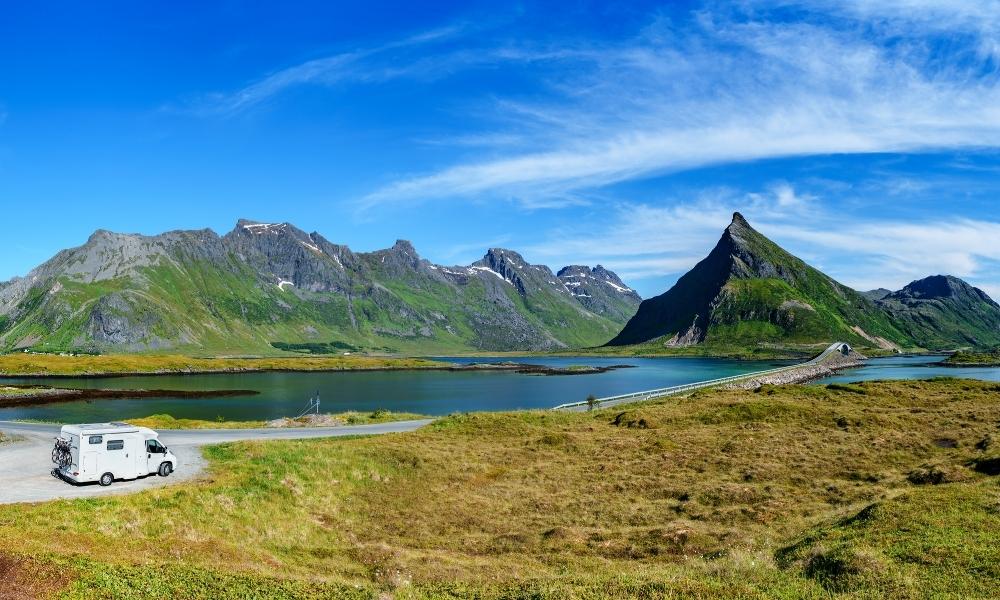
Campsites in Norway
There is a good network of campsites for campervans and campers with tents in Norway, although most cannot be booked and seem much more transient than those on the continent.
All have small sleeping huts or cabins to rent for hikers and offer kitchen facilities where groups of people can cook and eat together. This works well for those in touring cars with a rooftop tent or with a mini camper, where cooking facilities are limited. Visit Norway has a great blog post on the top ten motorhome and campervan sites in Norway which you may find helpful.
Norway camping sites don’t usually have bars or restaurants and people tend to retire early and rise early. Expect to pay between NKR250-400 a night, including electricity. There are normally extra charges for things like the washing machine, and a hot shower will typically cost NKR50-60 for five minutes.
Find the best campsites in Norway with Eurocampings , who have over 200 campsites across Norway, perfect for campervans and motorhomes. Some campsites are more informal than others and it’s not always possible to book overnight, but campervanners tend not to stay for long periods and pitches become available daily.
Campsites you find on Eurocampings will also accept CampingCard ACSI, which gives over 60% discount on Norwegian campsites outside of high season.
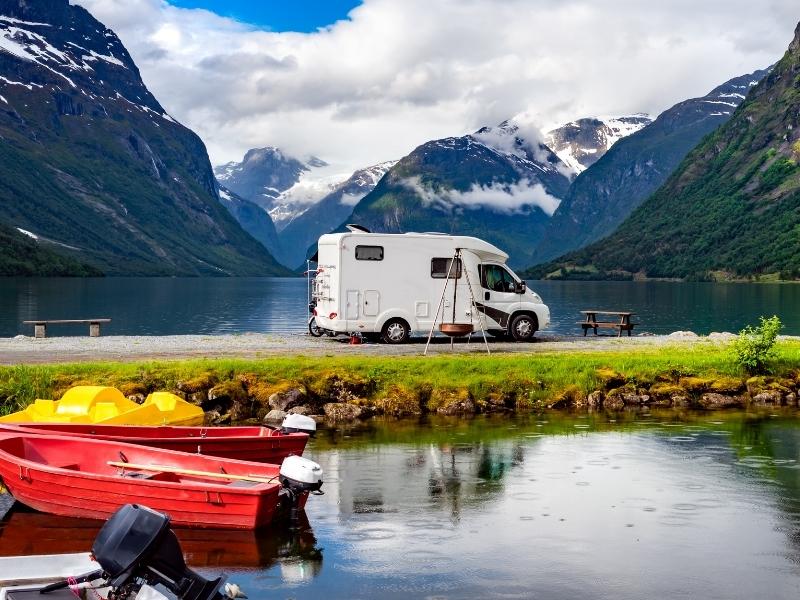

Motorhome Aires Norway
There are also good camping aires with motorhome and campervan service points across Norway, where you can find overnight motorhome parking and services like fresh water and cassette emptying.
Use Park4Night or BobilPlassen ( bobil means motorhome in Norwegian) for up-to-date information about the locations of rest areas and facilities.
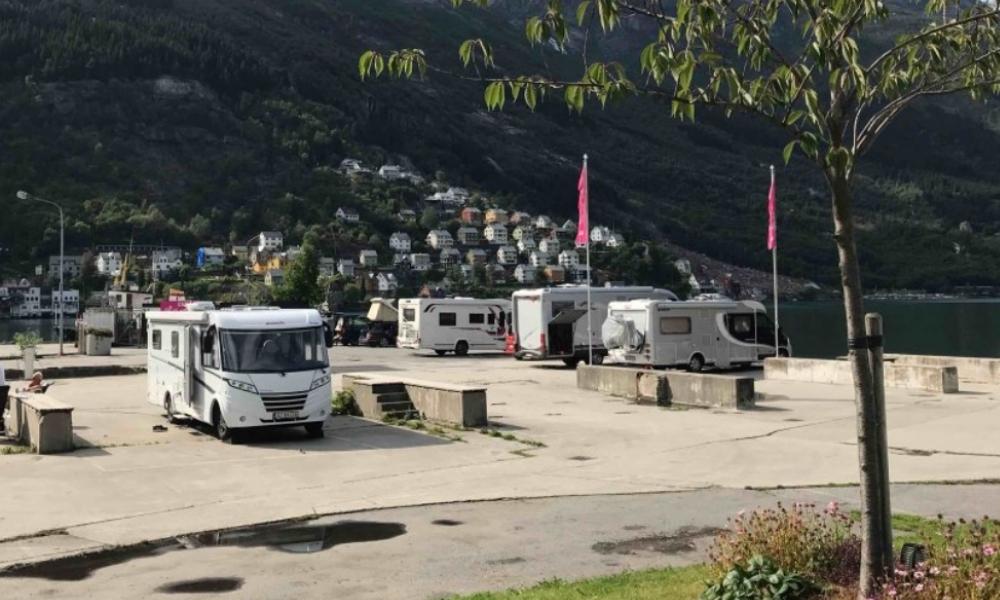
Similar to France Passion, which provides free campervan stops in France, Nortrip connects motorhome travellers who want to experience authentic Norway with hosts that have something special to offer like local farms, dairies, microbreweries, museums, cideries and mountain shielings (smallholdings).
A physical book and an app, the Nortrip scheme allows members to stay on their host’s land overnight. Some hosts offer facilities, but not all do, and there is no obligation to buy.
For those travelling through Denmark to Norway, you’ll be pleased to know there is a similar scheme, called Pintrip .
Norway Campervan Essentials

Motorhome & Campervan Destinations in Norway
Wherever you go on your Norway campervan trip you’ll be wowed by the starkly beautiful landscape, with glistening deep blue fjords, dramatic mountains, ancient glaciers and waterfalls everywhere you look. If you can’t decide where to go, check out our three ready-made Norway road trip itineraries , where we share all the best parts of Norway!
If you like being active…
If you’ve ever looked at those amazing images of people perched on tongues of rock, practising yoga on sheer cliffs or star-jumping off precipitously balanced boulders whilst gazing out over sparkling blue fjords, these three great hikes are for you!
Preikestolen
Pulpit Rock, or Preikestolen , is an easy 7.6km hike with a small elevation gain of 334 meters and can be done in half a day with an early start. The best option is to begin the hike at the trailhead in Preikestolenhytta where you can park easily , or camp nearby .
There are zero facilities on the Pulpit Rock hike, so make sure to go prepared and take additional clothing as the weather in the fjords can be unpredictable.
Kjeragbolten
From Preikestolen, you can take the Lysebotn-Forsand car ferry along the Lysefjorden for the next stop, the Kjeragbolten hike. Kjeragbolten is a giant boulder wedged in a crevasse at 1084 metres above sea level on Mount Kjerag, the highest peak in the Lysefjorden. You can also base jump and climb here.
The hike to Kjeragbolten is around 11km long with 800m of altitude gain, and the round trip takes about seven to ten hours depending on your fitness and experience. You need to be in good physical shape and have some hiking experience before attempting this route.
The starting point is at the parking lot at Oygardstol , where there is also drinking water available. Just getting there involves a pretty spectacular drive up the Fv500 with hairpin bends aplenty! If you want to stay close overnight, try this wild camping spot further up the hill.
Odda is a great place to base camp for the infamous Trolltunga hike through the glorious Folgefonna National Park.
A truly unforgettable experience and the most challenging of these three famous Norway hikes, the route is 20km across mostly flat terrain, but the path can be tricky underfoot and the weather changeable.
Hiking Trolltunga is not for the faint-hearted or unprepared but is an absolute must-do on your Norwegian campervan road trip.
RELATED POST: Norway Road Trip Itinerary – Three Unmissable Routes
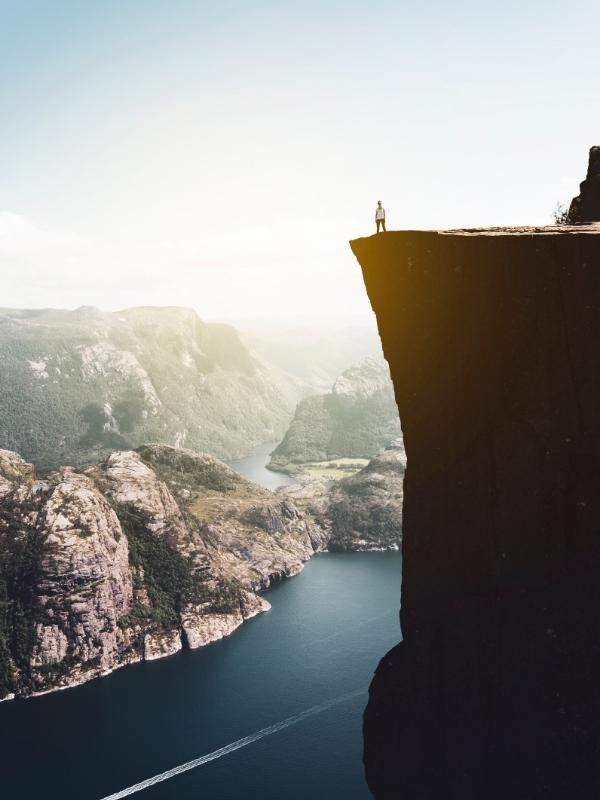
Popular with motorhomes and road trippers, Flam (pronounced Flom) is a small village right at the top of the beautiful Aurlandsfjord.
Surrounded by towering mountains, waterfalls, fjords and rushing rivers, this is a playground for hikers, water sports enthusiasts and mountain bikers, and is also home to the spectacular Flamsbana railway, considered one of the most scenic train rides in the world. Taking the railway to Myrdal and cycling back to Flam on the Rallar Road is a unique experience and sure to be a highlight of your stay.
From Flam you can follow the magnificent Sognefjord east to the stunning Jotunheimen National Park and into the ‘Giant’s Home’, a fitting name for this vast and soaring open country where there are over 250 mountain peaks of almost 2000m high and the natural beauty of Norway at its very best.
RELATED POST: Flåm Norway: Visitor Guide & Tips
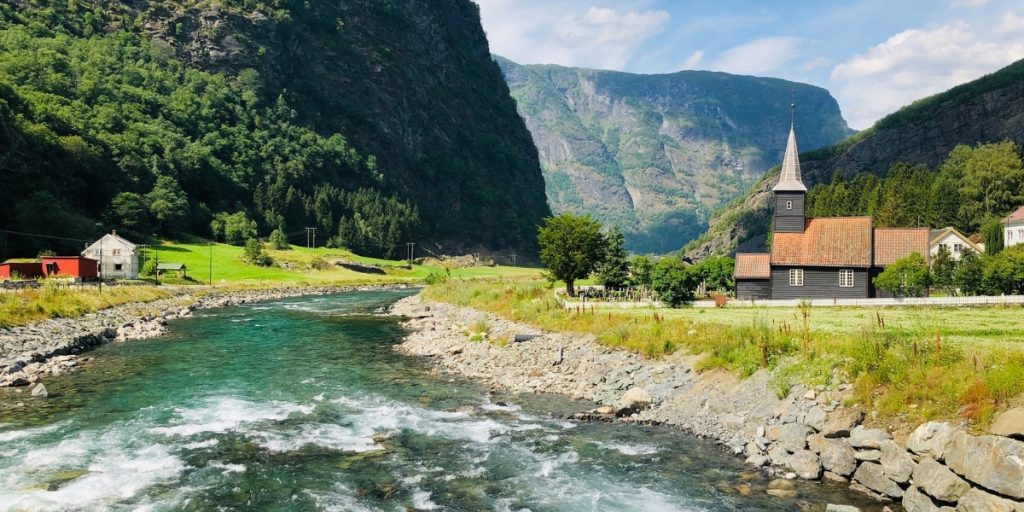
Loen is where you’ll find the amazing skylift which takes you to the top of Mount Hoven for spectacular views of the blue-white Jostedal glacier. If you prefer to get to the top under your own steam, take the via Ferrata up and the zip-line down.
If sea-level activity is more your thing then head for the very Instagrammable, but glacial, Lake Lovatnet. Take a boat trip or go swimming and kayaking in the summer months, before stopping at Sande Camping , possibly the best motorhome campsite in Norway.
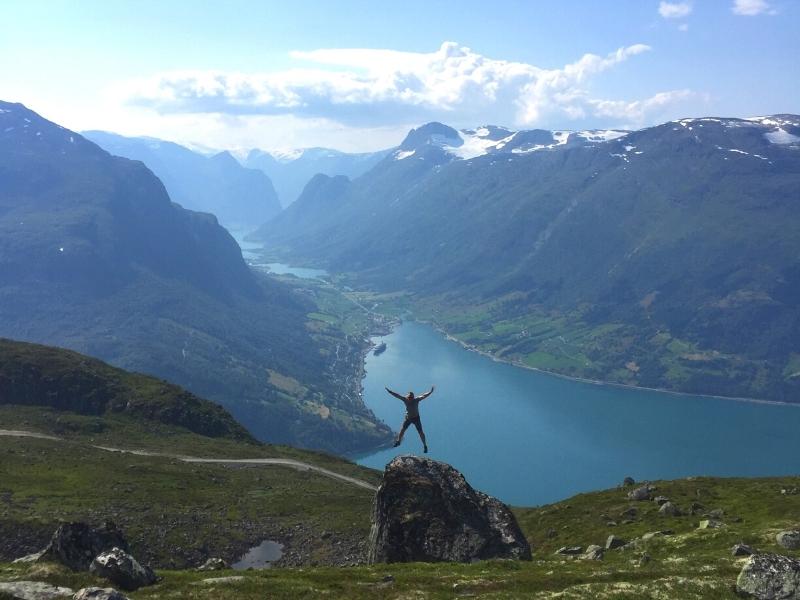
At Hellesylt, take the ferry through the UNESCO World Heritage Site of Geirangerfjord to the town of Geiranger itself. Expect the town and ferry to be busy, this area is one of the top road trip destinations in Norway.
As you leave Geiranger for Eidsdal and wind your way up the steepest section of route 63, along its eleven switchbacks hanging 700m above the fjord below, you’ll understand why this scenic drive is called ‘the Eagle Road’.
At the highest bend is the most breathtaking view over the beautiful Geirangerfjord, and the location of the must-watch-before-you-go movie, The Wave .
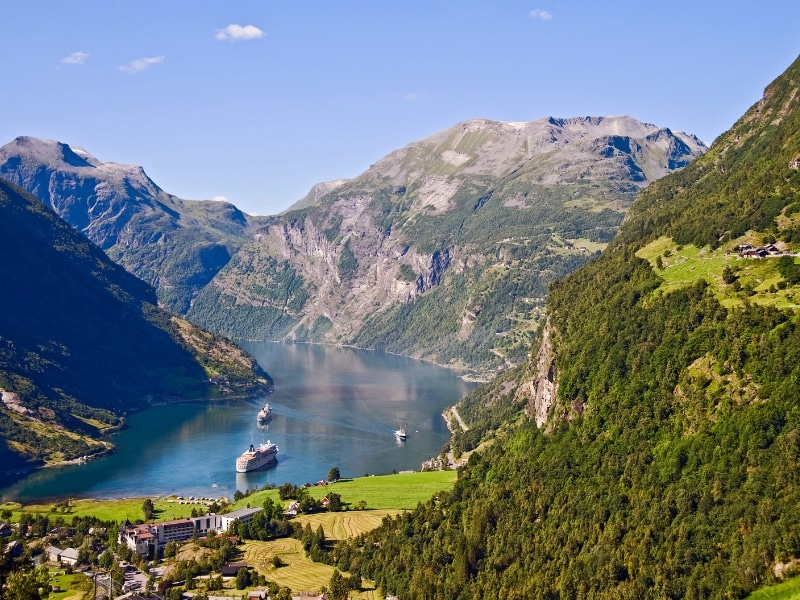
Lofoten Islands
One of the most stunning areas of Norway, the Lofoten Islands are where dramatic mountains meet brilliantly white sandy beaches, picture-perfect fishing villages of cute wooden houses dot the coastlines, and hiking trails snake their way through some of the most magnificent landscapes in Europe.
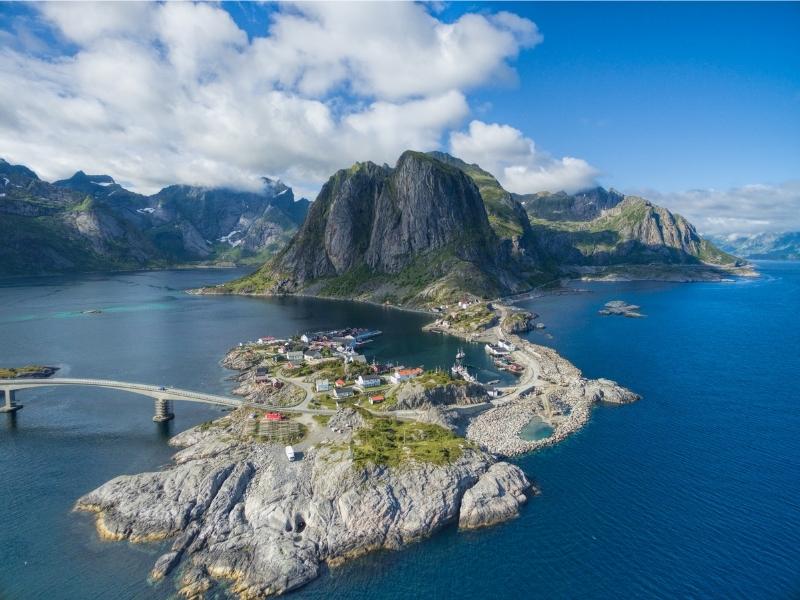
Are you new to motorhoming? Our motorhome beginners resources have everything you need from helpful printable motorhome checklists and easy guides to taking your first motorhome trip . Or check out our motorhome beginners e-book and find all our resources and guides in one place!
If you’re all about the driving…
Trollstigen mountain road.
The RV63 Trollstigen Mountain Road is one of the best driving roads in Europe . Incredibly beautiful, this road was opened in 1936 and includes eleven hairpin bends and a 9% incline.
Without a doubt, it’s one of the most dramatic and scenic roads in Norway. Stop at the Ornesvingen viewing point for incredible vistas, and again at the top to admire the Stigfossen waterfall before heading on to stunning Geraingerfjord, one of Norway’s eight UNESCO World Heritage Sites.
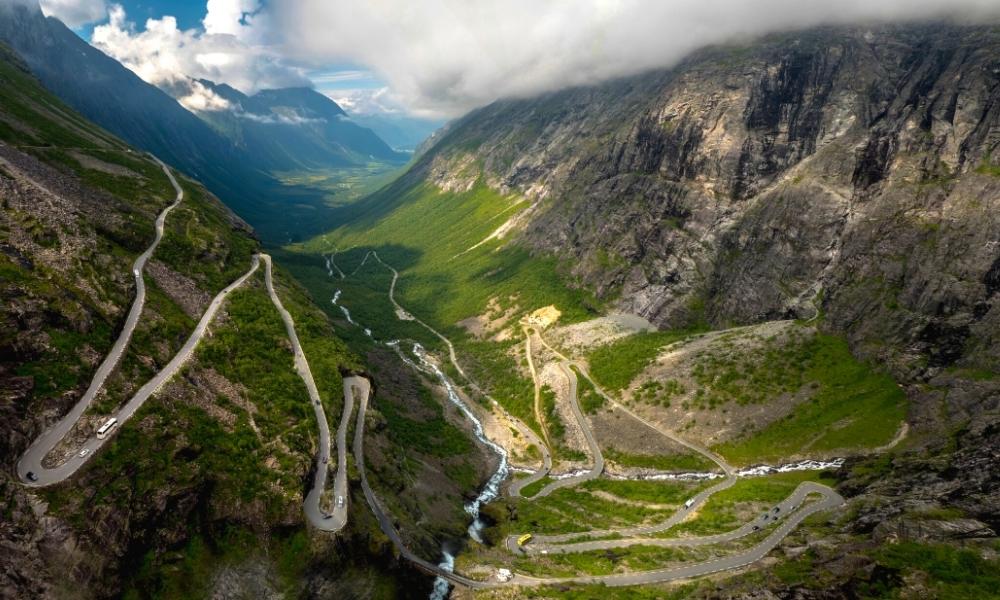
Atlantic Ocean Road
A fantastic visual experience, Norway’s Atlantic Ocean Road, or Atlanterhavsveien , snakes for around 30km across seven islands along the west coast like a silver ribbon dancing in the sunlight.
The highlight is the Storseisundet Bridge that connects the Romsdal peninsula to the island of Averøya. When there is a strong wind the bridge is spectacular with large waves crashing against it, creating great photo opportunities.
The award-winning Atlantic Road is a designated Cultural Heritage Site, a National Tourist Route, and has been recognized as the Norwegian Construction of the Century.
RELATED POST: Atlantic Road Norway: Absolutely Everything You Need to Know!
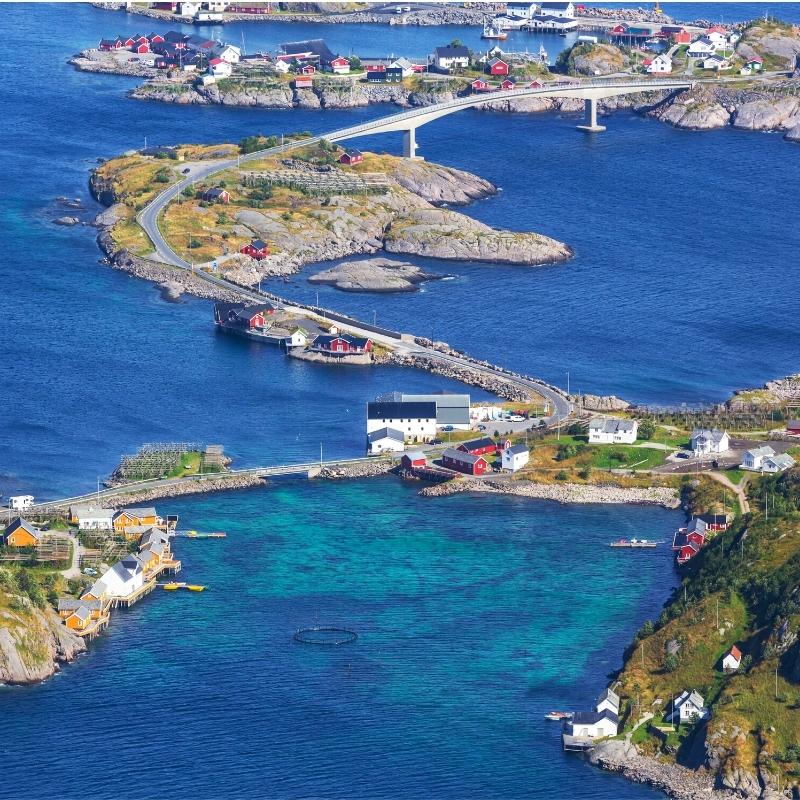
Kystriksveien Coastal Route
If you’re heading to northern Norway, there are two different ways to get there. You can take the E6 Arctic Highway all the way or around 80km north of Trondheim.
But we think a far better way is to pick up the FV17 just after Steinkjer and take in the glorious landscape and coastal views from the magnificent Kystriksveien Coastal Route, one of Norway’s most scenic road trips and an official Norwegian scenic route.
Taking this Atlantic road route will add quite a few kilometres, two days and six fjord ferries to your journey, but the detour will be so worth it! You’ll cross into the Arctic Circle at 66 degrees, on the boat between Kilborghavn and Jektvik.
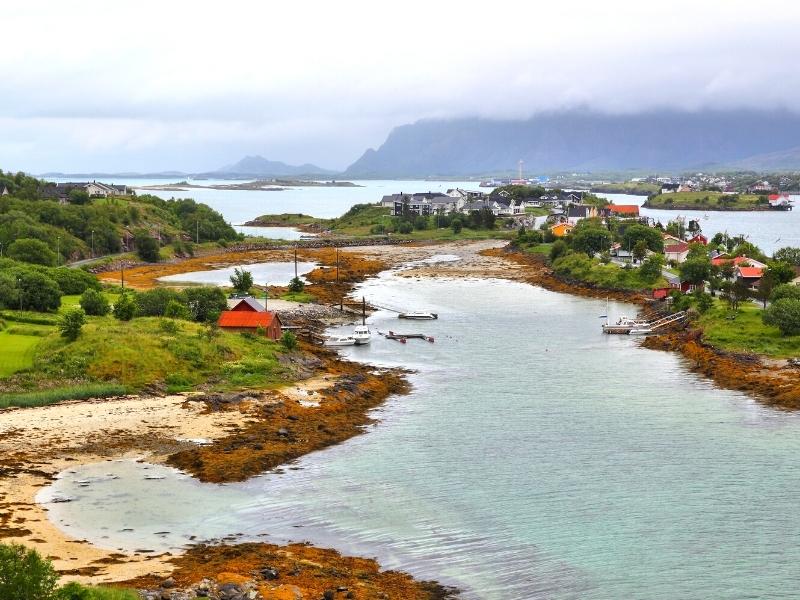
Norway Travel Inspiration
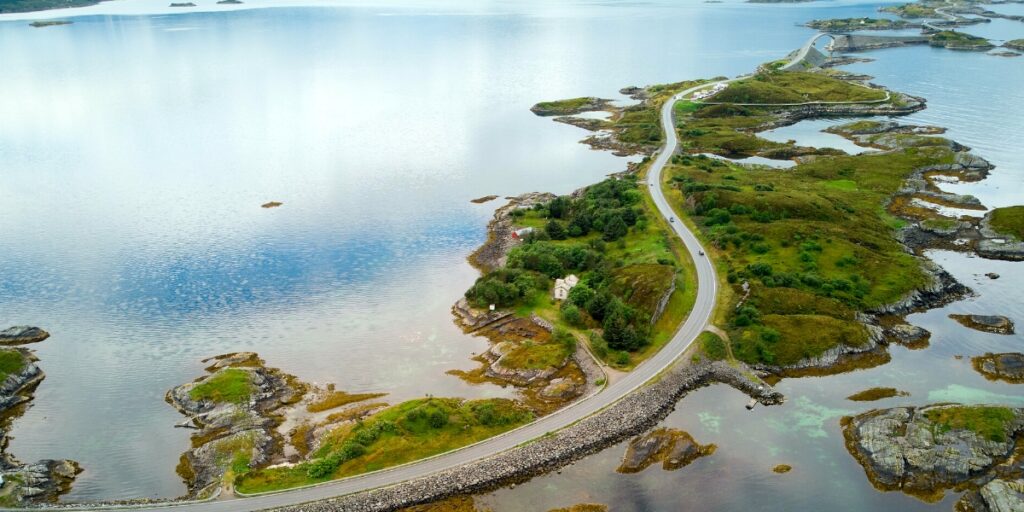
Atlantic Road Norway: Absolutely Everything You Need to Know!
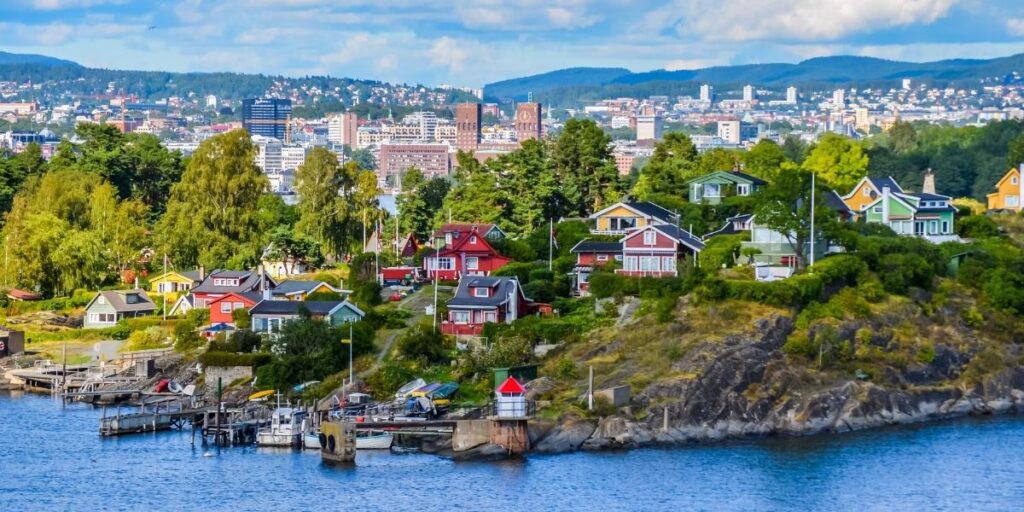
Best One Day Oslo Itinerary + Map, Guide & Tips
Driving to norway from uk – routes & tips.
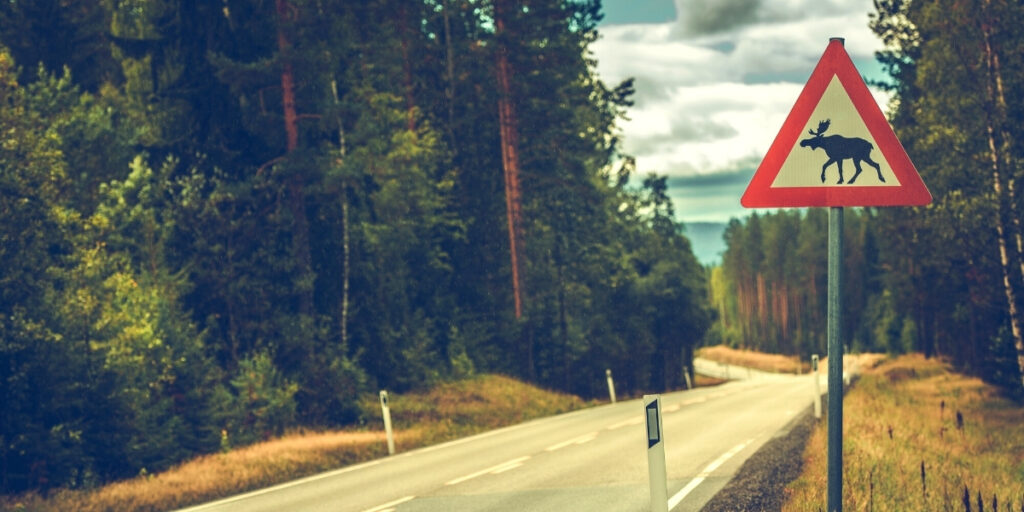
Driving in Norway – All You Need to Know
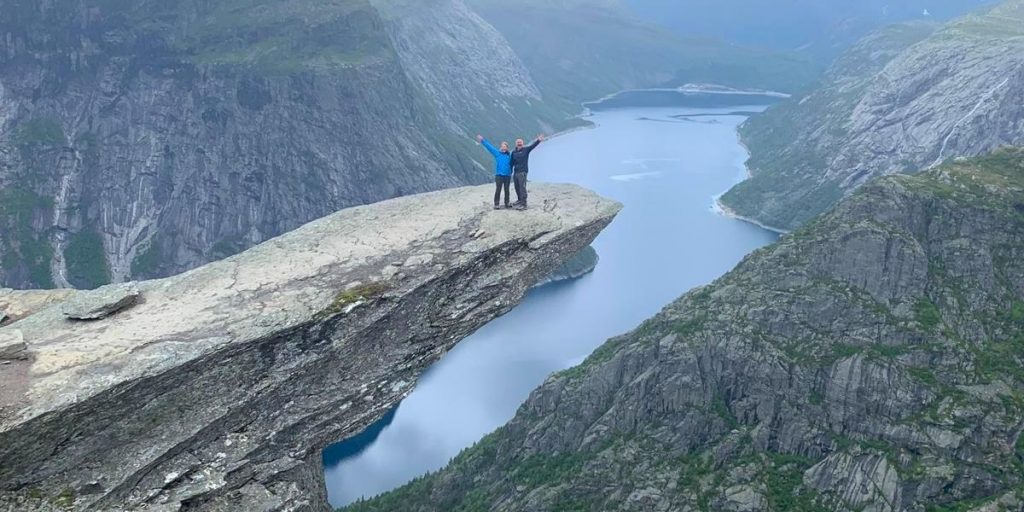
Trolltunga Hike: Absolutely Everything You Need to Know!

Flåm Norway: Visitor Guide & Tips
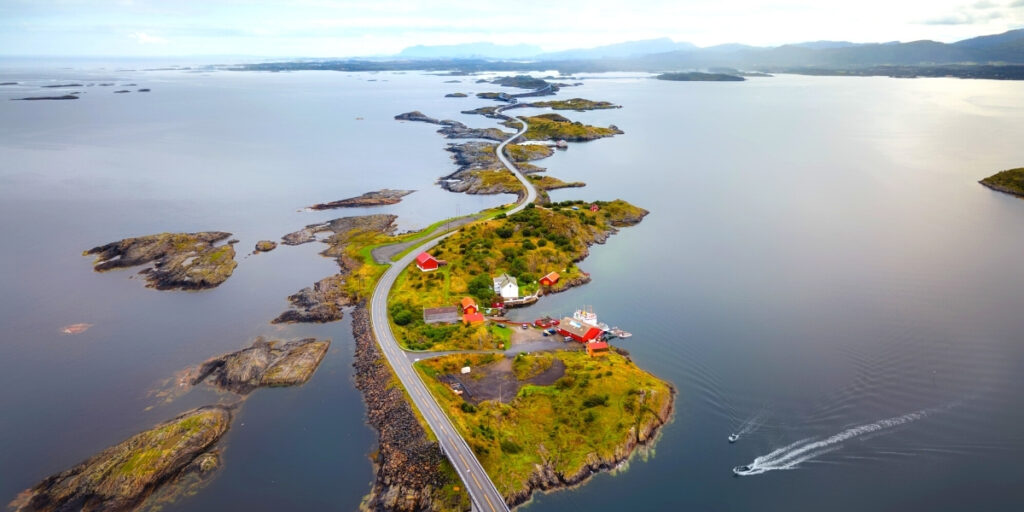
Norway Road Trip – Three Unmissable Routes
Norwegian life.
Norway is a vast country with only five million inhabitants, shaped by its Viking history, geography and unique farming culture, which is still alive and kicking today.
Things to Know About Norway
- There are a lot of vans in Norway from many different EU countries; we were surprised by how many. But, this is a huge country and there is plenty of room for everyone, especially when you get off the beaten track, or head further north, whether you’re going hiking in Tromso or chasing the northern lights.
- Norwegian (and in fact most Scandinavian) society is based on Janteloven ( the law of Jante) which at its simplest describes the way that all Norwegians behave; putting society ahead of the individual, practising humility, equality, respect, and simplicity. Wealth is not flaunted, people don’t criticise others, and egalitarianism is key. This is not an actual law but describes how people should behave in society; it helped us as visitors to understand Norwegian culture and behaviour.
- Almost all Norwegians speak English at an intermediate level unless they are older and live rurally.
- Norwegians work to live; Koselig has no direct translation but influences Norwegian behaviour at weekends and holidays. This post by our friends at the Life In Norway blog explains the concept visually.
- Norway is on the verge of becoming a truly cashless society and is streets ahead of many other EEA countries. It is completely normal to pay for a €3 ice cream using a card or ApplePay.
- Recycling is important here; a pant (pledge) is charged on all bottles. You can return the bottles to the panteroom to get your deposit back or press a button and give your deposit to charity.
- Norwegian people like their personal space. They will not willingly sit next to a stranger on the train or bus and prefer not to stand too close to others in queues. This is because there are so few Norwegian people in their huge country that they are used to having lots of room to move!
- Most grocery shops will be closed on Sundays. Garages will sell basic groceries but at inflated prices so better to be prepared and shop on Saturday.
- Alcohol in Norway is sold mainly by the state. Beer can be found in most shops but is only sold before 8pm on weekdays or 6pm on Saturdays and not on Sundays. For wine, spirits or stronger beer, you must visit one of the Vinmonopolet known to locals as pole, found in most large cities and towns. Tax Is levelled on all alcohol with more than 0.7% by volume of alcohol and is pretty hefty, making booze really expensive.
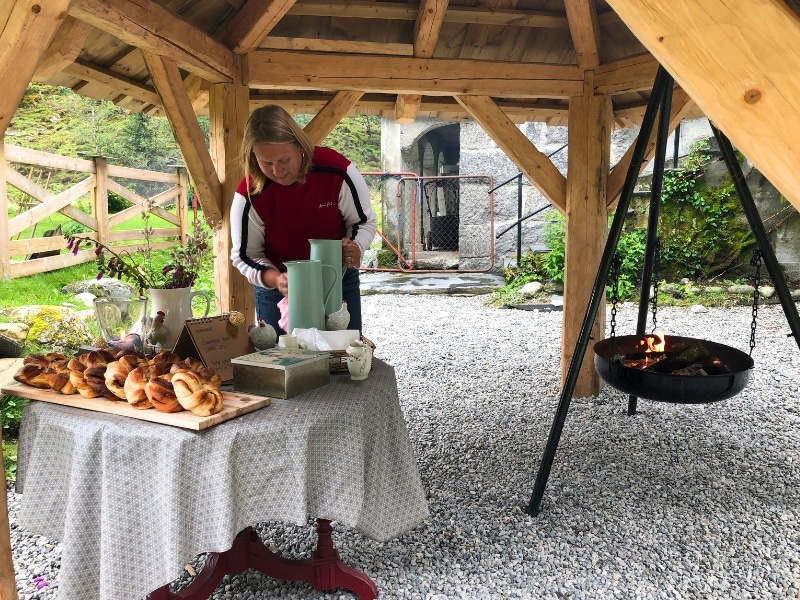
Food & Eating Out in Norway
Norwegian food can be excellent. Abundant seafood, local specialities such as reindeer, and a growing trend towards using hyperlocal, seasonal ingredients are undoubtedly the highlights.
- Norway loves meat; reinsdyrstek (reindeer) should be sampled if you are a meat eater and should be eaten on the rare side for the best flavour. Beef, lamb and venison are also popular and cheaper than reindeer.
- Vegetarian food is becoming more and more popular and we found multiple options for plant-based dishes on most menus.
- Salmon is the most eaten fish; farmed is much, much cheaper than wild salmon and often tastes just as good.
- You will also come across lots of raw, salted, dried and cured fish… it’s definitely an acquired taste but necessary when fishing is difficult as all the fjords are frozen.
- Potatoes are served with almost every dish, especially if you are eating out in a rural town or traditional restaurant.
- Berries are delicious in Norway, they take longer to ripen and are thus more juicy and bursting with flavour. The raspberries are the largest and best we’ve ever eaten, expect to pay around NKR450-500 for a punnet.
- Other berries include strawberries, blackcurrants, red currants, blueberries (sometimes called huckleberries), which grow on open uplands; blue, swamp-loving bilberries; red high-bush and low-bush cranberries and the famous moltebær (cloudberries) which are highly prized and considered a delicacy. They grow one per stalk on open swampy ground and in Norway, cloudberry patches are zealously guarded. The perfect way to enjoy cloudberry jam is to eat it with brown goat’s cheese (yes brown!) and fresh or sour cream on a fluffy pancake!!
- Brown goat’s cheese or brunost is a Norwegian staple and is eaten at all meals. It has a distinctive caramelised flavour and delicious taste which is rich and creamy – you should definitely try it!
- Breakfast in Norway is coffee, some sort of crisp bread (often the dieter’s favourite, Ryevita) with cucumber and tomatoes and maybe a boiled egg or pickled herring. You may find cafés selling toast or croissants and pastries in larger towns.
- Lunch is an open sandwich with meat, fish or eggs, and dinner is usually the hot meal of the day, served between 4pm and 6pm in the winter months, and considerably later in the summer.
- We would say to avoid torsketunger (cod’s tongues) and rakfisk (fermented trout) unless you are a particularly hardy type with the constitution of an ox!!
- If you get the opportunity, try the national spirit akevitt (aquavit), a potent dose of Norwegian culture made from potatoes and caraway liquor. Although caraway is an essential ingredient, various modern distilleries augment the spicy flavour with any combination of orange, coriander, anise, fennel, sugar and salt. The confection is aged for three to five years in 500-litre oak barrels that have previously been used to age sherry. Just go slow and don’t drive afterwards!
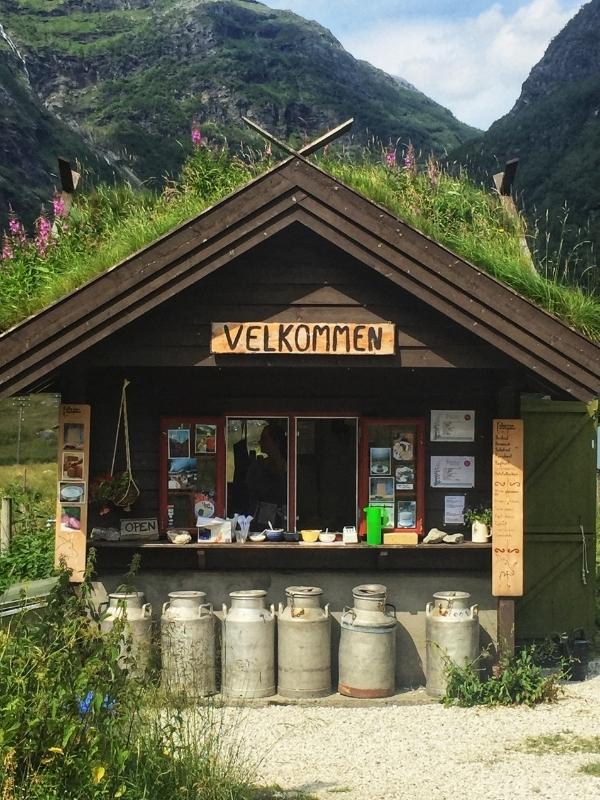
Are you looking for more motorhome touring guides? Check out these top posts…
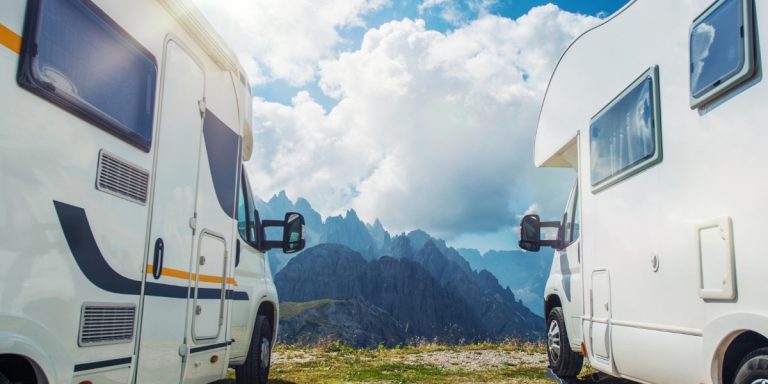
Europe by Motorhome: The Best & Only Touring Guide You Need!
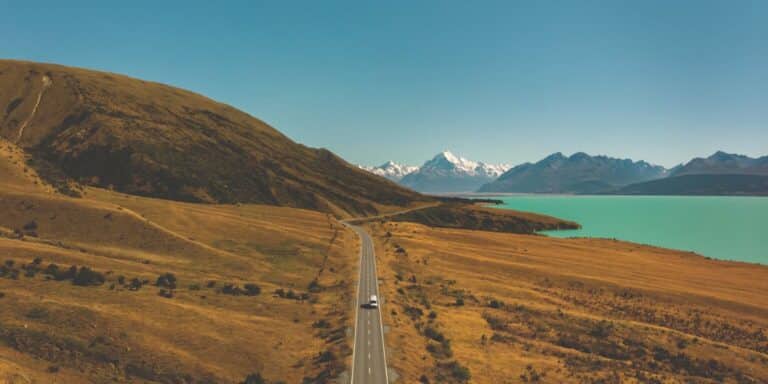
Campervanning New Zealand: Literally Everything You Need to Know!
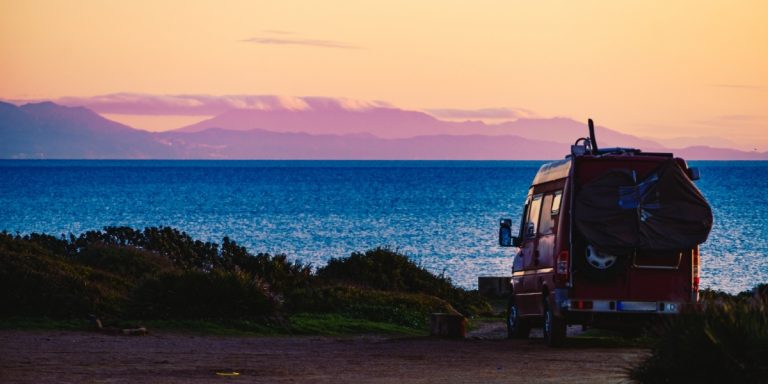
Campervanning in Portugal: Complete Guide for 2024
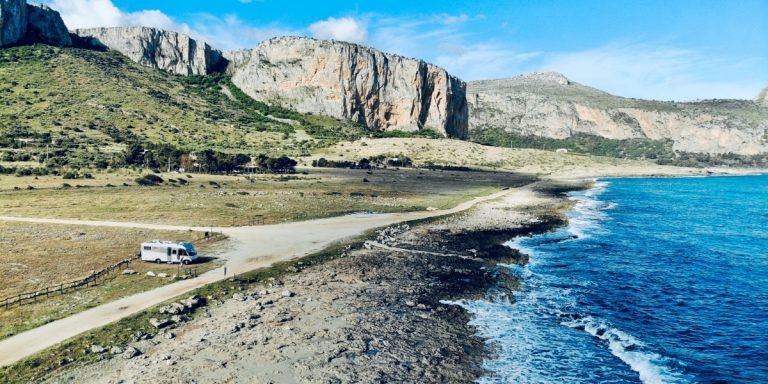
Motorhoming in Italy: Your Complete 2024 Guide
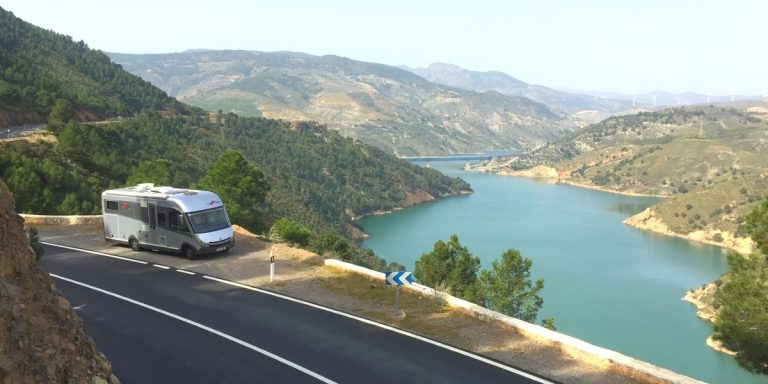
Motorhoming in Spain: Your Complete Guide for 2024
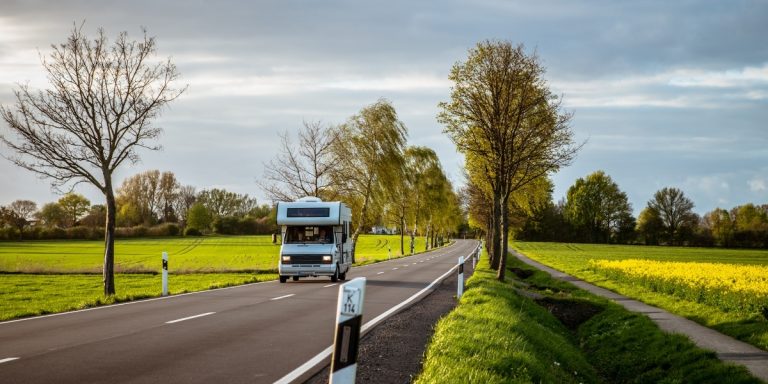
Motorhoming in Germany: Your Complete Touring Guide for 2024
Love it pin it.
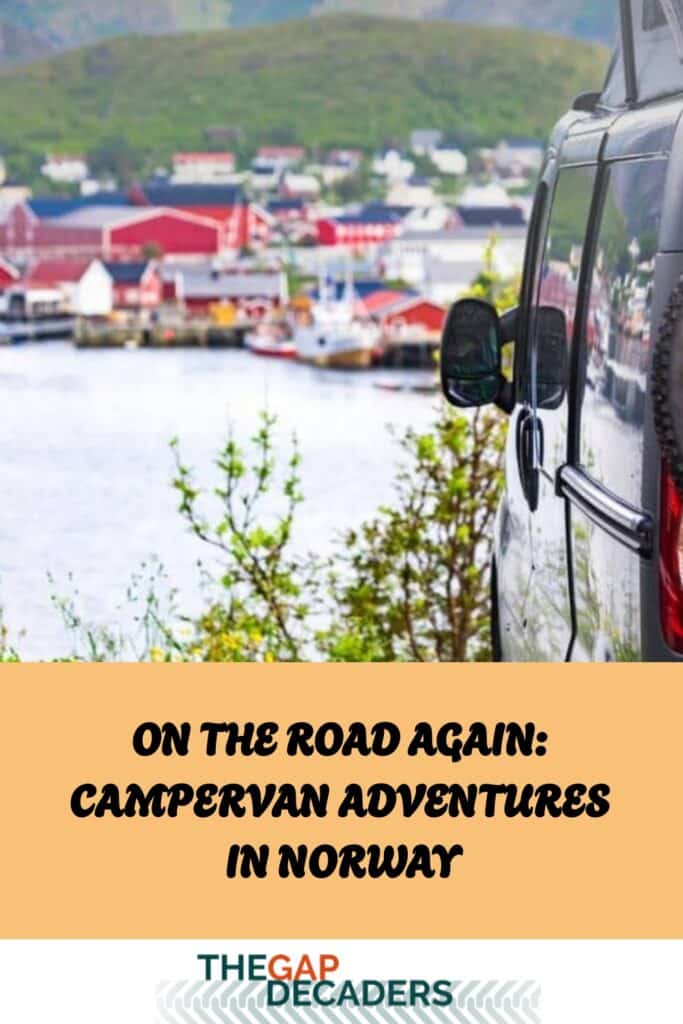
About The Author
Izzy Nicholls
Leave a comment.
Your email address will not be published. Required fields are marked *
Scandinavia and Finland by camper – on the road again!
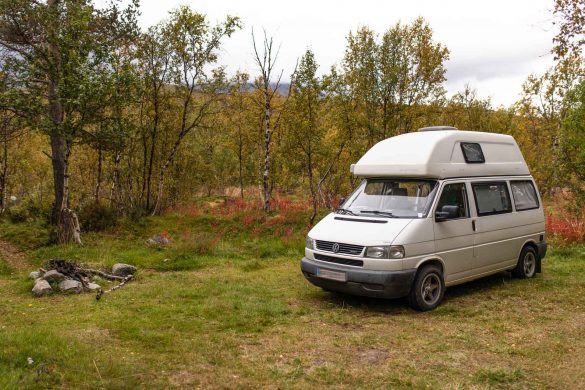
Visiting Scandinavia in your own camper, mobile home or trailer is a great way to get around in the Northern countries. Sleep in front of Santas doorstep, experience the wilderness with the comfort of a solid mobile shelter or go all the way to the end of the road in Finnmark.
Driving your own camper to Scandinavia – is it worth it?
Finland, Sweden and Norway are by far the easiest (and in our opinion the best) countries in Europe for independent travelling in a camper. Over night stays are possible in most places and apart from urban areas and private roads there are very few restrictions on where you can set up your base for a night or two. Enjoy the beautiful landscapes while sleeping every day on another breathtaking place.
All Northern countries offer excellent road infrastructures. Public parking bays often feature small shelters where you can make a fire and overnight stays with total privacy can be found in every area. Lapland is predestined if you want to stay off the grid and if you feel the need for that hot shower once in a month you can always opt for one of the campsites.
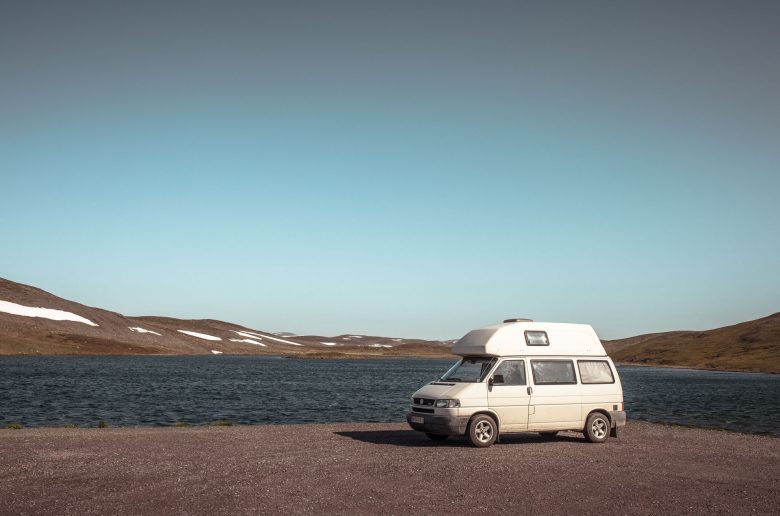
Especially if you have time, the mobile camping experience is the perfect way to travel between national parks, cultural destinations and all three countries. In the following we will give you an overview about the most important things to know when you visit the North in your own ride.
- Which campervan is the best option?
- How can I get my campervan to the North from central Europe?
- Can I rent a camper van in Scandinavia or Finland?
- Are there rules for camping in Scandinavia?
- Are there differences between the countries?
- How are road conditions?
- Off the grid or better campsites?
- What to bring?
Scandinavian fish | Skandinavische Fische | Skandinavisk fisk – poster
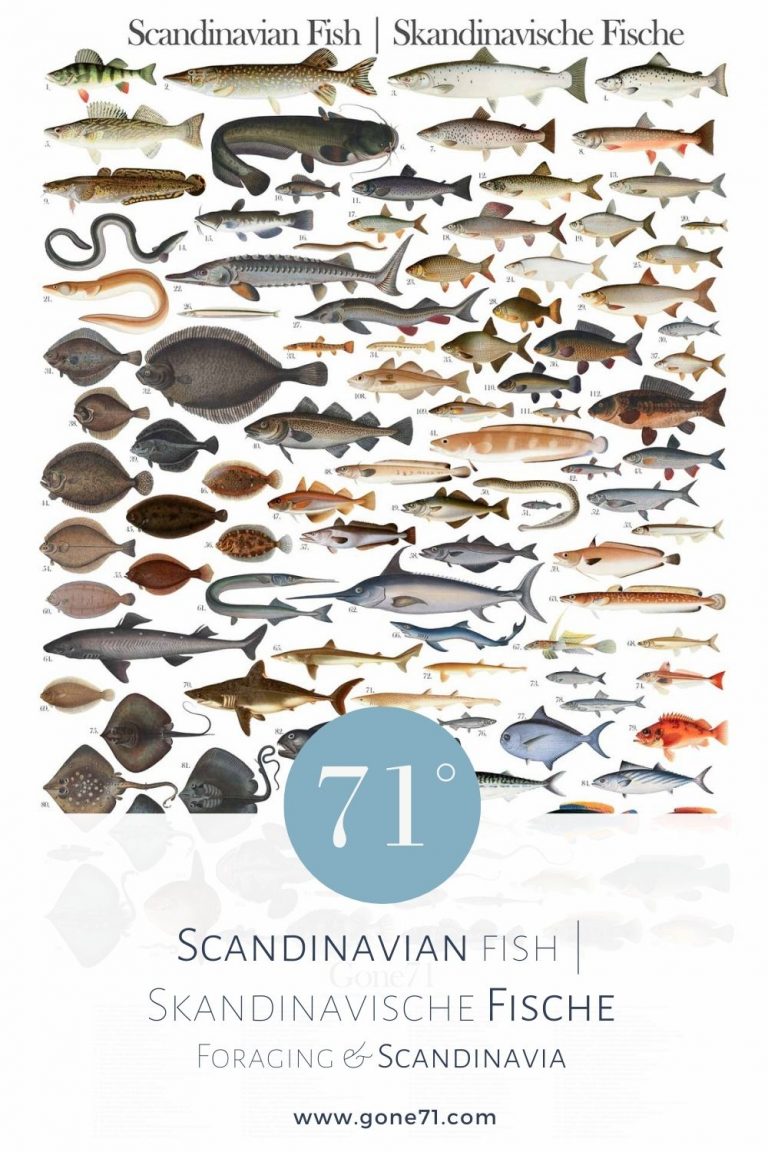
Camper van, motor home or caravan for the North?
Obviously that depends mostly on your preferences and style of travel. The options are plentiful and from your family’s old ‘80s road cruiser to that 4×4 expedition vehicle everything is suitable. Except for some streets in Norway, most regions are flat with usually 90 km/h to 100 km/h (60mph) maximum speed. As long as it roles you’ll get along.
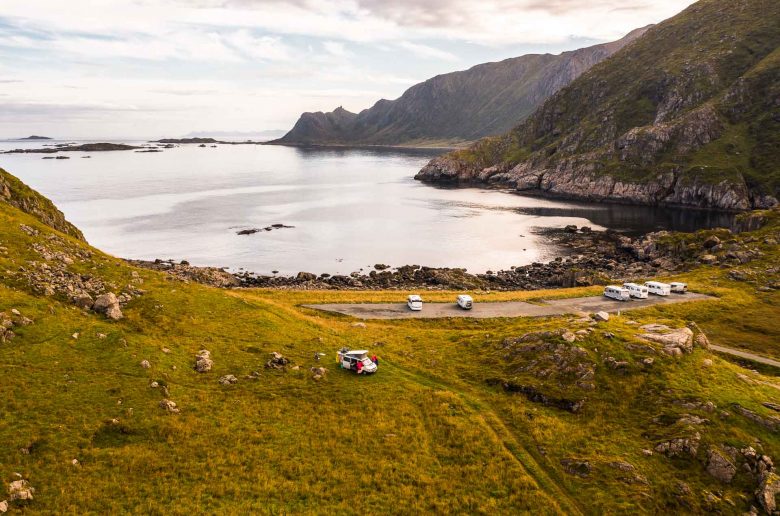
In our experience a smaller campervan can be very versatile. It drives and behaves more like a normal car and you’ll have it sometimes easier to go those extra meters for the perfect spot. For a road trip style of adventure and long distances this is definitely the right choice. The obvious downside here is space. There can be a lot of rainy days in the North and as long as you do not like to cuddle you need a proper bad weather strategy. Depending on the features of your ride, you should also consider missing sanitary options (toilet, shower) and probably opt for a chemical toilet . Unless you are heading very frequently to official campsites you should be prepared for a lot of nature experiences – which is not necessarily a bad thing! If you are coming in spring or autumn, or if you spend most time in Finnmark an independent vehicle heater can improve your travel quality by a lot.

Motorhomes are the most common camping vehicle you’ll meet in Scandinavia – for locals and foreigners alike. If you want a bit more comfort, especially in terms of room, this is your best option. Apart from the more bulky handling you’ll have more flexibility in bad weather conditions, usually sanitary facilities and also better cooking options. There are more then enough places to park your campervan for overnight stays in all regions. As long as you are around a 6 meter length you should get to most places also apart from the main roads without problems.
Caravan / trailer
Many locals have a caravan to visit other places within the Northern countries. But also for foreign visitors this can be a great option. If you are planning to stay for longer in a certain area you can set your base and make day- or fishing trips with your car. This gives you certain flexibility without loosing the comfort you would normally have in a real motor home. There are a lot of parking bays and designated parking areas especially in the Northern areas of Scandinavia and Finland where you can detach your caravan.

4×4 Offroad
If go in summer and do not plan to do anything too unusual you can leave your expedition truck in the garage. You’ll be able to access almost all roads you are allowed to drive even though it might get a bit bumpy from time to time. More important then a 4-wheel drive is ground clearance in our opinion. For some access roads normal cars and motor homes are simply to low. Be aware that in general you are not allowed to drive your vehicle off road in the Northern countries. The only exception is Finland where you are allowed to do so if you have the permission of the land owner. It’s not Iceland where a proper 4×4 is mandatory if you want to head inland. In Finland, Sweden and Norway an expedition type of car will not improve your experience by too much in 95% of the time.
If you go in winter things are different of course and a four wheel drive can be very useful. However, as long as you stay on the main roads and drive slow and carefully (which you have to do in any case!) it will not be mandatory either. Regions with a lot of snow have usually a very goad road management and snow removal for the main roads.

Bring your own mobile home to Finland, Sweden or Norway!
Yes you can! If you start from one of the central European countries this is usually no problem as long as there are no travel restrictions due to Corona. There are several options to make the journey to the North. You can either drive all the way on your own or you take a convenient ferry trip.
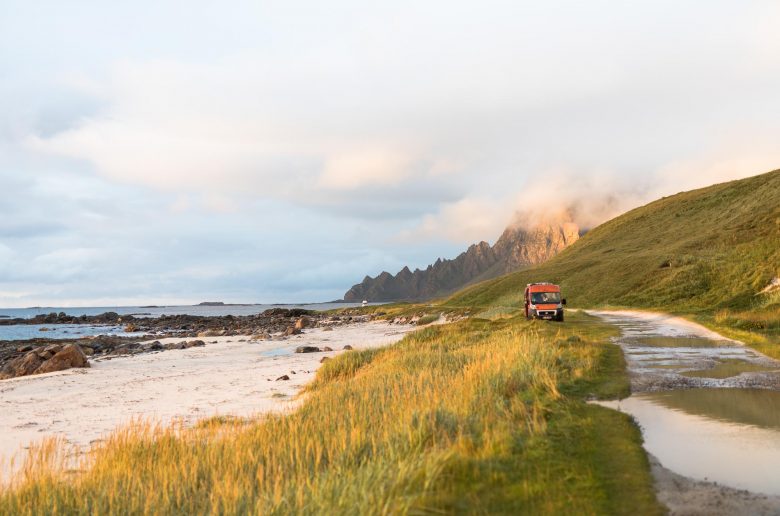
Driving your camper via Denmark to Sweden.
If you start anywhere in central Europe (Munich, Vienna, Zurich…) you can drive all the way on your own without taking a fairy service. Until now most travellers use at least at some point a ferry service to get from Northern Germany to Sweden (Trelleborg / Malmø) or directly to Finland. However in times of Corona, such means of transportation might get less popular and it’s good to know that this option exists.
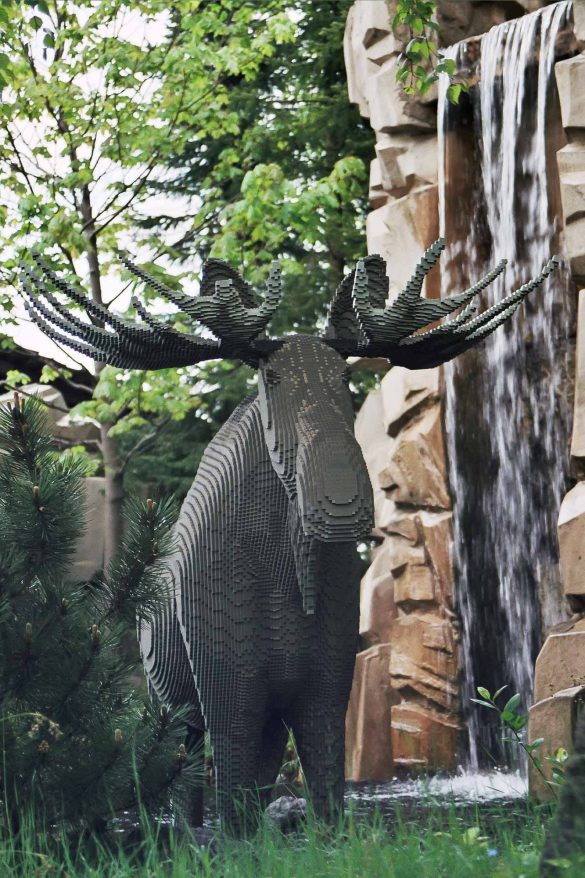
Depending on where you start you have to cross at least two countries (Germany, Denmark) in order to get to Sweden via the Øresund bridge . From there you can continue either directly to Norway or further into the North and Finland.
Scandinavian wildlife | Skandinavische Wildtiere | Skandinaviska vilda djur – poster

Driving your camper through the Baltic countries to Finland
The Baltic route was pre-Corona a very good option to drive most of the way to Finland on your own with the exception of a 2 hour fairy transfer from Tallinn to Helsinki. Not very common but until recently possible you can opt for a Russian visa and drive via St. Petersburg all the way over land to the eastern parts of Finland. Well, this option will be out of the question for some time now due to geopolitical events.
The usual route leads via Czech Republic and mainly Poland through the Baltic countries to Estonia. It’s not the most convenient rout regarding driving and especially Poland has some pretty bad road sections. In the Baltic countries the roads are ok but sometimes loaded with heavy truck traffic. If you want to get to Finland as fast as possible this is the way to go. Start in the early morning hours in Central Europe and go Fishing on the next day in the afternoon in the lake lands – if you can stomach long distance driving that is. Depending on your starting point, it is around 1.800 km to the ferry in Tallin. The ferry services runs several times a day (~2 hours) and usually it is no problem to book your passage on short notice (some hours before) online or directly in the harbor: Ferry Timetables Silja Line/Tallink
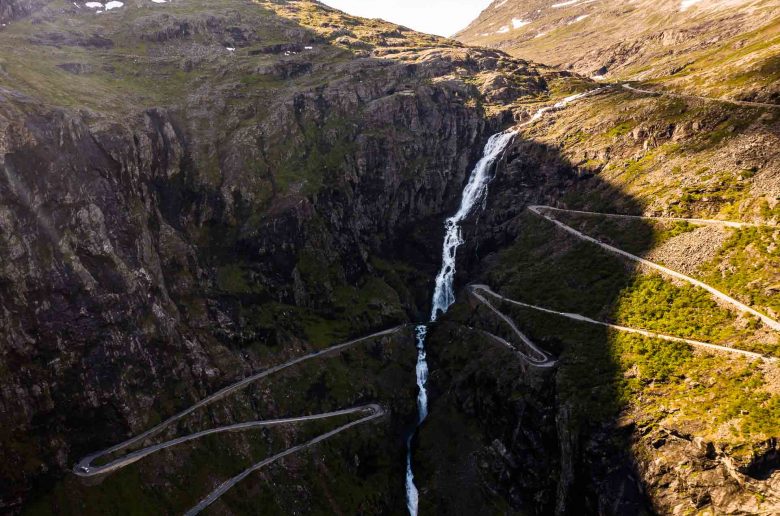
Ferries from Germany
The most common option is to take the ferry from Rostock in Northern Germany to Trelleborg in Sweden. The travelling time of this passage lasts around 6 hours and can be conveniently done without a cabin. Ferry transportation is usually not the cheapest way to travel if you bring your camper but if you want to avoid long distance driving it is a great option.

There is also an option to ship directly to Helsinki in Finland from Travemunde offered by the operator Finnlines. This takes considerably longer (29 hours) and does not come cheap. You’ll also need a cabin since it is not allowed to enter your vehicle – parking decks are locked during the passage. To Norway the operator Color Line offers transportation from the Kiel to Oslo within 20 hours.
Most common ferry routes to Sweden, Norway and Finland from Germany:
Ultimately the choice of which route to take is of yours. If you want to get primarily to Finland the Baltic route is a great option in our opinion. We travelled this way several times and if your destination is Helsinki, the lake lands or the lower central part of Finland you’ll be there faster.
If time does not matter and Finland is of the radar anyway then the route via Trelleborg is our option of choice. Be prepared that the Southern parts of Sweden are more densely populated and finding a scenic place for an overnight stay is not as convenient as in the North.
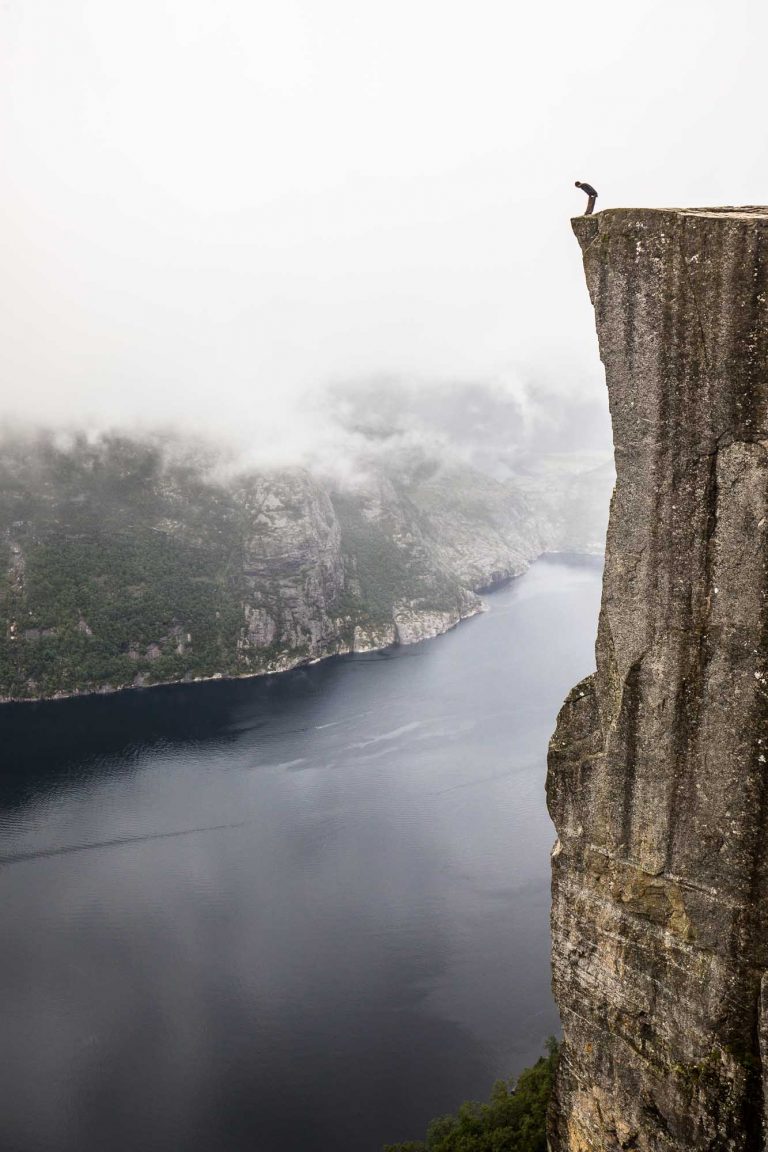
Ferries from Denmark
There are several options to take a ferry from Denmark to either Sweden or Norway. If you want to get to Norway as fast as possible, the ferry service between Hirtshals in Denmark and Kristiansand in Norway is the fastes option.
If we travel to Norway we usually take this ferry service.
Rent a camping vehicle in the North
You can rent your motor home in all three capitals and other major cities throughout the North like Rovaniemi or Tromsø. Especially if you do not have a lot of time or do not like to drive long distances flying into Lapland and renting a motor home can be a good option. Pricing varies on the type of vehicle and add-ons. In most offers you have to pay for features like bed sheets, kitchen inventory, navigation, camping equipment, chemicals for the toilet etc… in addition. Cheapest offers start around 100 € per day but a 120 € to 180 € / per day range is more realistic. Fuel not included! So for those who want to spend several weeks / months in the North this option is likely not the most economic one. If you want to have an independent and spontaneous style of travelling over a short period you should consider it.
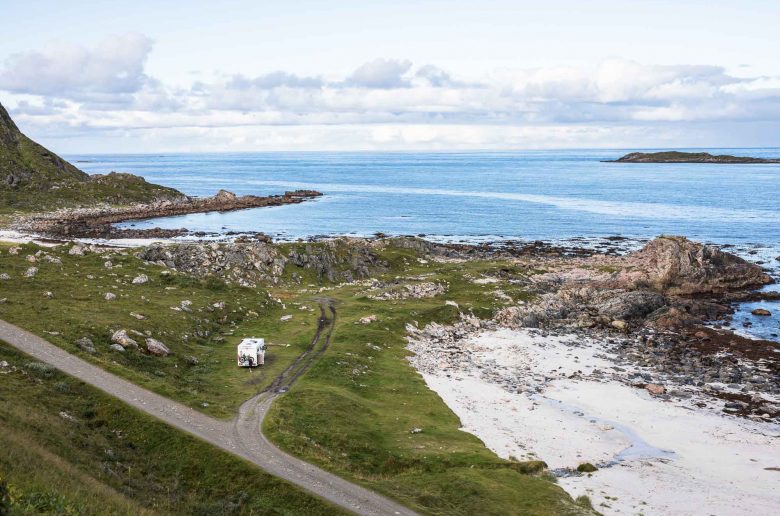
Are there rules for camping with a motor home in the North!
Yes. Parking your vehicle on the roadside is allowed too as long as it is not a hindrance to others. To drive on a private road with a motorized vehicle you need the permission of the landowner. Usually the access to such private roads is restricted with a physical barrier (e.g. boom) or a traffic sign. Driving off road is prohibited without the permission of the landowner. In reality if you plan your overnight stays along a normal road – which does not necessarily mean paved – you’ll always find resting areas, parking bays or spots where you can obviously park your vehicle. As long as you do not disturb the privacy of others and follow the general rules , no one will tell you to leave. In our experience the rule of thumb is that the further you go north the easier it is to be alone and find a sleeping spot with some privacy and atmosphere. The southern parts have simply a higher population density and most of the tempting or good looking spots are private. Many parts in urban areas can also be restricted for over night stays but you can usually always find a spot for one night without a problem.
For general information on camping in the North look here
What are the differences regarding motorhomes between Norway, Sweden and Finland?
Generally not too much. In Finland you are allowed to drive your vehicle off road with the permission of the land owner – this is something you absolutely can not do in Sweden or Norway. In Finland a community can prohibit overnight stays in a camper. In Sweden the duration to stay on a parking place is limited to 24 hours.
Generally fuel is most expansive in Norway except for Hammerfest where you can find some of the cheapest gas stations at all. Finland is usually the best option to take on fuel but it will still not come cheap compared to prices in central Europe. Be aware that there can be long distances between gas stations so it is advisable to take some fuel rather sooner than later.
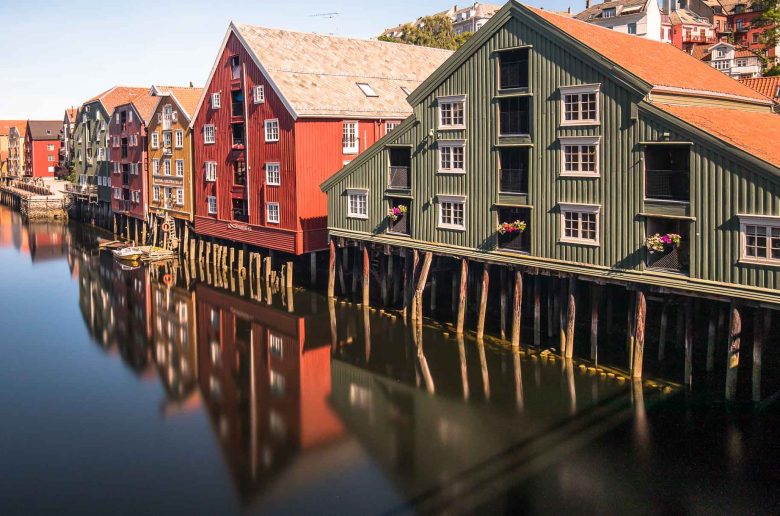
Roads and conditions
Roads are usually in a good condition and due to low traffic the driving is smooth and easy – at least in summer. In more remote places and in Lapland smaller roads are usually not paved and can be bumpy so you might want to adjust your speed accordingly. Driving with caution is always necessary since the biggest risks on the road are animals like moose and reindeer. They are plentiful so take this very seriously.
In winter the main roads are usually well maintained and you can drive with a normal front wheel drive. Winter tiers are mandatory! In Norway some of the mountain passes can be closed temporarily but they are usually free after some hours. Smaller roads in the Finnmark area have special schedules. In the winter months they feature only one lane over big distances so the traffic has to be regulated with fixed schedules. You can pass usually several times a day on most places. Be also aware that temperatures can get to -30° C and that your average vehicle might not be prepared for such conditions.
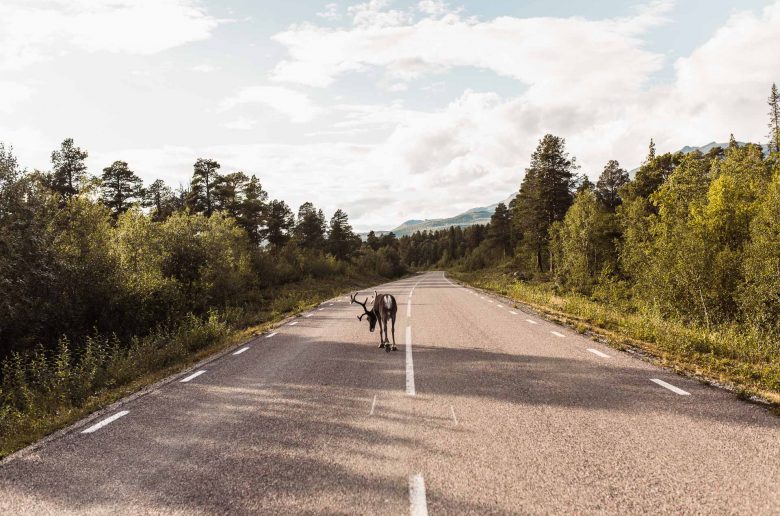
Self-Sufficient or campsites
Finland, Sweden and Norway are all excellent countries to plan an autarc camping trip. You can refill drinking water on every decent gas station for free and since there are so many beautiful places you can set up your base every day on a different scenic spot. There are also many public places where you can empty your chemical toilet. So unless you need permanent electricity or sanitary facilities you can spend a long time on the road.

However, campsites can make perfect sense from time to time. In bad weather conditions it is a great opportunity to do some laundry, get a proper shower and visit a Sauna. So yes, even though Scandinavia is a dreamland for camping adventures in the wild, using official camping facilities can be a good idea.
The various options range depending on your budgets and needs and you can camp in the middle of Stockholm or rent a cabin somewhere in Lapland. There are options for all budgets year round and you can even stay in a dome tent with 180° aurora view in Lapland or an all inclusive yurt experience further south if this is what you want.
Most of you are probably looking for the more traditional campsite for your camper. The good news is that there are over a thousand campsites all over the Northern countries with enough space to host your stay. They can vary drastically in size and quality and while consist literally of a meadow, one shower, one toilet and a stove, others might give you a luxuries experience beyond your expectations. A motorhome will coast you around 20 to 30 Euros per night and you have to calculate additional coasts of electricity and eventually shower. Some campsites offer a year round service but usually they close or provide only cottage rent.
Free shelters and fire places
If you are interested in finding free shelters and public fire places along the road you can take a look into our Northern shelter guide. Especially Finland has one of the best (if not the best!) infrastructures regarding free shelters in the whole world.
- Finland : Find wilderness huts and shelters in Finland
- Norway : Find free wilderness huts and shelters in Norway
- Sweden : Find free shelters in Sweden
- For detailed information about shelters in the North read: The guide to wilderness huts and shelters in the North
Find free wilderness huts and shelters in Norway – a detailed guide
Find day huts and shelters in sweden – a detailed guide, the guide to wilderness huts and shelters in the north, find wilderness huts and shelters in finland – a detailed guide, useful things to bring.
Despite the standard repertoire like a camping chair and table you should consider some of the things from the following list that we deem very useful:
A proper wilderness axe will help you to get your campfire going. Furthermore, you can use it as a hammer or do rough carving jobs with it. It’s a great tool that might come very handy, especially if you spend time in wilderness areas.
A good camping shovel is always a recommended feature. You can dig out your vehicle, make a lowered fire pit in case of strong winds or burry your leftovers and about a thousand other things.
Outdoor knife
A proper outdoor knife is the Nr.1 thing to have and your tool for everything. If you do not have one already you can visit one of the Northern knife factories for yourself or save up for that original Sámi knife.
A really great way to experience the North is by bringing a Canoe, Kayak or other swimming vehicle. If space is an issue you can opt for an inflatable or folded canoe. The Austrian company Grabner and the (considerably cheaper) Czech counterpart Gumotex have some excellent solutions for all needs and most budgets.
Fishing gear
If you like to eat and/or catch fish you definitely should to bring your fishing gear along. The Northern countries feature the best fishing grounds in Europe and should not miss out on this opportunity.
Mosquito repellent
A proper repellent against mosquitos can save your sanity. Some northern parts can be pretty unpleasant during summer, so some protective measurements are a must have if you plan to got to Lapland during late spring and summer. Our weapon of choice is actually a technical repeller device.
Mosquito net
If you have a camper van or mobile home you may wake one night to the buzzing sound of uncountable uninvited guests. Usually one mosquito around the bad can give you a hard time sleeping but a hundred will give you the creeps. Especially in older models, there are sometimes leaky spots where they can enter. And with spots we mean also places that you would normally not likely consider like the air filter, side mirrors or window seals. A good strategy for such a scenario is to have some spare mosquito net fabric that you can use to improvise if necessary. You can buy that in every bigger hardware store around the Northern countries.
Duct Tape & Sealing
This might sound funny but some sort of durable tape should be in your standard car kit for quick repairs. Some places in the North are fairly remote and if you have to bush fix a leaking roof or a fender this can save your day.
Find more inspiration in some of our other poster designs
All the mushrooms – poster, norwegian marine life | marint liv i norge (poster), scandinavian birds | poster, whales of scandinavia | poster, butterfly spectrum | lepidoptera (poster), trees of northern europe | poster, european moths poster, kingfisher poster | alcedinidae, apoidea poster | european bees | europäische bienen, scandinavian wildlife | skandinavische wildtier (poster), wild fruits & berries of the north, coleoptera poster | european beetles | europäische käfer | (1000 bugs), birds of sweden | svenska fåglar (poster), scandinavian fish | skandinaviska fiskar | skandinavische fische – poster, all the fantastic fish – poster, cephalopod vortex | poster.
Read more about mosquitos and protection in our mosquito guide: Survive mosquitos in Scandinavia and Finland.
Survive Mosquitos in Scandinavia and Finland
Read more about catching fish in the North in our Fishing guide: Catch a fish in Scandinavia or Finland
Catch a fish in Scandinavia or Finland – a detailed guide
Shore fishing spots norway.
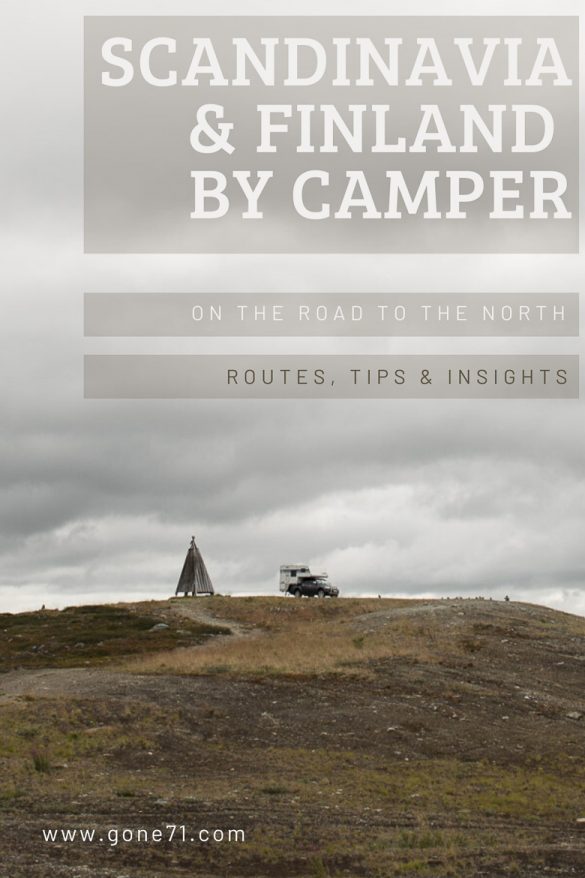
10 fish to catch in the North. Fishing in Finland, Sweden and Norway.
Camping in scandinavia and finland – the right to roam, you may also like, catch a fish in scandinavia or finland –..., norwegian marine life | marint liv i norge..., find free wilderness huts and shelters in norway..., wild garlic – pesto and other delicious dishes, camping in scandinavia and finland – the right..., 10 fish to catch in the north. fishing..., encounter whales and dolphines in norway (on your....
This website uses cookies to improve your experience. If you continue on this site we'll assume you're ok with this. Accept Read More
Join our Adventure: Get all my insider tips for motorhoming & road trips
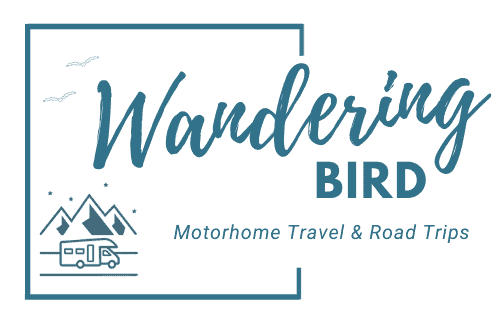
Motorhoming & Campervanning in Norway- your Complete Guide

Planning a motorhome or campervan trip to Norway? Want to see some of the most breathtaking places in Europe? Here’s everything you need to know to go campervanning or motorhoming in Norway, including routes and places to visit.
Don’t forget to download your FREE Europe motorhome travel checklist below to help you plan your Norway road trip.
*We work hard to make this the best motorhome travel blog and road trip website possible, full of helpful content for you. The website is supported by our readers, so if you buy through links on this site we may earn a commission- at no extra cost to you. All opinions remain our own .
If you find this post useful, you can also treat us to a coffee – we promise to enjoy it while creating more useful content like this- we might even indulge in a biscuit (or two!)
JUMP AHEAD TO...
Motorhoming in Norway – why you should go!
If you want to take your motorhome to some of the most breathtaking scenery in the world (not just Europe), you have to find time to get to Norway.
Seriously, we’ve been touring Europe in a motorhome for years- and Norway still blew it all out of the water.
The fjords, the mountains, the glaciers- it’s just all… I run out of superlatives. And even better, they LOVE motorhomes and campervans. Wild camping is allowed pretty much anywhere and there are so many incredible places to stay- choosing is often the hardest part. Add in how friendly and welcoming the people are, and it’s pretty much the perfect motorhoming destination.
In this post, we’re going to share with you everything you need to know to go motorhoming or campervanning in Norway, including getting to Norway and planning your route, where to stay (motorhome campsites, aires or wild camping with your camper), some road trip itineraries and places to visit, driving tips and other practical advice to help you have an amazing Norwegian road trip. If you’d like to see our costs, you can read how expensive our road trip to Norway was here
If this is your first campervanning trip to Norway (or Europe!), don’t forget to grab your free motorhome travel checklist which will help you plan and organise everything you need.
Planning to take your motorhome to Europe?
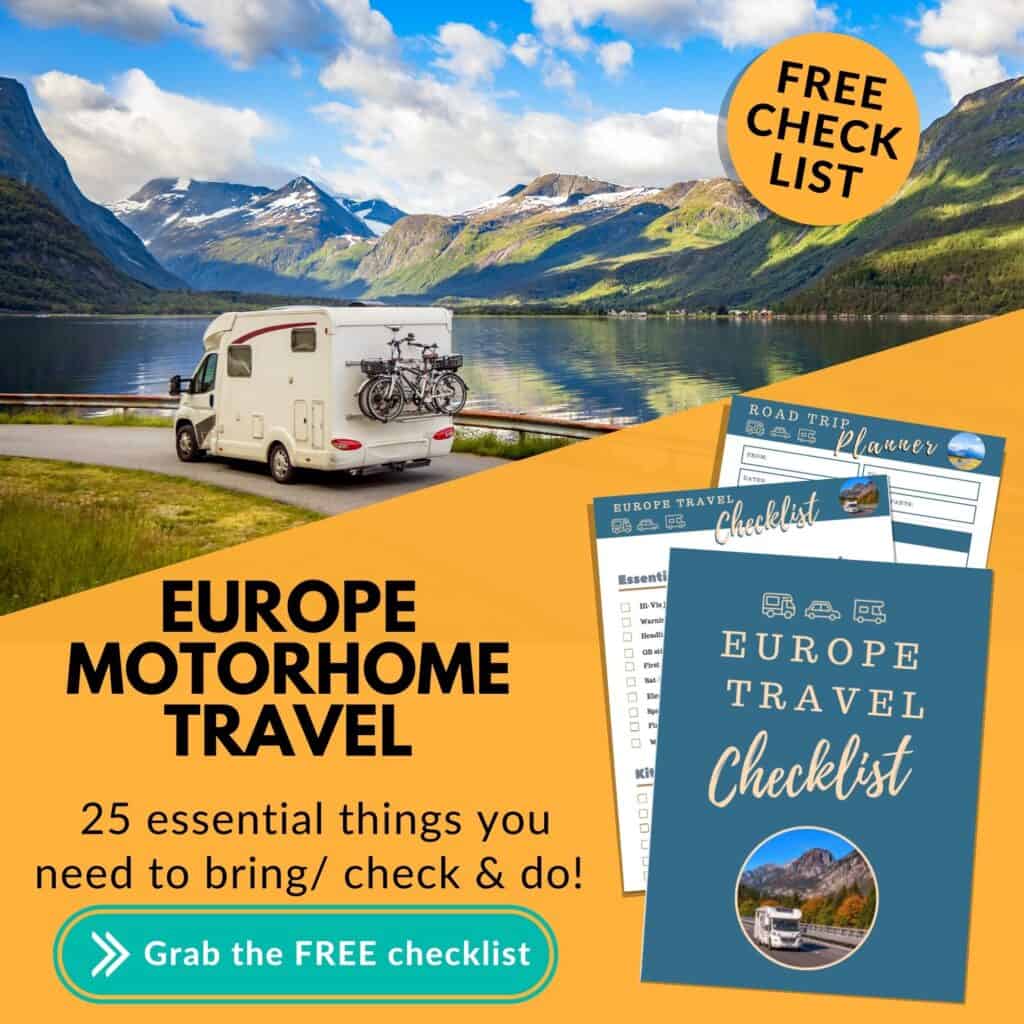
GUIDE: Stop the overwhelm with our step-by-step guide. Contains eBook, checklists and more. Complete Europe Motorhome Travel Toolkit
CHECKLIST: Don’t forget to grab your FREE Europe motorhome travel checklist HERE
GEAR – If you need any motorhome gear for touring Europe, here’s what we recommend.
Campervanning in Norway – Where to go
When planning a motorhome trip to Norway, the first thing you need to do is decide where you’re going (and how long you have for your adventure!)
How long to go for?
If you’re driving from the UK to Norway (we’ll cover that shortly), you need to allow at least 3 days to get from arriving in France (by either ferry or Eurotunnel ) to get to the Norwegian border. And that’s 3 days of pretty much solid driving.
We don’t recommend visiting Norway if you only have a week or even 10 days for your road trip. It’s too far and all you’ll do is drive there and back. Of course, if you’re going to rent a motorhome and fly in, that’s perfectly doable in a week (more on that shortly).
If you have a couple of weeks, you can certainly explore some of the best places in Southern Norway , but again it will be a lot of driving. We went for 3 weeks, and we still didn’t get as far as we wanted to.
Map of our Norway Motorhome Tour
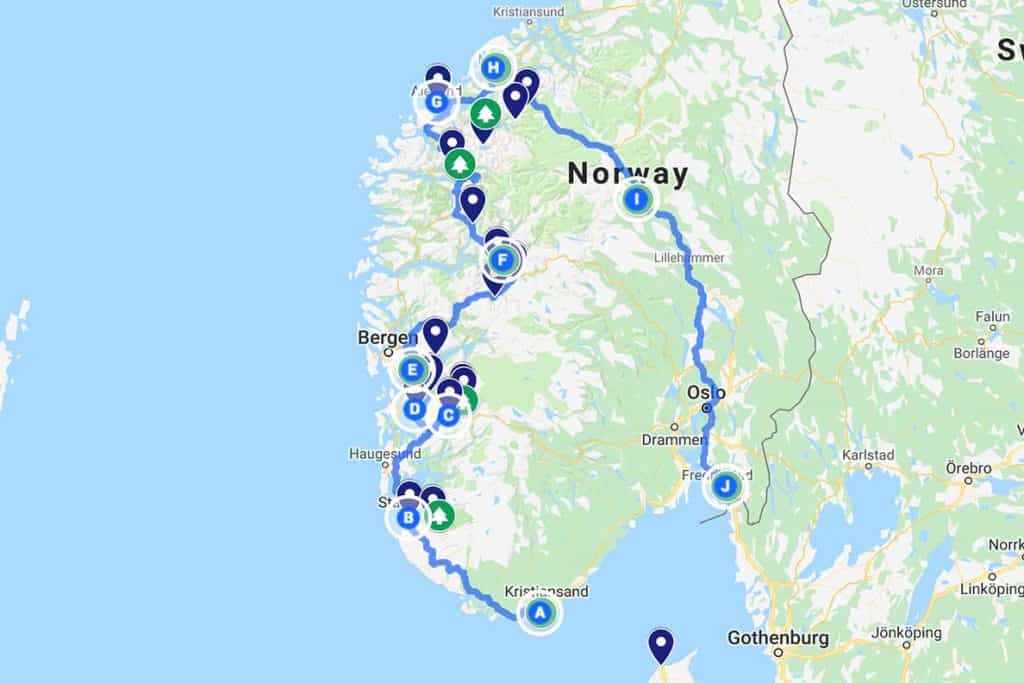
Don’t forget, the best roads are the coastal roads, but they are also the slowest roads. So ideally save your motorhome trip to Norway until you have a block of 3 or more weeks so you can really enjoy it.
Norway is the longest country in Europe, and it takes about 30 hours to drive from Kristiansand to Hammerfest in the north- if you go the direct roads down the middle (which is also the expensive toll road!) It took us 2 days to drive back from near Kristiansund to the Swedish border (route ‘I’)
Don’t overestimate how far you can travel in one day. The roads are much slower than you might be expecting- not helped by all the ferries between places. There are a lot of single track roads which will slow you down.
TOP TIP: If you’re trying to get to the north of Norway, go up through Sweden- the roads are faster and also toll-free.
Some of our favourite places in Norway
Here are some of the highlights from our time motorhoming in Norway (so far!)
- Trollstigen Road – one of the best driving roads in Europe
- Driving the longest road tunnel in the world
- Steinsdalsfossen Waterfall – the one you can walk behind
- Sverd i fjell – the swords in the rock
- One of the best campsites in Norway (with AMAZING views)
- Flamsbana Railway – voted one of the best train rides in the world
See all our Norway tips and destinations here
The Visit Norway website is a wonderful resource for finding places to visit, plus motorhome services, petrol stations and other useful tips.
Watch the video of our Norway motorhome trip
Here’s a copy of the speech I gave at the NEC Camping, Caravan and Motorhome show about taking your motorhome or van to Norway.
We hope you found the video useful. If you did, we’d love it if you followed us on Youtube . New videos with tips for motorhoming and campervanning in the UK and Europe are released weekly.
When to go motorhome touring in Norway
We have been to Norway several times- once with a motorhome, twice by air. We planned our motorhome trip in mid-July, and it rained solidly for 3 weeks (and yes, it was STILL one of the best motorhome trips we’ve done!)
We’ve also been in late November and early March, both times to see the Northern Lights (Norway is one of the best places in Europe to see the Northern Lights )
So, the answer on when is the best time depends on what you want to do. Norway only really has two seasons- summer and winter. Spring and Autumn do happen, but they are quick and unpredictable.
Norway in Winter
Norway is further North than Scotland, so expect snow- and a lot of it. It gets COLD in winter. Very very very cold. Anytime after October until early April is considered winter. You will definitely need proper motorhome or campervan heating to stay warm.
Also, don’t forget that Norway doesn’t get much sunlight in winter, and what it does get is pretty weak. So you don’t have as long during the ‘day’ to explore, even if you are happy to drive in the snow and ice.
The main roads are kept pretty clear, but more remote areas might be impossible to access, even with winter tyres fitted on your van. You’ll probably also need to winterise your motorhome before you go.
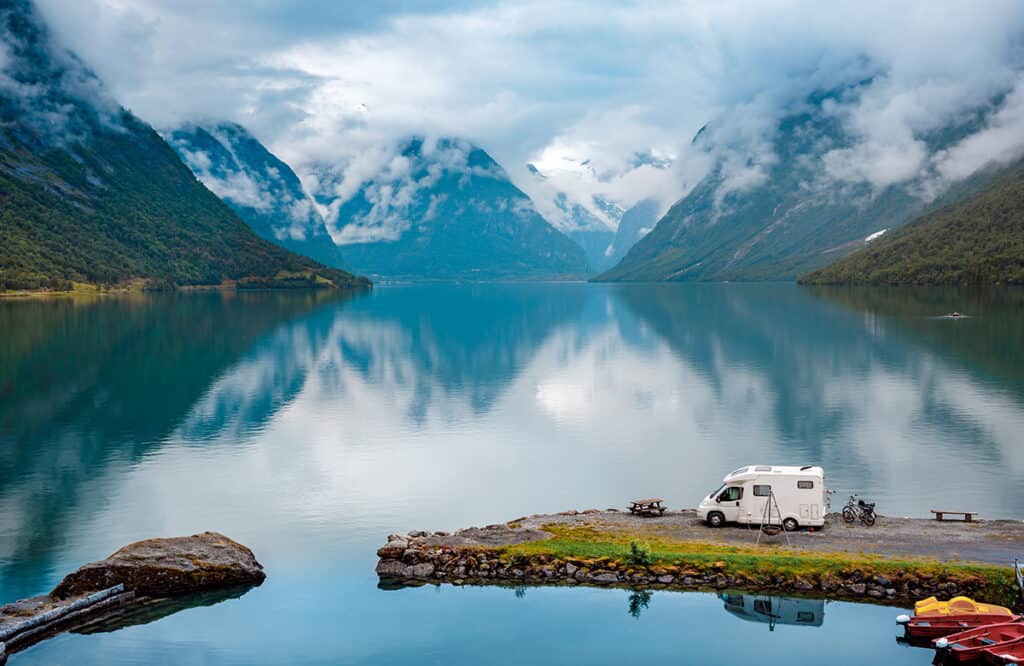
Visiting Norway in Summer
Summer is by far the best time for a road trip to Norway. The days are long, the weather is surprisingly warm and even though it rained a lot, it was still pleasant to explore. (It doesn’t ALWAYS rain in summer- I’m just a rain magnet!) The roads are usually fully open from May until October.
Mid-summer is a HUGE deal in Norway (and most of Scandanavia). There are parties to celebrate the midnight sun- especially north of the Arctic Circle, but the long hours and light evenings can make it hard to sleep- make sure you find a way to get your rest if you’re doing a lot of driving.
It is possible to see the Northern Lights as early as September, especially if you’re to the far North of Norway, but don’t worry about visiting in August or peak season- the cities might be busy (especially those with cruise ship ports), but otherwise, the country is blissfully uncrowded and there are plenty of places to stay.
Planning a driving route from the UK to Norway
There is no direct ferry from the UK to Norway, so you’ll need to drive at least part of the way.
You can drive all the way through Germany, Denmark and a bit of Sweden (using the Oresund Bridge) to get into Norway or take the ferry from the top of Denmark (Hirtshals) to Kristiansand (quickest), Langesund, Stavanger or Bergen.
(Don’t forget that Denmark uses the Krone, not Euros)
Ferry to Norway from Denmark
The fastest route to Norway from the UK is using the Colorline Hirtshals- Kristiansand ferry. Hirtshals is a town right at the top of Denmark and driving to Hirtshals from Calais takes 12 and a half hours (1264km)
NOTE: Don’t confuse KristiansAnd with KristiansUnd- I set the wrong course in our motorhome sat-nav and it went very wrong!! You can see both places on the map above to understand why!
The Hirtshals ferry takes about 2 hours (which isn’t too long in case the dreaded North sea is having a bad day!) There is also a ferry from Hirtshals to Bergen in Norway, but it meant missing out on a lot of the stuff we wanted to see further south.
When we went in 2018, we paid 462.20€ (yes, Euros, not NOK), which was for 3 adults and an 8m motorhome PLUS a trailer. You can read more about our experience on the ferry from Denmark to Norway here .
In 2023, a 7m motorhome WITHOUT a trailer, with 2 adults, costs around 238€ one way (advance price)
There is also a route from Frederickshavn (Denmark) to Larvik (Norway) and Copenhagen to Oslo.
A new ferry route opened in 2022 from Eemshaven (Holland) to Kristiansand, which can cut your driving time down considerably- if you can get a space on it! It’s an 18h ferry and costs around €700 one way (2023 advance prices)
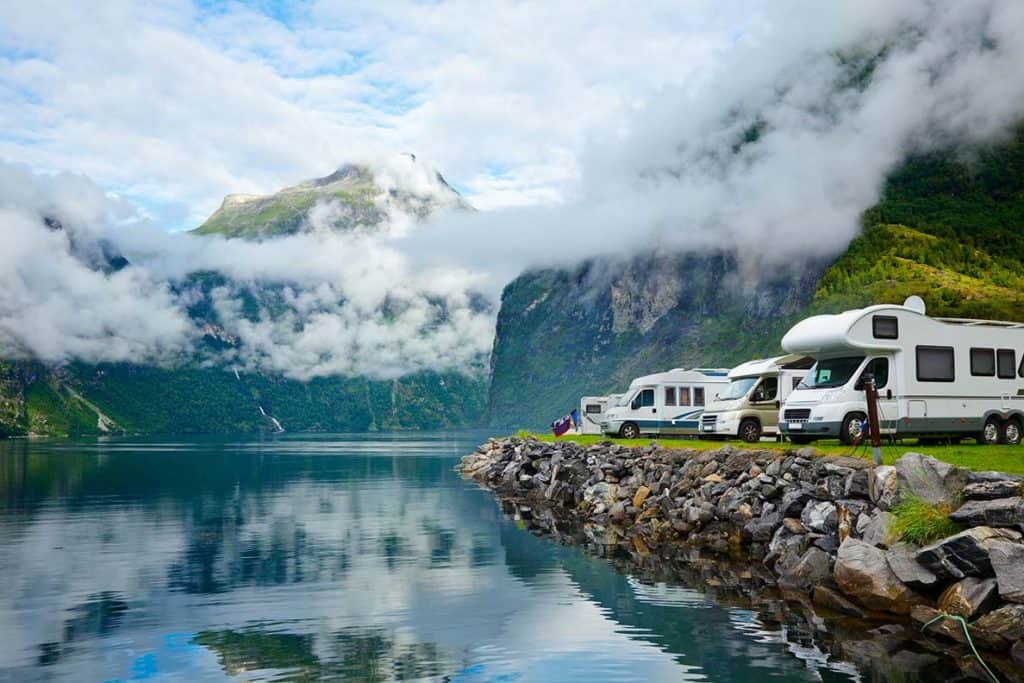
Øresund toll bridge- driving via Sweden
If you don’t want to take the ferry, the only other way to get into Norway with your vehicle is to drive via Sweden. This route is about 1580km from Calais to the Norwegian border and Google maps thinks it will take just under 18 hours (that’s probably very optimistic!)
The upside to this route is you don’t have to pay for a ferry. The downside is you have to pay for tolls on both the Øresund toll bridge and the smaller Storebælt toll bridge in Denmark.
When we went in 2018, the Øresund Bridge and the A/S Storebaelt cost us £275 one way.
Currently (2022), a 7m camper or motorhome (without trailer) costs 130€ (it can be cheaper if you pay in advance here. )
Storebælt toll bridge- 2022 prices for a motorhome between 6-10m (without trailer) and under 3.5tonnes is 75€
Other motorhome and campervan routes into Norway
Of course, if you have a couple of months, you can get into Norway from another direction. Perhaps you choose to drive up through Sweden, then enter up at the North and drive south through Norway.
Or you could even go via Poland, Latvia and Finland and make it a proper Scandanavia motorhoming adventure!
New to motorhome or camper travel in Europe? You might find these posts helpful:
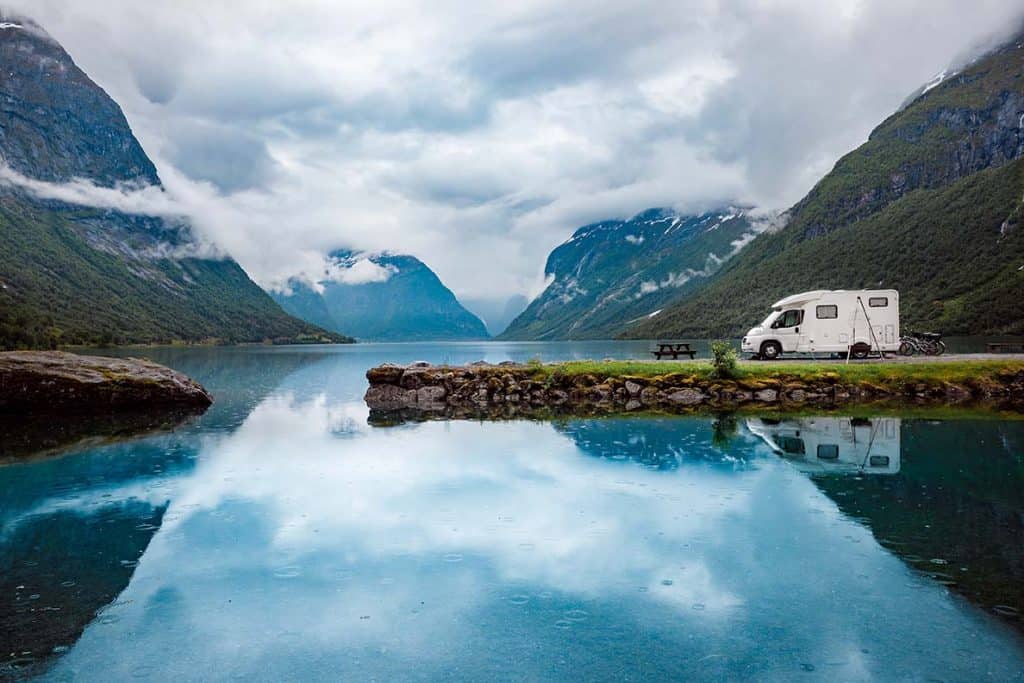
See all our Europe motorhoming posts here
NEED GEAR? If you need any kit or essentials for motorhoming in Europe, here’s what we recommend and where to find it
Norway Border Control/ Customs
Norway is not in the EU and therefore there IS a hard border between it and its neighbouring countries (unlike much of Europe.)
With this in mind, you are only allowed to carry over a certain amount of alcohol and tobacco, even if it’s for personal use- see the current allowances here .
You also need to complete a customs declaration form before you enter the country (which we only discovered at the ferry port and had to hastily complete. One of the funniest things was watching people who didn’t realise there was an alcohol allowance- they decided to make a party of it and were giving away their alcohol (and drinking as much of it as they could!)
Norway Customs app
By far the easiest way to declare and pay any customs charges is via the Norwegian Customs app . You can download it onto your phone/ iPad, fill it in, pay anything owed and then you can use the green channel when you arrive in Norway.
Expect your motorhome to be stopped and searched and have your paperwork ready. Don’t forget about dog paperwork too
Hiring a motorhome to tour Norway
If you don’t have your own vehicle, or don’t have time to drive to Norway, there are plenty of hire companies who rent out motorhomes or campervans.
Expect to pay around £700 to £1000 a week for a small vehicle and go up from there. Prices are much cheaper in winter than in high season.
Of course, if you’re hiring a motorhome, you’ll have other factors to consider. If you’re flying in, you’ll need to pick an airport near the area you want to explore.
Then you’ll need to find a hire company with a base near there and plan how to get from the airport to the campervan. If you want to do the North of the country, Tromso is a great starting point. For the south, Oslo or Bergen might work well for you.
Lastly, you’ll need to figure out how you’ll bring all your kit (which might need to include things like bedding, towels, pans and other essential vanlife gadgets , as most hire vans don’t come with much in them at all.
Want to rent a vehicle for your road trip?
These might help:
- Discover incredible deals for motorhome/ camper rentals
- Find the best deals for car rental
READ: 10 essential questions to ask before you rent a motorhome
Essential kit to carry when motorhoming or campervanning in Norway
In Norway, as with most countries in Europe, there are certain things you need to carry with you in your motorhome or campervan- although Norway is not as strict as many of the other European countries.
Don’t forget, if you are driving through other countries in Europe (which you probably will be, you need all the required kit for THOSE countries, as well as the stuff for Norway . If you’re used to motorhoming in France , you’ll already have everything you need.
Don’t forget to grab your FREE Europe motorhoming checklist below
Things you need to drive in Norway- safety gear
There are some safety items you should carry:
- Hi-vis reflective jackets – one per person (These MUST be accessible without getting out of the vehicle- ie, don’t keep them in the garage unless you can reach them from inside!)
- Warning triangle
- Headlight beam converters – unless your headlights can be adjusted to European driving
- UK sticker attached to the back of vehicle or reg plates (and trailer if you have one)
- First aid kit – compulsory in France and Germany. Find out what we carry in our European first aid kit here
TOP TIP: Buy these essentials for driving in Europe BEFORE you get to the border- prices at Eurotunnel or on the ferry can be two or three times as much. Here’s what you need from Amazon , which is cheaper than Halfords or the high street.

Road trip accessories you MIGHT need for a motorhome holiday in Norway
Winter / all season / studded tyres.
Norway requires different tyre tread depths between summer and winter. If you are planning your road trip in Norway between 01 November to the first Sunday after Easter Monday (inclusive), the required tread depth is at least 3 millimetres.
In Nordland and Troms og Finnmark , the requirement for a tread depth of at least 3 mm applies from 16 October to 30 April (inclusive.)
At all other times, tyres are required to have a tread depth of at least 1.6 millimetres.
The vehicle must have winter tyres (studded or non-studded), chains or similar also outside of the periods mentioned above if this is necessary in order to ensure sufficient road grip.
If studded tyres are fitted to a car/ van weighing under 3.5 tonnes, they must be fitted to all four wheels. Vehicles with a permitted total weight of 3.5 tonnes or more must carry snow chains if ice or snow is expected. These snow chains must fit the vehicle’s wheels.
The cities of Trondheim and Oslo have a fee for city centre driving with studded tyres , in order to limit the pollution produced by studded tyres.
Snow chains
If you’re travelling Norway in a motorhome in winter, you will need to carry snow chains. You may be asked to show these at the border and even asked to demonstrate that you know how to fit them. If you don’t have any, you will be asked to purchase a set.
Get a full list of the essential kit and paperwork needed for motorhome touring in Norway and Europ
What documents do you need to drive in Norway?
If you’re motorhoming in Norway, you need to carry the following documents:
- Passport (or identity card)
- Driving licence (check it is in date!)- Yes, you can use your UK one.
- Motorhome Insurance documents- check you are covered for driving in Europe
- Breakdown cover
- Vehicle V5 logbook (which must show your correct address)
- Vehicle must be legally taxed and MOT’d
- Trailer certification
- Green card (get from your vehicle insurer)
- International Driving Permit if required
- Personal travel insurance
Do I need an international driving permit to drive in Norway?
Most UK citizens do not need an IDP to drive in Norway, as long as you have a card driving licence issued in the UK (in date, of course!)
You might need one if you have:
- a paper driving licence only
- a licence issued in Gibraltar, Guernsey, Jersey or the Isle of Man
(If you do need an IDP, here’s an in-depth guide on how to get an International Driving Permit and which one(s) you need from a UK post office.
Motorhome touring in Norway- Other useful things you might need
We’ve been touring Europe in our motorhome for several years. We’ve tried all sorts of kit- some useful, some not so much.
Here is a list of things we highly recommend when motorhoming in Norway, but which are NOT essential:
- Motorhome WiFi – learn our favourite way to get internet on the road
- Toll pass (see below)
- TV- If you’d like TV in your motorhome or camper , here’s how to get it.
- Motorhome sat-nav – get one you can enter your motorhome dimensions into, like these
- Motorhome security camera – this thing is GOLD for allowing us to go exploring and leave the van for a short time.
- Solar panel- perfect if you want to wild camp in Norway with your motorhome.
- Inverter- a motorhome wild camping essential
- An awesome motorhoming logbook to record and remember your adventures!
Campervanning in Norway – motorhome overnight stopovers and parking
Norway is very welcoming to motorhomers and campervanners. There are plenty of places to stay- both paid and free and they have a wonderful freedom to roam law- we’ll get to that shortly.
Motorhome campsites in Norway
Campsites in Norway are much like campsites anywhere else in Europe. There is a good network of campsites and they’re often quite rustic (although the one we stayed at had amazingly clean and modern toilets and showers,) but there was no bar or restaurant or communal areas. (Expect to pay extra to use the showers at many campsites.)
In the three weeks we spent touring Norway, we only stayed in a motorhome campsite once- partly because we wanted to use the laundrette, and partly because…well, just LOOK AT THE VIEW!
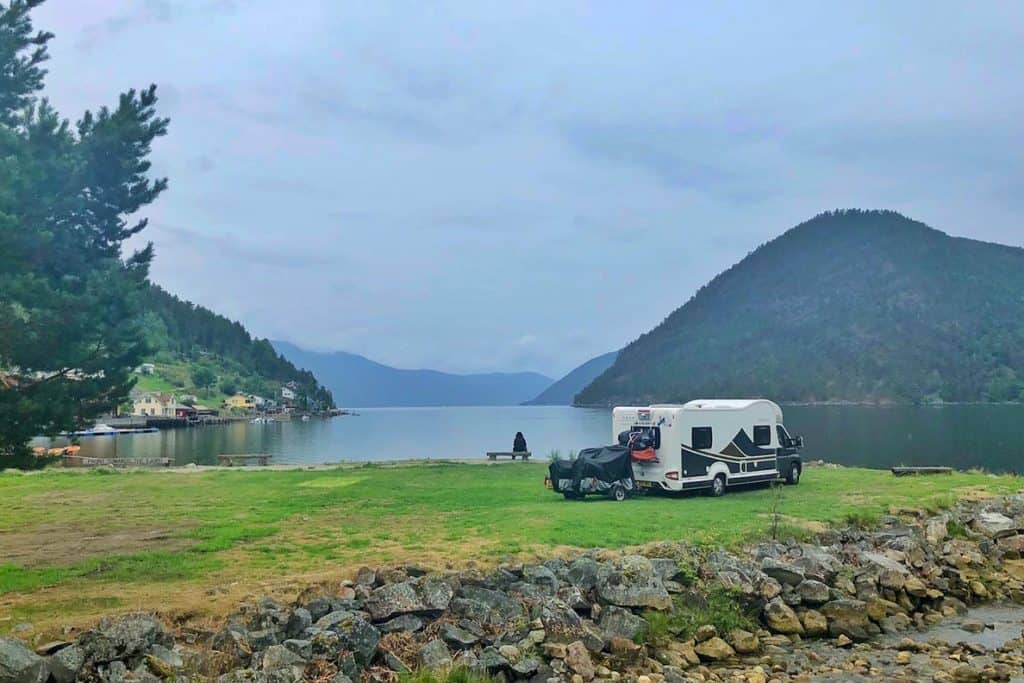
Even with the rain, it was still amazing. You can find out everything about this campsite in Norway here. It cost us 250NOK (at the time that was about £25) to stay without electric. The washing machine was 40NOK per wash- all other facilities were included.
If you’re travelling out of high season and are planning to use campsites, we highly recommend buying an ACSI CampingCard membership – you’ll save a lot of money as we found the campsites in Norway to be quite expensive. But if you’re happy to stay off-grid, save your money and go wild camping.
Aires in Norway
As well as campsites and wild camping, there is a network of aires in Norway.
An Aire is an approved motorhome and campervan overnight parking place, usually provided and maintained by the local town or village council. They often cost a few £ (or NOK) to use them overnight, although you will find some in more remote areas which are free to use overnight. Many of them have motorhome service points- often for a small additional fee.
If you’re touring Norway with a caravan, rejoice! Unlike most of Europe, caravans are welcome on aires.
READ MORE: Discover how we find and use Aires and overnight parking places when motorhoming in Europe
Wild camping in Norway for motorhomes and campers
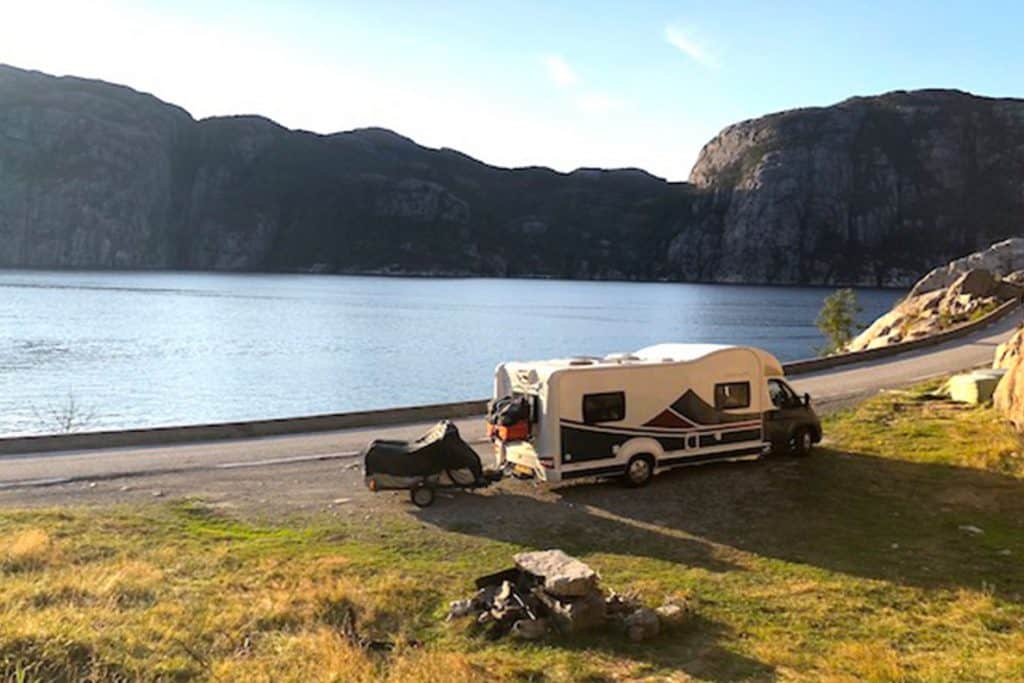
Ok, this is one of the best parts about motorhome travel in Norway- the FREEDOM and the right of access.
If you enjoy staying off-grid and wild camping with your motorhome , Norway is going to be your heaven. It has a freedom to roam law, allemannsrett (all man’s rights) meaning you can wild camp anywhere where the land is not owned, cultivated or where there is a sign forbidding it. We thought motorhome wild camping in Scotland was good, but Norway is better.
You need to follow these rules:
- Stay at least 150m from dwellings
- Stay no longer than 48 hours in one place
- Don’t stay if there is a sign stating no overnight parking
- Don’t put out awnings, chairs and so on- that’s ‘camping’
- Be vigilant about campfires in summer
Motorhome wild camping guides for the UK & Europe
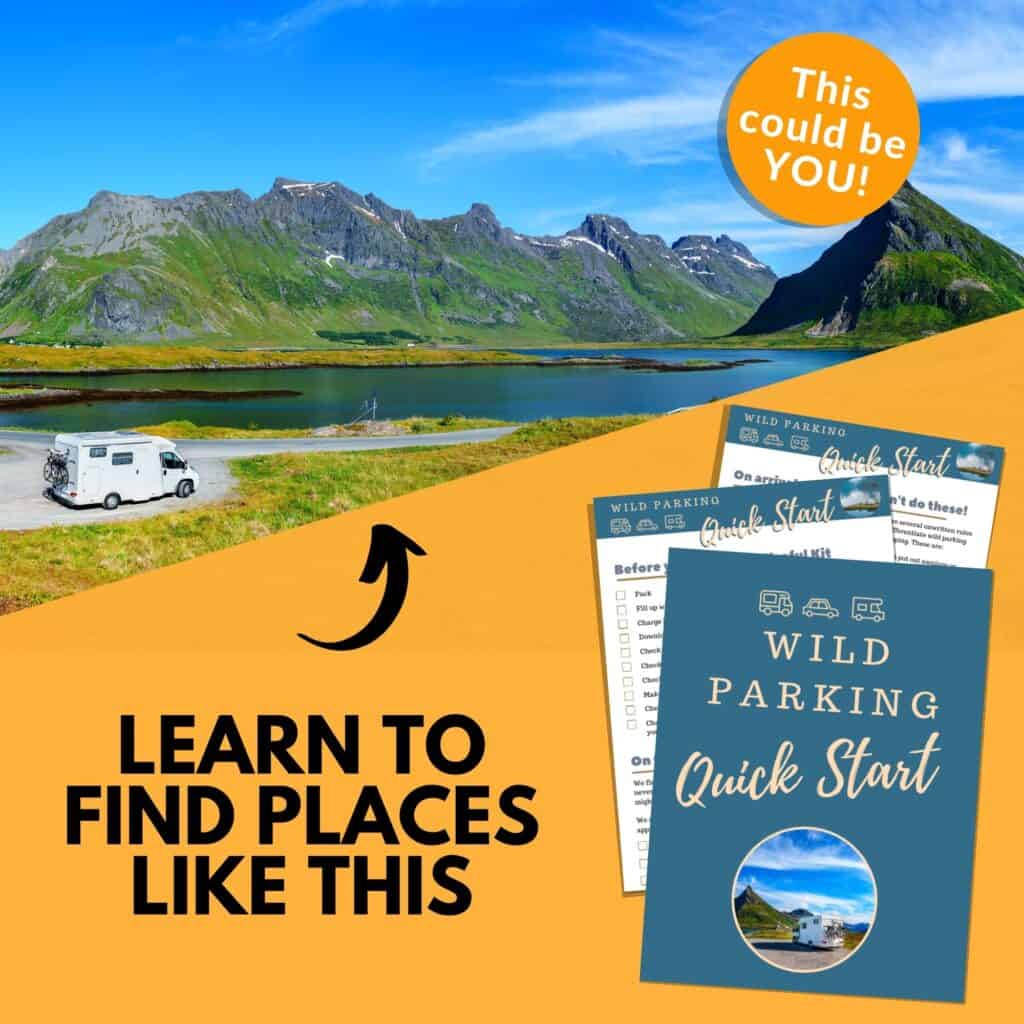
For information on how to find good wild camping places, WHAT to do when you’re there and how to stay safe, check out our step-by-step guide for motorhome wild camping in the UK and Europe, complete with database of 250+ overnight spots we’ve stayed with our motorhome.
Don’t forget to grab your free wild camping checklist here
Motorhome and campervan service points in Norway
Norway is an incredibly clean country free from litter and we urge anyone campervanning in Norway to keep it that way.
There are plenty of rubbish bins, dump stations and water taps almost everywhere. We found them using the Park4night app. Most rest areas had free toilets to use if you wish.
There was only one area where we needed water and couldn’t find it- near Flam- and the mean man at the campsite wouldn’t let us pay to fill up our tank. But otherwise, it was very easy.
At some of the motorhome service areas (Tømme stations) you might need a key from the garage or attendant, especially if using the black waste.
I don’t think we found any taps which WEREN’T drinking water- pretty much all the water in Norway is potable- and is provided freely, so there’s no need to buy bottled water. NOTE: In winter, some water supplies may be turned off at times if the supply might freeze.
Most running water in the mountains and forests of Norway is clean enough to drink, but avoid water running through pastures or runoff from glaciers, as this may contain harmful microorganisms.
Driving tips for Norway
We enjoyed driving in Norway. The roads are much less congested than the rest of Europe, and there’s so much space to spread out and explore. The tolls, tunnels and ferries take a little while to get used to- we’ll go into those in more detail shortly.
Norwegian drivers are pretty calm and happy to wait or give way as necessary. Roads are generally well maintained and roadworks are few, but there are some very narrow roads, especially along the edges of the fjords. You’ll need to get used to how wide your motorhome is- and get used to other vans and lorries coming at you on very narrow roads. The scariest one was down a tiny tiny track- you can watch it at the end of this video:
Be aware of the weather conditions- the mountains can turn hostile very quickly in bad weather. Some mountain passes could close with no warning in inclement weather.
And pay attention to your brakes- going up and down mountain passes can make them very hot… and they could fail like they did on us in Switzerland! To avoid this, drive in a low gear , don’t ‘ride the brakes’ and brake with less force to help the brakes stay cool. (Read more about motorhoming in Switzerland)
When driving uphill, watch the vehicle’s temperature gauge to avoid engine overheating. If you’re planning to go up (or down!) Trollstigen (and you should!) choose your time wisely!
Also, don’t overestimate how far you can travel in one day. The roads are much slower than you might be expecting- not helped by all the ferries between places. It takes around 30 driving hours to go from Oslo up to Lofoten, so plan accordingly.
Here’s an overview for Norway driving rules:
- Norway drives on the right, so stay right and let them overtake on the left.
- You must drive with dipped headlights ALL THE TIME- even on sunny days
- Speeds are in kms- you might want to adjust your motorhome sat-nav settings
- Seatbelts and child safety seats are compulsory
- Using a mobile phone while the engine is on is illegal
- UK driving licences are perfectly acceptable to use and you probably won’t need an IDP (find out the changes made to driving in Europe after BREXIT )
- In cities where there is more than one lane, you’ll often find one reserved solely for buses and taxis- don’t use this!
- Traffic joining from the right has priority on junctions with no ‘give way’ signs or painted lines across the junction
- Passing places on single-tracked roads are marked by a white M on a blue background
- There are currently no restricted emissions zones in Norway, although central Oslo does close to diesel traffic when monitored emissions are considered high.
- Norway has a “human-oriented” culture which puts pedestrians and cyclist first. Pedestrians will expect you to slow down or stop so they can cross the street, and cyclists may not always follow traffic regulations!
Speed limits in Norway
The speed limits are low- another reason you won’t get anywhere as fast as you want to.
Speed Limits are as follows (unless otherwise signed!)
- Motorways/ major dual carriageways- 110km/h (70mph)
- Built up areas- 50 km/h (31 mph)
- Residential areas can be as low as 30 km/h
Speed limits for Vehicles over 3.5 tonnes and/ or towing
Heavy vehicles (over 3.5 tonnes) may not exceed 80 kilometres per hour regardless of the local limit- EXCEPT for motorhomes (camping cars) up to 7.5 tonnes, which are allowed to follow the same speed limits as other vehicles.
Vehicles towing caravans or trailers may not exceed 80 kilometres per hour regardless of the local limit. If the caravan or trailer is not equipped with brakes, the maximum speed is 60 kilometres per hour.
Speed Cameras in Norway
Yep, they have them. Frequently. They are often on bridges but police also do manual checks which can lead to on-the-spot-fines.
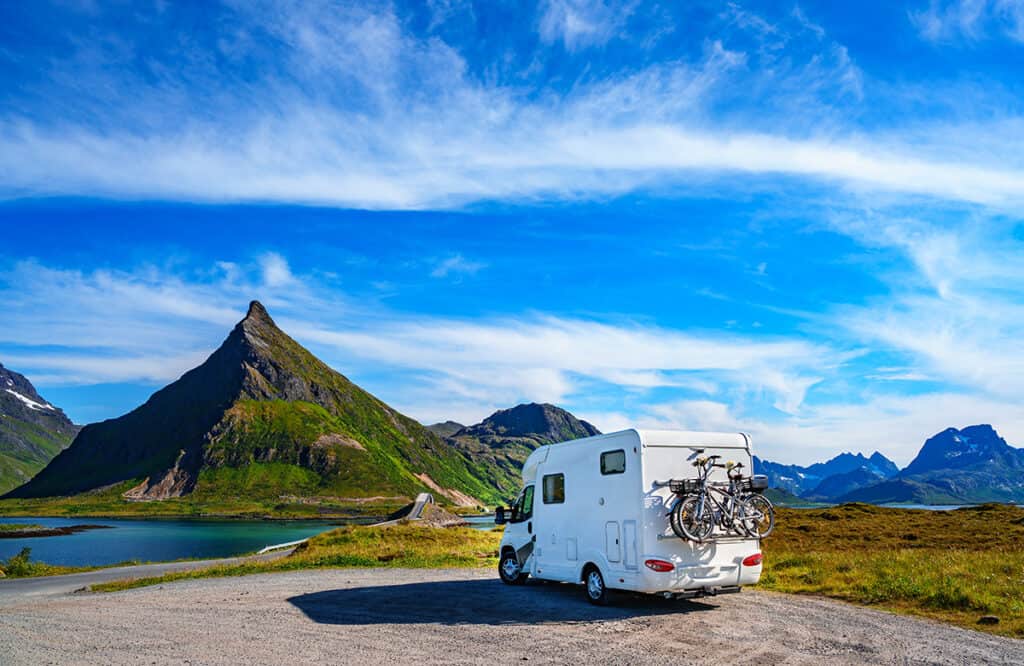
Drink Drive law in Norway
Alcohol laws are very strict in Norway, and penalties from driving under the influence are severe. The legal limit is 0.02% blood alcohol (the UK is 0.08%) and applies to the driver of any motorised vehicle. Medications to avoid if you intend to drive are marked with a red triangle.
Tolls in Norway
If you’re used to motorhoming in Germany or the UK (where there are very few tolls), Norway is going to be a shock.
There are about 200 toll stations in Norway. All of which are automated, and marked with “AutoPASS” and the symbol to the right. Avoiding a toll often means driving hours out of your way AND taking 2 or even 3 extra ferries, so it defeats the point. On the plus side, motorhomes are charged the same price as cars and the total toll costs aren’t usually that high.
The tolls all use number-plate recognition, so before you drive in Norway with a foreign vehicle, you should register
How much are the tolls in Norway?
In total, we went through 23 tolls during our 3-week Norway road trip- and over half of those were on the E6, which is the main road running North-South through central Norway (‘I’ on the map). The cost of that 2-day trip was £84.88 in toll charges.
The other tolls in Norway (around the western edge) came to a whopping £20.06- not bad for 12 days driving! But these are the roads with all the ferries on, so we also paid ferry costs on top of those toll charges.
So the total toll charges for our 3 week Norway road trip was £104.94
How to pay tolls in Norway
There are two options to pay- either get a toll tag or be charged on the EPass24 scheme. On the Atlantic Road, it may be possible to pay manually, but everywhere else is payment card online after you’ve received your bill.
EPass 24 Scheme
Registration is optional, but if you register for an EPass24 account this will normally reduce the time elapsed from the journey until you receive an invoice AND will make sure you pay the correct tariff- failure to register could result in you paying higher charges.
- Register your foreign owned / rented / leased vehicle here
- Drive through the AutoPASS toll lanes without stopping.
- The invoice will be sent to you, based on the information that you have registered (by email if registered, by post if not)
- Pay the invoice online by payment card
Autopass Toll tag
However, if you’d like a discount (up to 20%) on your toll prices, get a toll tag.
These MUST be issued in advance- you cannot buy a toll tag for a private vehicle at the border.
Autopass is the name for the tolls, NOT the name of the provider. There are several providers to register with- visit the Autopass.no website and choose one.
We registered with BroBizz as we had a motorhome over 3.5t and they were very good. I’ve also heard good things about Flyt and Fremtind but not used them personally.
The biggest benefit of a toll tag is a discount, often as much as 20%!
Don’t forget, you MUST register several weeks before you leave so you have time to receive your toll pass in the post.
Ferries in Norway
Norway is full of water. There are fjords and islands everywhere. If you’ve ever been motorhoming in Holland , you might not appreciate the problem… until you realise that these fjords are surrounded by mountains and it’s not easy to build roads over them. So they use ferries. It’s no different from using a tunnel or toll road- just part of the road network in Norway.
The ferries in Norway are not like the ferries between the UK and France. You don’t have to book in advance and they don’t just go a couple of times a day. They’re like shuttles, going back and forth continuously all day (although many do shut for a few hours late at night/ early morning.
There are no ‘cabins’ or requirement to book seats- you stay in your vehicle or can walk around the deck enjoying the view of the fjords. Some ferries take only 20 minutes, others can take nearly an hour. You can see them on your map/ sat-nav.
How to use the ferries in Norway
They are really easy to use, even if they are expensive. You pull up, wait in the queue, a ferry employee either will walk down the line, ask you your length and charge you the fee (one-way). Sometimes you pay when you are onboard. You can pay by card or cash (NOK).
CAUTION: Some places have ferries going to 2 or more destinations. Make sure you line up in the correct queue or you’ll find yourself on a ferry in the wrong direction. Also, some ferries have a stop-off service, so they go to one place, and then another. Make sure you get off at the correct stop!
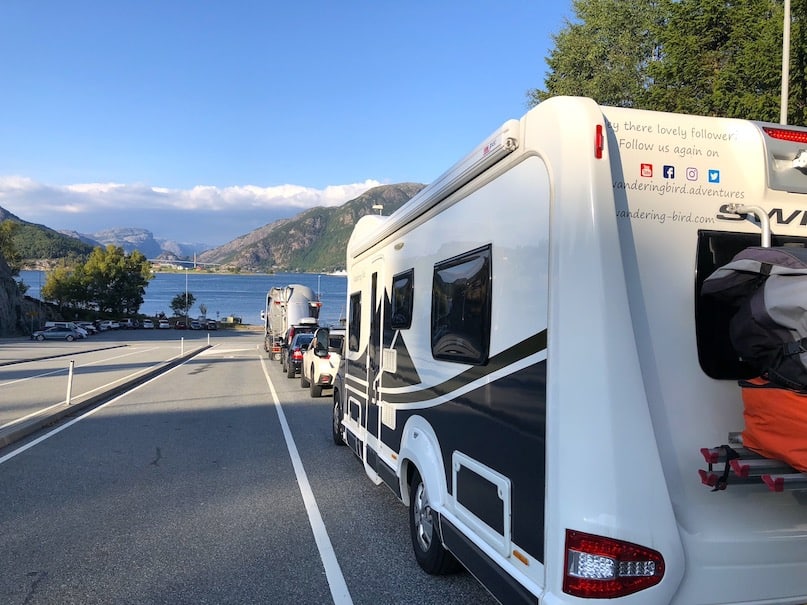
How much do the ferries in Norway cost?
The cost of the ferry depends entirely on your length… as we discovered when we turned up in a 7.8m motorhome towing a 3m trailer. Ouch. Did I mention touring Norway by camper was expensive…
If you are under 6m, you’ll pay the same price as a car, which is pretty reasonable. You can expect to pay around NKR100 for every ten minutes of ferry time in a sub-6m campervan or motorhome. The cost advertised includes the driver, then you have to pay for additional passengers.
For us, we paid (as a 7.8m motorhome with a trailer):
- Ferry from Luavika to Oanes 358NOK
- Ferry from Puntnes (hjelmeland) – Nesvik on 13 – 430NOK
- Ferry Skanevik- Utaker (48) – 438nok
- Ferry Arsnes- Gjermundshamn (DONT PANIC- it goes to the island Varoldsoyna first!!) – 534NOK
- Ferry Fornes -Mannheller (route 5) – 384NOK
- Ferry Stranda – Liabygda – 412NOK
- Ferry E39 Vestnes- Molde – 602NOK
- Ferry E39 Halsa- Kanestraum – 438 NOK
TOTAL = 3596 NOK (roughly £333.44 in 2018)
How to pay for the ferries in Norway
The ferries are not the same as Tolls. You need to pay as you go, using card or cash. We used our UK bank cards (Visa debit) without issue. They prefer card as they don’t always have change for cash.
Tunnels in Norway
Did I mention Norway is full of mountains and fjords? Often, instead of going over or round, they built the roads THROUGH- so expect to spend more time than you might expect in tunnels.
You’ll find some with roundabouts, slip roads, extreme inclines or declines and even rest stops- in the Laerdal Tunnel (one of the longest road tunnels in the world at over 15 miles long), those rest stops are blue! (If you don’t want to go through the tunnel, you can take the Aurlandsfjellet Tourist Route which runs over the mountain above it.)
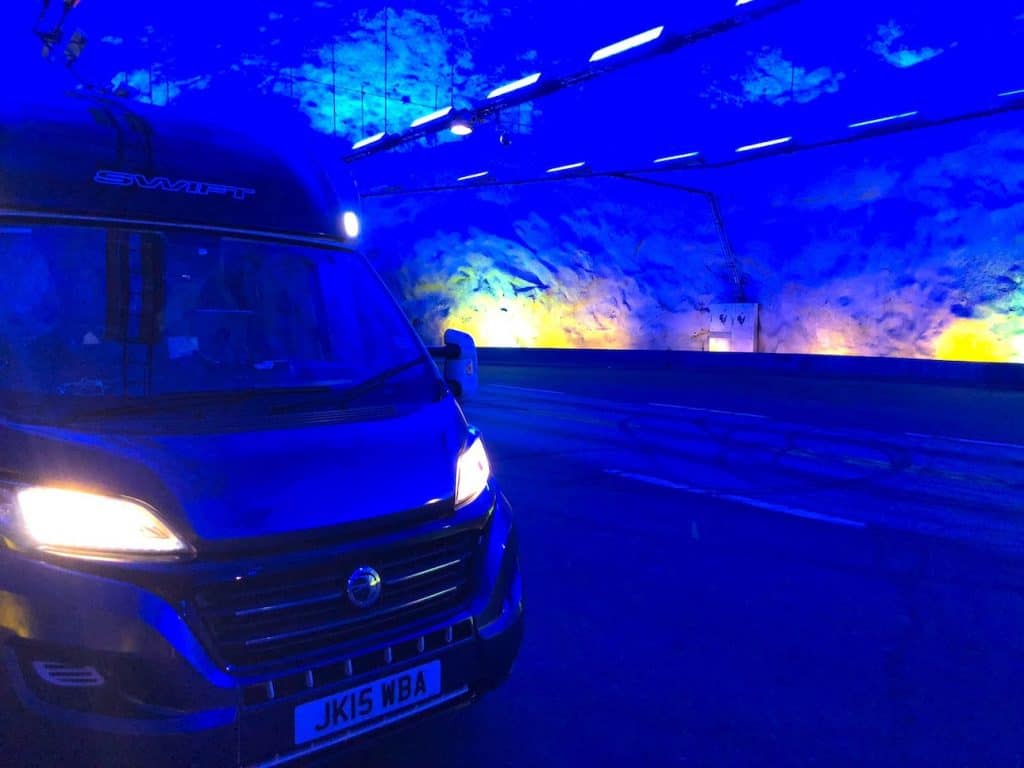
Petrol/ Diesel in Norway
Fuel prices in Norway are relatively high due to environmental politics. Fuel stations are fewer in the mountains and other remote areas, especially in Northern Norway. Fuel also gets more expensive the further north you go.
Unleaded is called Blyfri It’s often super (95) or Super plus (98) – Green handles on pump
Diesel is… Diesel Black or yellow handles on pump
Some places are 24h pay at the pump, but may require you to go into the shop and pay the cashier either in advance or after you’ve filled up- there will be a sign to tell you what to do. (Leave your car in front of the pump and make a note of the pump number.)
You can pay using cash or a credit card. Many places do NOT take American Express. You can usually use your UK cards without a problem.
LPG in Norway
There are more than one hundred LPG stations across the country. Some are manned, some are automated and self-service. Some closed at night or on Sundays, others are 24 hours. You can find them using the website LPGnorge.no
Some used the UK bayonet connector, others the dutch bayonet. Many stations provide an “adapter” that will work regardless of your motorhome’s system. You can bring your own adapter if you want to.
You can watch us refilling our LPG in Norway here:
If using the MyLPG.eu website, check when the stations were last confirmed as being open (many are no longer there.)
Note: There is NO LPG in Finland, so if you’re planning your motorhome trip to include that country, top-up before you enter.
Driving in Norway- what to do in the event of a road traffic accident
You should have a European Claim Form provided by your insurer before you leave. In the event of an accident, all parties complete and sign the form at the scene and then send a copy to your insurer for assessment.
What to do at the scene:
- Stop your vehicle immediately but safely- out of the flow of traffic if possible.
- If a vehicle is blocking the road, use hazard lights and put the red warning triangle 30 metres from the scene to warn approaching traffic
- Name and address of all the people involved in the accident
- Vehicle registration numbers of all parties
- Insurance company details of all parties
- Take photos of damage using a camera, GoPro or phone
For more details, read our step-by-step guide on dealing with a road traffic accident in Europe
Motorhoming in Norway- How expensive is it?
Norway is consistently rated as one of the top 3 most expensive countries in the world. Norwegians are well-paid, and also pay high taxes, but the general cost of living is crazy high.
If you’re motorhoming in Norway, the tolls, ferries, fuel and vehicle costs are offset by the lack of campsite costs (if you’re wild camping), but the biggest expense, apart from getting there, is likely to be food and drink.
If you’d like to see a complete breakdown of our motorhome trip to Norway, you can see exactly how expensive Norway is to road trip here.
Food and Drink in Norway
Food and alcohol are one of the most expensive things on any trip to Norway. One huge tip is to stock up in advance in Germany, Denmark or even Sweden. Remember the rules for taking alcohol across the border.
This is one of the biggest advantages to touring Norway with a motorhome or campervan- you can save a lot of money by taking and preparing your own food.
Norwegians love their food and have many local specialities. Seafood is always good, but you could find reindeer (reinsdyrstek), torsketunger (cod’s tongues), rakfisk (fermented trout) or a huge number of dried and cured meats and fish. Brown goats cheese (Brunost) is very common at meals.
Supermarkets/ shops in Norway
For the best prices in Norway, try and shop in the Spar or Co-op’s. There is no Lidl or Aldi in Norway (apparently, Lidl tried… and then gave up!)
Expect to pay at least double the amount you are used to in the UK for everything in a supermarket- even the local produce. Many stores have an ‘own brand’ which is slightly more reasonable- think Waitrose or M & S prices.
Most supermarkets and grocery shops do not open on Sundays. Garages will sell basic groceries (and hot dogs!) but at inflated prices!
All drinks (cans and plastic bottles) have a deposit (pant) on them- in addition to the price on the label. You can put them back into the machine inside the supermarkets and get the option of a voucher to spend or giving the money to charity.
Alcohol in Norway
Tax is charged on all alcohol with more than 0.7% volume of alcohol, making all alcohol expensive.
Beer can be found in most supermarkets, but is only sold before 8 pm on weekdays or 6 pm on Saturdays. For wine, spirits or strong beer, you must visit one of the Vinmonopolet outlets, found in most large cities and towns. To buy wine or beer in Norway, the minimum age is 18 years. For spirits, it is 20 years.
In a Vinmonopolet you will pay around NKR150 for a bottle of wine and NKR50 for beer and cider. Spirits cost considerably more.
Eating Out in Norway
I’ll be honest, the only eating out we did was pizza- and it was so good we had it twice! The prices of restaurant and takeaway meals is crazy- even a McDonalds can cost upwards of £10 for a meal. Burger and chips can be £25 per meal and a beer, cider or glass of wine in a restaurant will cost between NKR60-90.
More useful things to know when campervanning in Norway
Emergency Numbers: 112 will get you everything you need.
Language : Norwegian. English is widely understood and spoken flawlessly.
Currency : Norway uses the Norwegian Krone (NOK), NOT the Euro. Obviously, the exchange rate fluctuates, but as a very rough guide, 10 NOK is about £1.
Cards : most major credit and debit cards are accepted. American Express is only taken in large stores (not often at fuel stations)
Timezone : GMT+1 (or one hour ahead in BST) Norway is always one hour ahead of the UK, no matter what. Their clocks go forward and back whenever ours does.
Tipping – Tipping is not customary but always appreciated. It’s common to round the bill to the nearest 10NOK.
Touring Norway with a dog
Yes, you can take your dog into Norway. You will need to get a tapeworm tablet administered by a vet 1-5 days before arrival (just like when you return to the UK). And yes, you will need ANOTHER one to go into the UK after driving back through Europe.
Norway is pretty dog friendly. You must keep your dog on a lead when walking between 1 April and 20 August to protect wildlife. Apart from that, they are allowed almost everywhere, including on the beaches.
Using a drone in Norway
We love using our drone when we travel and Norway was wonderful for drone shots. Here are the regulations.
READ MORE: What’s the best travel drone (and how to choose)
Drones and similar remote-controlled flying devices must be kept at least a minimum 150m from people, vehicles and buildings that are not connected with the drone operator. Flying must happen in daylight only and up to a maximum height of 120m. Never fly closer than 5km to airports. The drone must always remain within the sight of the operator.
Please check for local regulations and military or other special restricted areas where all the aforementioned activities are forbidden by law. Read more about using drones in Norway on the Norwegian CAA website .
Other posts you might find useful:
- How much does it cost to road trip in Norway?
- Unmissable road trip ideas for Europe
- Essential motorhome checks to do before you travel
- The best logbooks to record and remember your road trip
See all our Europe motorhome travel tips and ideas
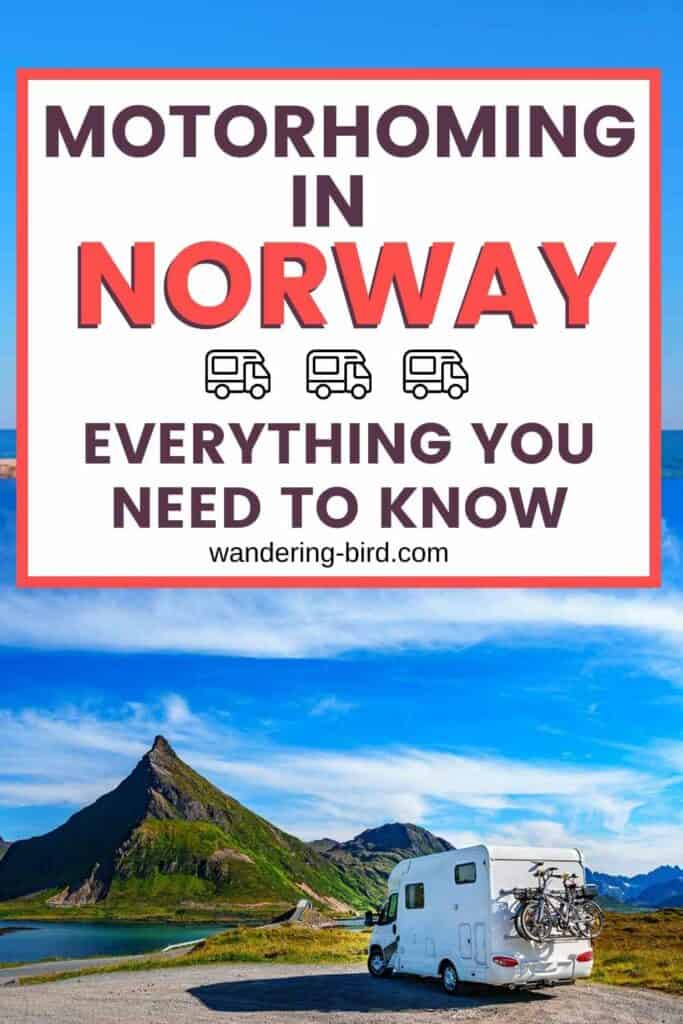
Kat never planned to buy a motorhome. She also never planned to quit her job as an air traffic controller, go touring around Europe in said motorhome, start one of the UK’s largest motorhome travel websites… or get a cocker spaniel.
Find out how she went from stuck in the rat race to being a digital nomad and inspiring thousands of people to have their own epic adventures here.
If you’d like to connect with Kat, send her an email or follow her adventures on social media.
Last update on 2024-09-09 / Affiliate links / Images from Amazon Product Advertising API
Sharing is caring!
Similar Posts
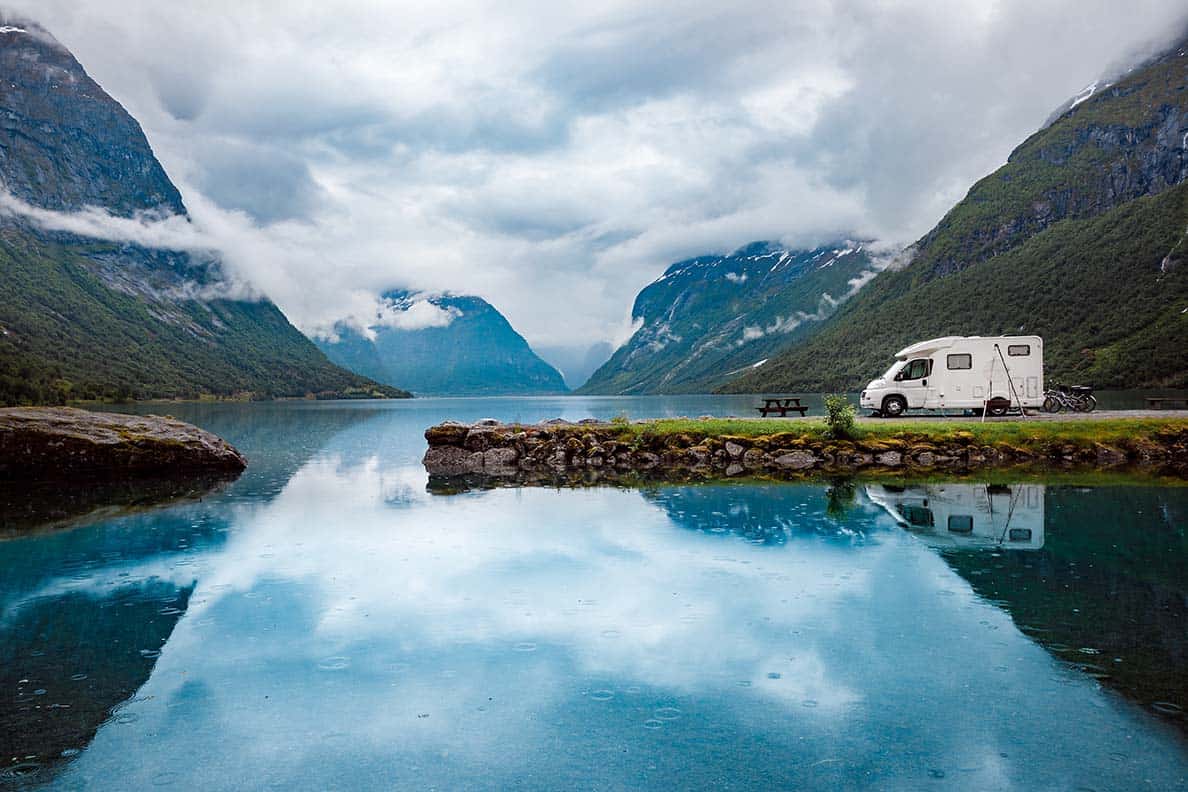
How to tour Europe in a Motorhome-the ULTIMATE guide
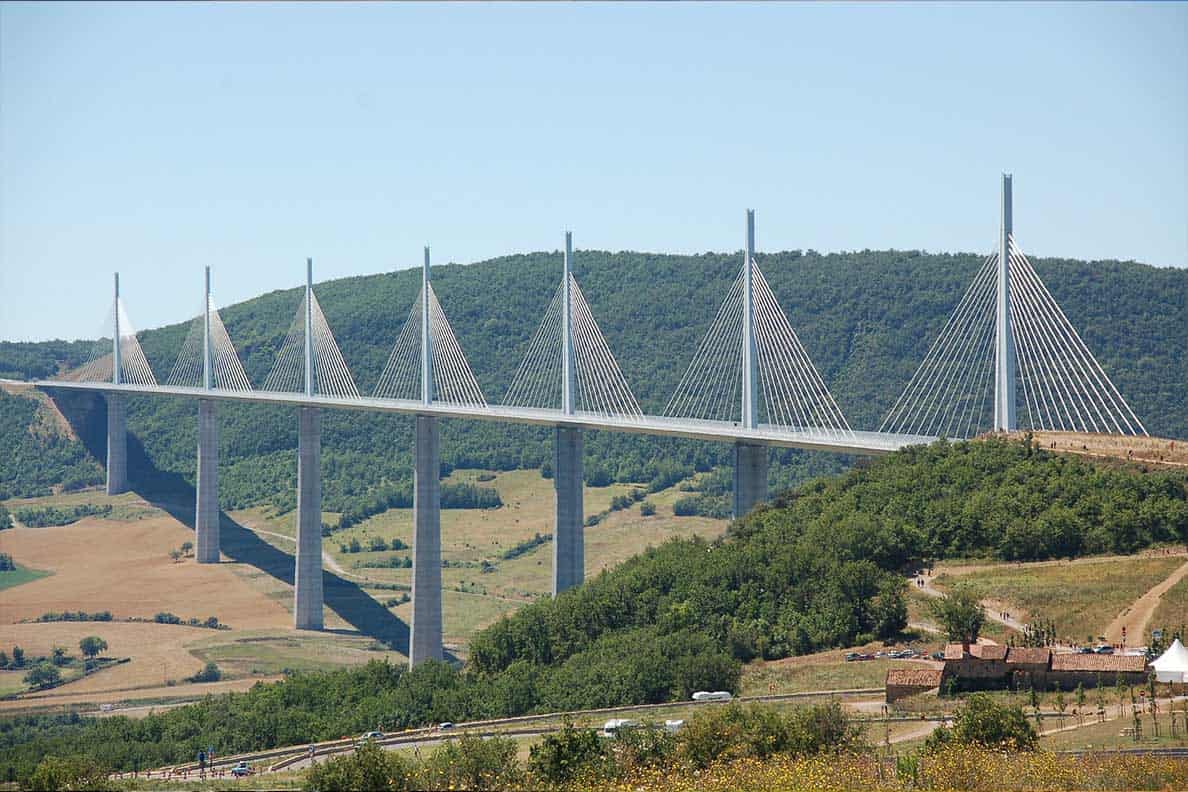
Crossing the Millau Viaduct in a Motorhome
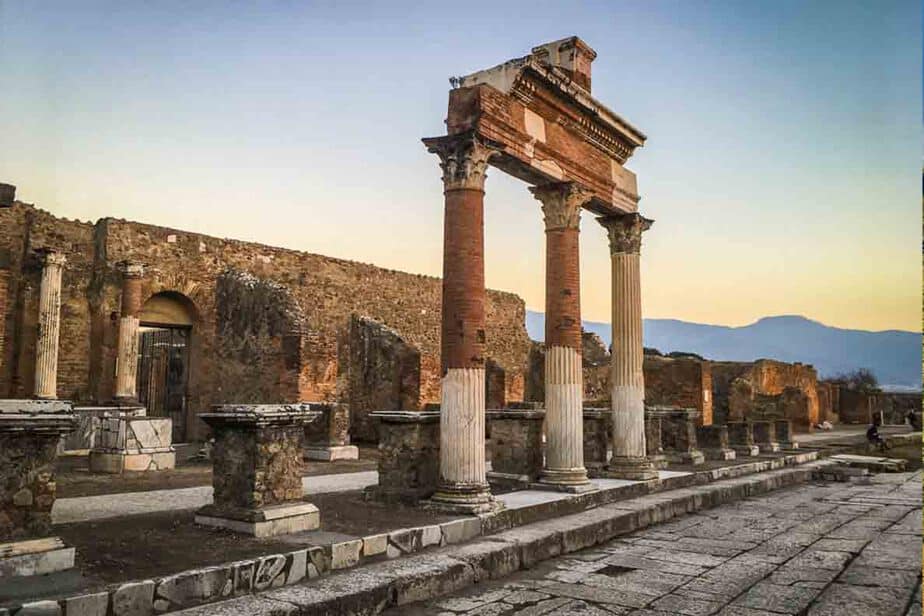
25 Unmissable European Cities to visit in Winter
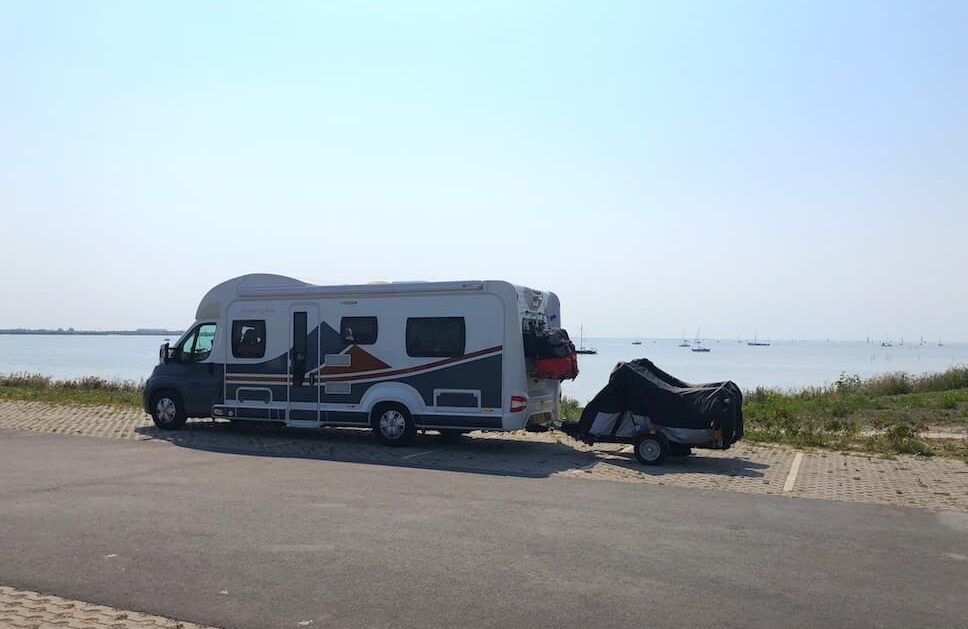
Motorhoming & Campervanning in the Netherlands- The Ultimate Guide
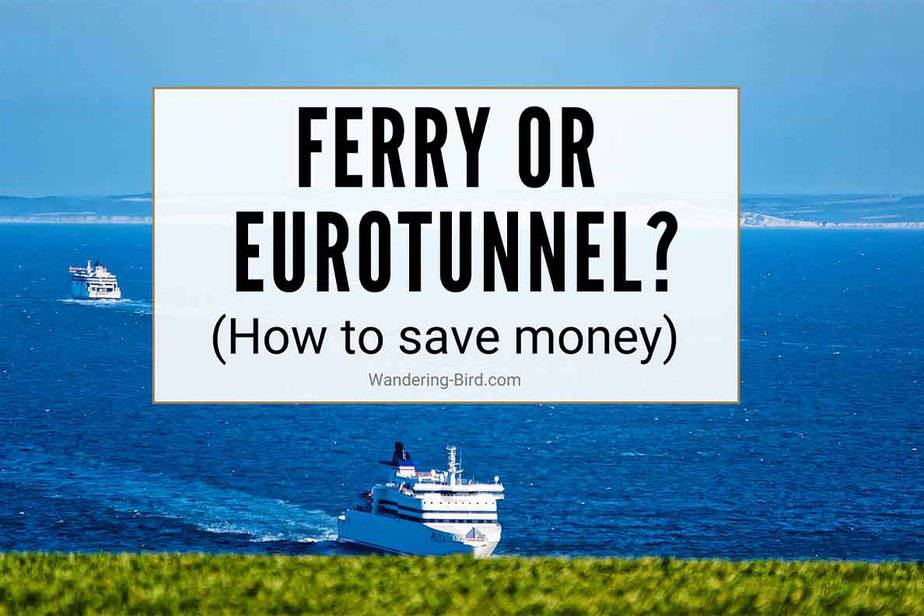
Ferry or Eurotunnel- which is best? READ THIS before you book
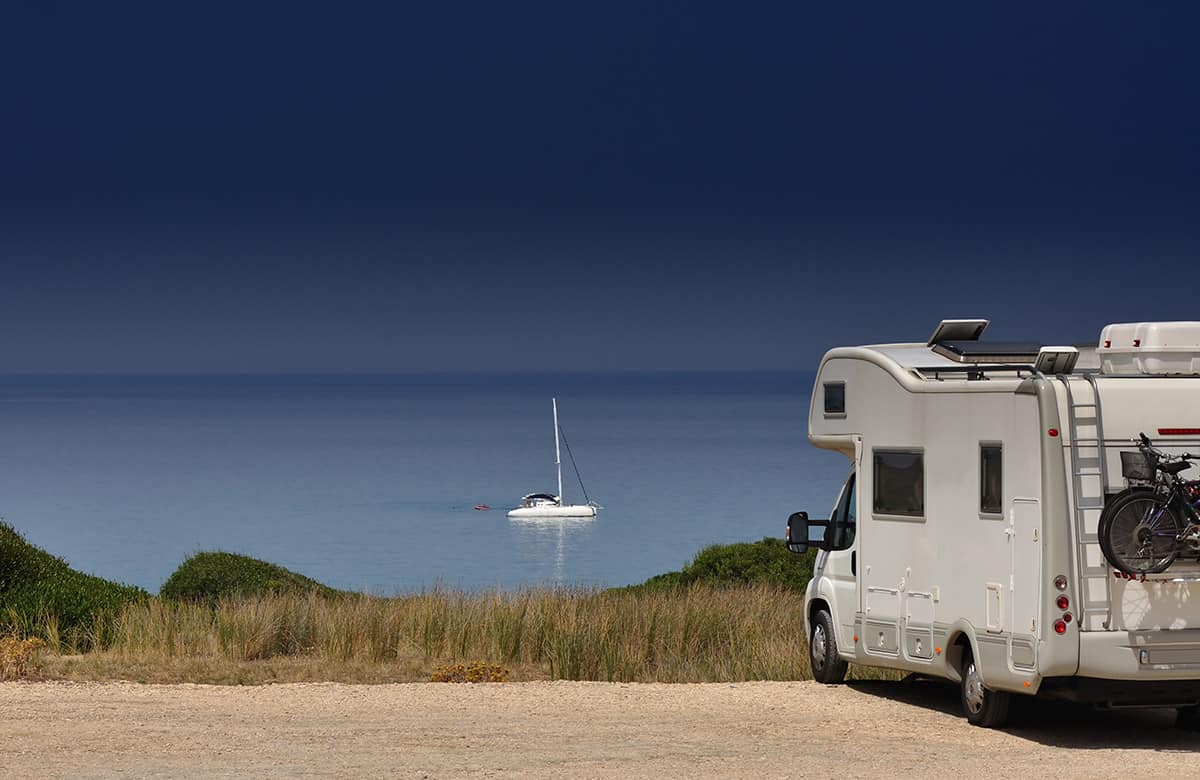
How to find free motorhome parking & overnight stopovers in Europe
Leave a reply cancel reply.
Your email address will not be published. Required fields are marked *
Save my name, email, and website in this browser for the next time I comment.
- New Blog Layout for 2014
- Work with Us
Scandinavia in a Motorhome 2011

Post a Comment
Thanks for this helpful blog. We'll be going that way sometime when we have a whole summer free!
Excellent blog, thanks for so much info. We will be first time RV users and heading for Sweden, so this has been invaluable to us, will bookmark and hope this is still on line next year.
Hi there. I don't suppose you have any information on how easy it might be to do a similar trip with a dog and on my own? Did you see many dogs on your trip or did you see lots of signs banning them from everywhere? Would you feel comfortable doing a trip like that on your own. Do you think I would end up speaking to no-one for days on end or did the locals and other travellers you met seem friendly? Many thanks - a very interesting blog.
Hi Jackie, I think Norway is one of the safest countries in Europe. I'm sure you won't have any problems on your own or with a dog! :)
WOW! Wish I had found this page when I researching to map our route for our Norwegian honeymoon last year! We rented a campervan (by the looks of it - same style as yours) and I mapped out a route t maximise what we could see in the space of 3 weeks. We travelled over 5000km in that time and feel head over heels in love with Norway. I'mcurrently in the process of doing up the blog, including maps of our route. Feel free to check it out at http://blog.allyeska.com I cant wait to explore your blogs in depth!
ps - we are from Australia and despite saving money however we could (we ate out twice in 3 weeks - once a cheap pizza lunch, and once a cheapish dinner on our final night and a roadside diner). We freedom camped mostly. And only did 2 organised tourist things - a hike on a glacier and a visit to the polar zoo. The trip still cost us more than our wedding. However, flights alone from Australia were $4,600! Motorhome hire was also $4000!!! Insanely expensive and cost of motorhome went up over $1000 in the space of 3 months from when I first checked, to when I booked. It even went up $160 from Friday to Monday despite being assured it wouldnt. This was a stupid motorhome booking company though and they w ere rude about these prices and their fluctuations which made no sense.
Janp we are planning to go in May thank you for the very helpful info and we will be taking the westie
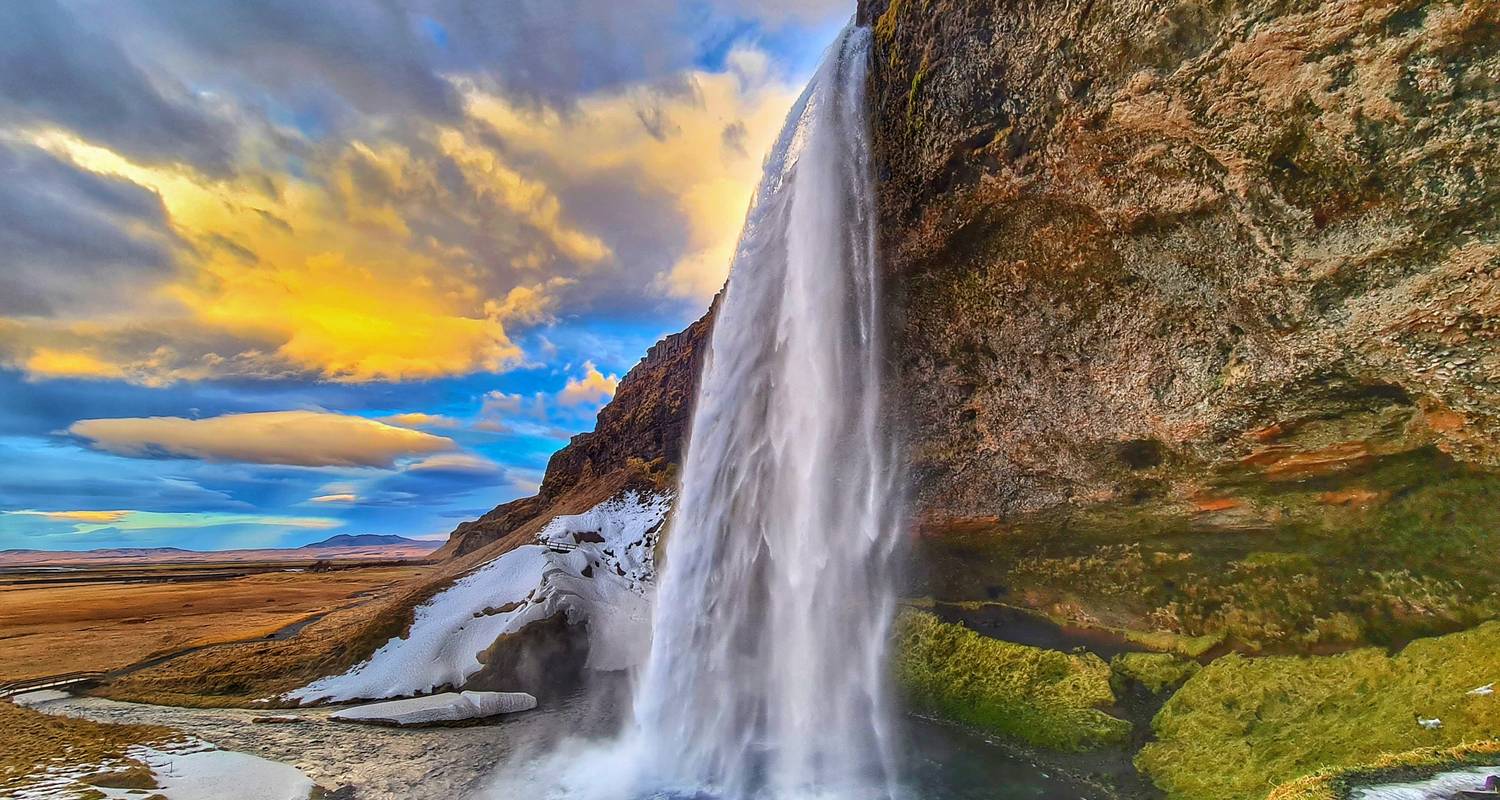
Self Drive Tours & Trips in Nordic / Scandinavia
- Choose from 100+ Nordic / Scandinavia tours
- 44 verified reviews from TourRadar travelers
- 24/7 customer support
10 best Self Drive Nordic / Scandinavia tour packages
Compiled by

Steff Nordic / Scandinavia travel expert at TourRadar
12 Days Self-drive | Everything you must see in Iceland Ring Road Tour
10 days self-drive | in-depth iceland ring road tour, 8 day self-drive tour | ring road highlights, 7 day self-drive tour | winter wonders and delicious detours, the highlights of north karelia, iceland expedition: northern lights, blue lagoon, and reykjavík | group tour and self-drive road trip, 5 day - fire & ice, self-drive tour helsinki - kuhmo with happy holidays memories, 11 days self-drive | ultimate iceland ring road tour, 12 days iceland ring road tour in a motorhome.
“This was a trip of a lifetime! It could not have been easier and I really appreciated that everything was arranged so perfectly in advance.” Deborah OLoughlin, traveled in June 2024

- Sightseeing
- Spot seals at Ytri Tunga beach
- Witness Jökulsárlón Glacier Lagoon
- Hike to Hengifoss waterfall
“Every question I had beforehand and during the trip was quickly responded to. Highlights were zodiac tour of lagoon, glacier hike and puffins.” Ann Scott, traveled in May 2024

- Pick up your car at Keflavik Airport
- Watch seals at Ytri Tunga beach
- Tour Snæfellsnes and see Kirkjufell
“They booked some amazing little hotels and Bed and Breakfasts that I'm not sure we ever would have known about.” Rita Cripe, traveled in April 2023
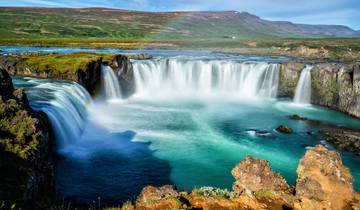
- Christmas & New Year
- Walk on black sand beaches near Vik
- Relax in the Blue Lagoon's soothing waters
- Watch whales from Husavik's famous shores

- Discover Snæfellsnes's diverse landscapes
- Explore Reykjavik's top culinary spots
- Visit Gullfoss waterfall and Geysir area
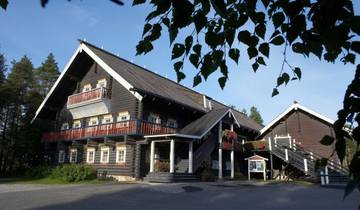
- Visit Koli's Nature Centre Ukko
- Raft through the Ruunaa rapids
- Discover Eva Ryynänen's atelier
“Exceptional hospitality and arrangements. Luxury and adventure at best.” Charul Saini, traveled in March 2023

- Relax in the Blue Lagoon's milky waters
- Drive a 4x4 across Langjökull glacier
- Visit the stunning Gullfoss waterfall

- Seljalandsfoss Waterfall
- The Golden Circle - Gullfoss, Geysir & Thingvellir
- Jokulsarlon Glacier Lagoon
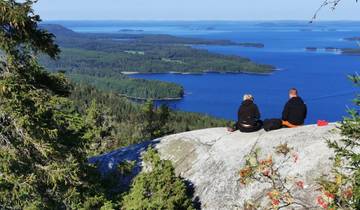
- Experience Karelian culture in Nurmes
- Explore Linnansaari National Park
- Stay at Tuhannen Tarinan Talo farmhouse

- Relax in the geothermal Blue Lagoon
- Tour the historic sites of Reykholt
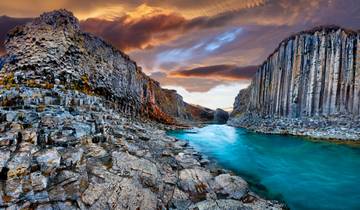
- Watch whales in Eyjafjörður Bay
- Hike to Svartifoss and visit Reynisfjara
More about Nordic / Scandinavia
Discover TourRadar

IMAGES
VIDEO
COMMENTS
Southern Norway and the fjords. This road trip through southern Norway starts and ends in Kristiansand, reached by ferry from Hirthals (Denmark) or by freeway past Copenhagen, Sweden and Oslo. The latter option does mean considerable extra travel time. This route is ideal for a fortnight's summer vacation. You will discover the most beautiful ...
Tour 2 - Scandinavia: Comfortable ferries, toll for the long suspension bridges. Tour 3 - UK & Ireland: Comfortable ferries to and from France to England and to and from Ireland. Tour 4 - Greece: Cruise the Adriatic Sea to and from Greece on comfortable ferris (overnight including inside cabin) and to and from Mykonos Island.
Embark on a breathtaking Scandinavian road trip with our comprehensive guide. Explore Denmark and Sweden's captivating landscapes, understand the importance of weather prep, savvy navigation tips, and embracing Nordic lifestyle. Learn about wild camping etiquette and enjoy serendipitous travel moments.
Travel to Scandinavia in your motorhome - here, the Christianshavns Kanal meets the harbour in the beautiful city of Copenhagen All the capital cities in this region are magnificent and the Danish capital Copenhagen is no exception Enjoy another view over Copenhagen - a stunning city and holiday destination ...
Our grand Sweden circle tour - Motorhome trip, road trip. This grand circle tour leads you from Gothenburg to Lake Siljan in Dalarna and then over to the east coast, where you visit Stockholm. The route is approximately 1,800 km long. You can either begin your journey in Gothenburg or in Helsingborg - depending on which ferry you take and ...
A lot of motorhome owners dream of a motorhome trip through Scandinavia. The extensive forests, untouched nature and gorgeous coastline make Scandinavia a dream destination. So, if you get the chance to visit Scandinavia, you should definitely take it! ... Motorhome tour in Normandy: the ideal mix between culture and nature! 05 July 2024 Bo van ...
Explore the Scandinavian kingdoms on our exciting RV tour through the land of the midnight sun and legendary Vikings. Denmark is known for its moated castles and Viking relics, Shakespeare's 'Hamlet' Castle Kronborg, wonderful Copenhagen with its cobblestone streets, and its tidy villages. In Sweden, we travel through dense forests, see glassblowers at work, and
Denmark: a Scandinavian paradise with more than 400 islands. It doesn't matter if you prefer to discover new cities or be active in nature, it's all possible during a motorhome trip in Denmark. Of course the capital Copenhagen should not be missed. This city is full of color and has something for everyone. From old buildings with a rich history ...
Scandinavia by motorhome -A motorhome tour of Denmark, Sweden and Norway, based on their three capital cities of Copenhagen, Stockholm and Oslo. The first thing you have to be aware of is Scandinavia is not cheap and it progressively gets more expensive as you travel from Denmark through Sweden to Norway. Diesel, however, tends to be cheaper or ...
How to travel in Norway with a motorhome or camper van
European Motorhome Tours Start Page. Guided RV tours through Europe and the British Isles. Truely experience the diverse European cultures, history and food. 24 years of fun filled tours and great memories! Travel with the experts with hundreds of happy customers. Let us make your overseas motorhome adventure the trip of a lifetime!
Southern Norway. 7th - 30th June 2024 (23 nights)pdfdownload. About. Itinerary. Price. Optional Extra Package. Oslo, Bergen, Flam and Beyond. Join us for a tour of Norway - a land of scenic and cultural wonders with so much to experience and enjoy. This tour will take you to the cities of Oslo and Bergen, to the pristine landscapes of Norway ...
Motorhome stopovers in Sweden. With more than 430 camperstops, Sweden is the country to go on a tour with a motorhome. Especially in the south of the country, there are many campervan sites, but also in the north you can easily move around with a motorhome. The capital Stockholm, for example, is a good place to travel by motorhome.
2. Road trip on Bornholm for 7 days. 3. Road trip in Denmark for 2 weeks. 4. Road trip in Denmark for 3 weeks. 5. Final words before your Denmark tour. If you decide to take a road trip through Denmark, this lovely Scandinavian country, you'll travel along picturesque coastal roads to charming towns and breathtaking natural landscapes.
Motorhome & Campervan Rental Norway. Flying and hiring a motorhome is the best way to tour Norway if you don't own one. Our recommended Norway campervan rental company is Motorhome Republic, which has depots in Oslo, Bergen, Tromsø and many other major Norwegian cities - perfect starting points to see all the best bits as you road trip Norway.. An aggregate motorhome and campervan booking ...
Scandinavia and Finland by camper - on the road again! 2. März 2023. Visiting Scandinavia in your own camper, mobile home or trailer is a great way to get around in the Northern countries. Sleep in front of Santas doorstep, experience the wilderness with the comfort of a solid mobile shelter or go all the way to the end of the road in Finnmark.
Motorhoming & Campervanning in Norway - Wandering Bird
Scandinavia in a Motorhome 2011. We've now been 82 days on the road and have travelled what seems an incredible 8,000 miles from home in the UK to our present location here in Tallinn, Estonia. From here we will continue south but this seems a good point to stop and reflect on the trip so far and to summarise the Scandinavian leg of our trip.
Self Drive Tours & Trips in Nordic / Scandinavia 4.5 stars on (6,694 reviews) Anytime September 2024 October 2024 November 2024 December 2024 January 2025 February 2025 March 2025 April 2025 May 2025 June 2025 July 2025 August 2025 View Tours
Scandinavia. 🇩🇰 From City to Beach; 🇳🇴 High mountains and deep fjords; 🇳🇴 Norwegian West Coast and Lofoten; Other countries. ... Motorhome stopover. Service area. Price maximum. €0 - €51. 0. 0. 51. 51. My travel period ...
10. Maxim Seleznev - Private Guide in Krasnodar. City Tours • Cultural Tours. 11. Sweet Dreams Studio. Nature & Wildlife Tours. Open now. 12.
Southern Comfort Tours. Private and small group tours in Krasnodar, Sochi, Crimea and Rostov-on-Don. Cultural and sightseeing tours in Sochi, Krasnodar, Anapa, Gelendzhik Wine Tours to the Black Sea vineyards, visit of the Russian Champagne House Abrau-Durso. Eco-tours and countryside living tours. Winter Tours to Sochi, Krasnaya Polyana ...
I am planning to visit Krasnodar in September and then travel onto Simferopol, is safe to visit these two places? Report inappropriate content . 1-5 of 5 replies Sorted by. 1. MuscoviteVT. Moscow, Russia. 6,402 posts. 636 helpful votes. 1. Re: Safety for foreigners in Krasnodar .